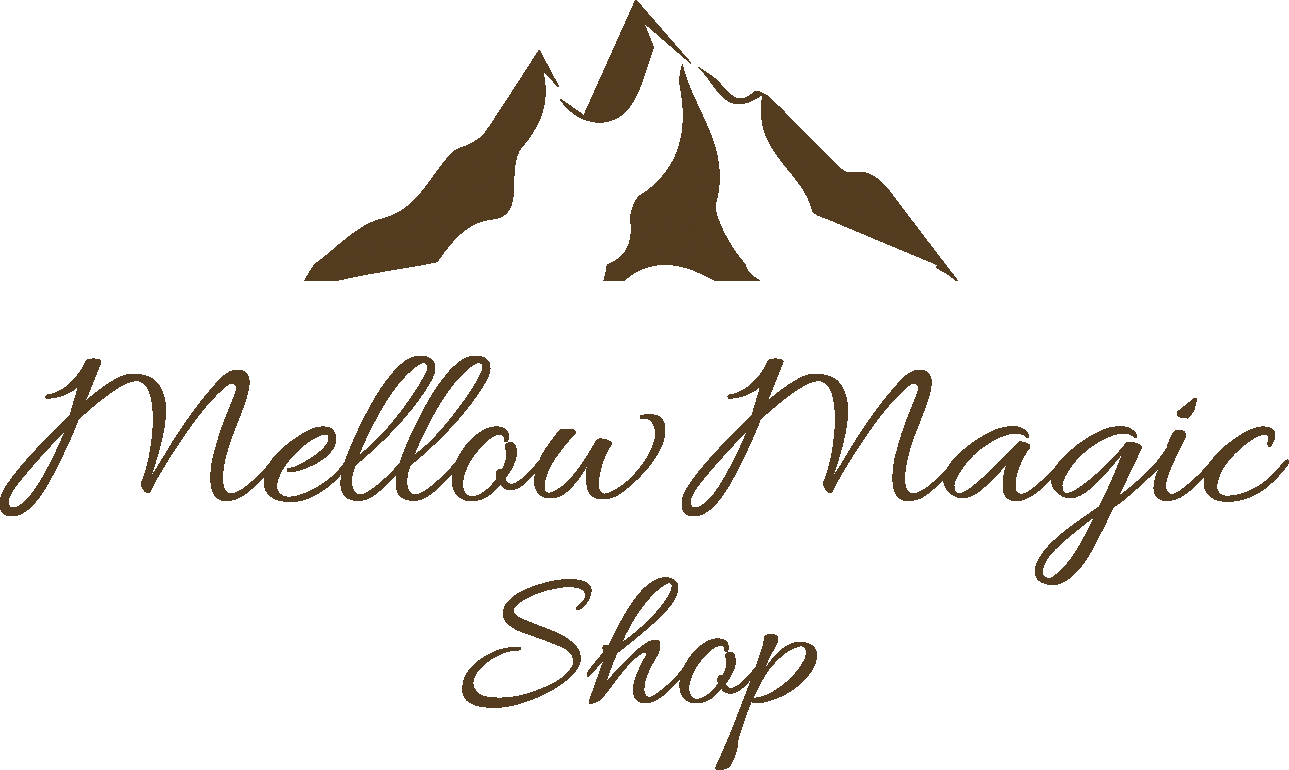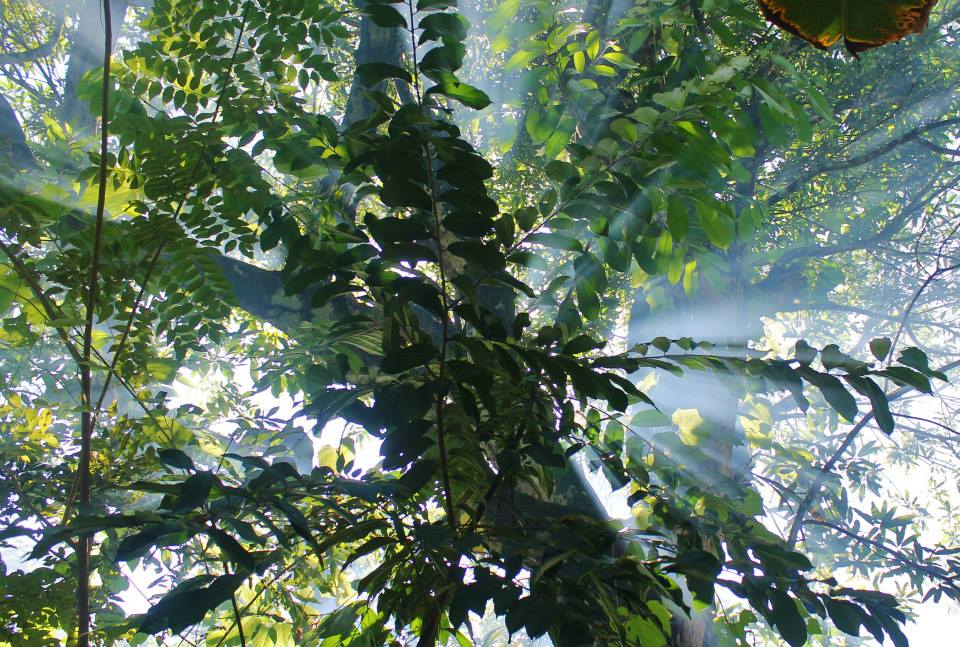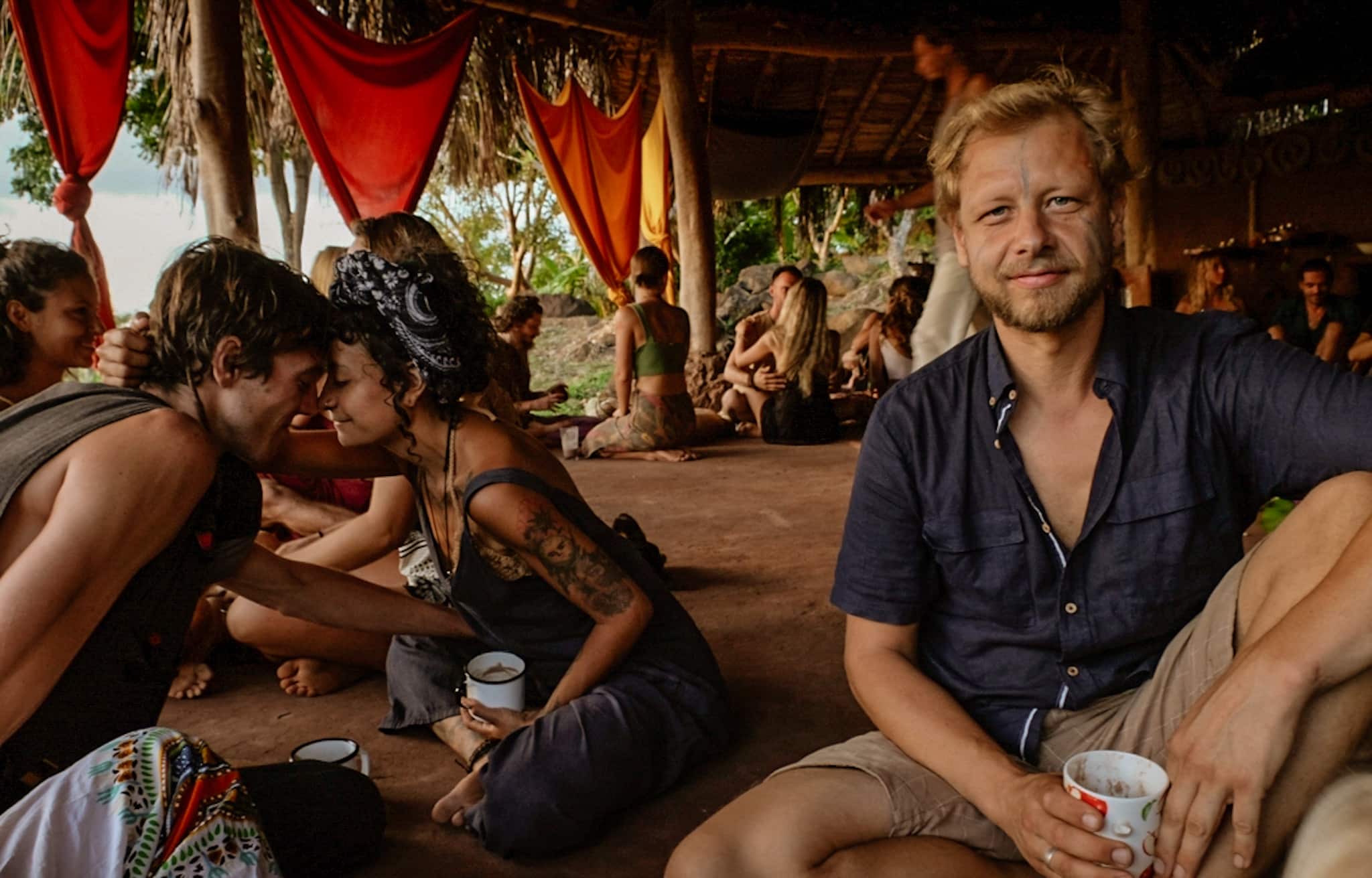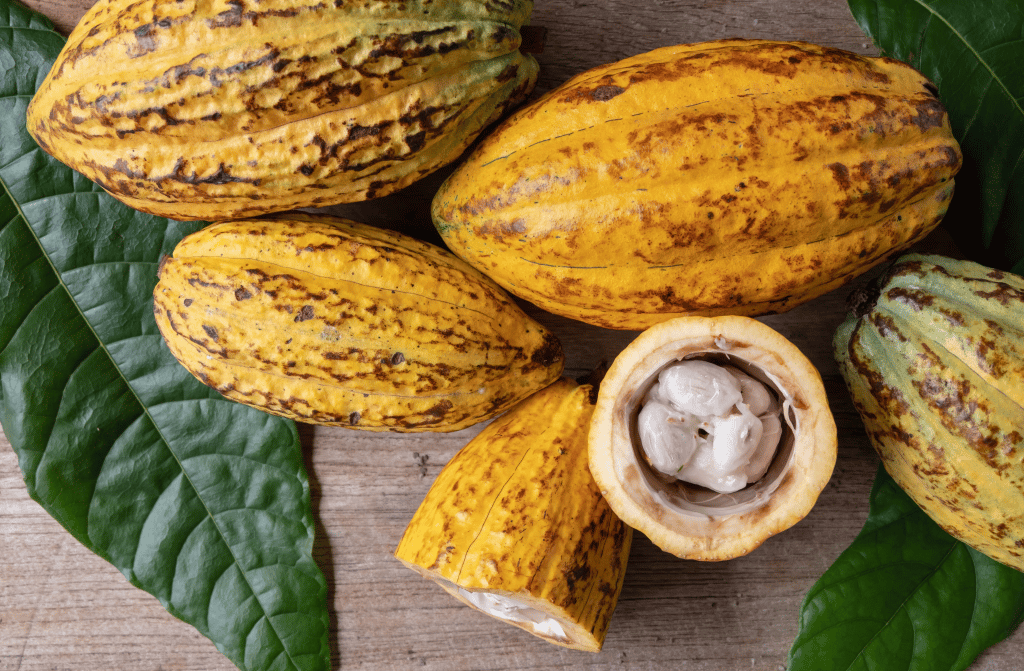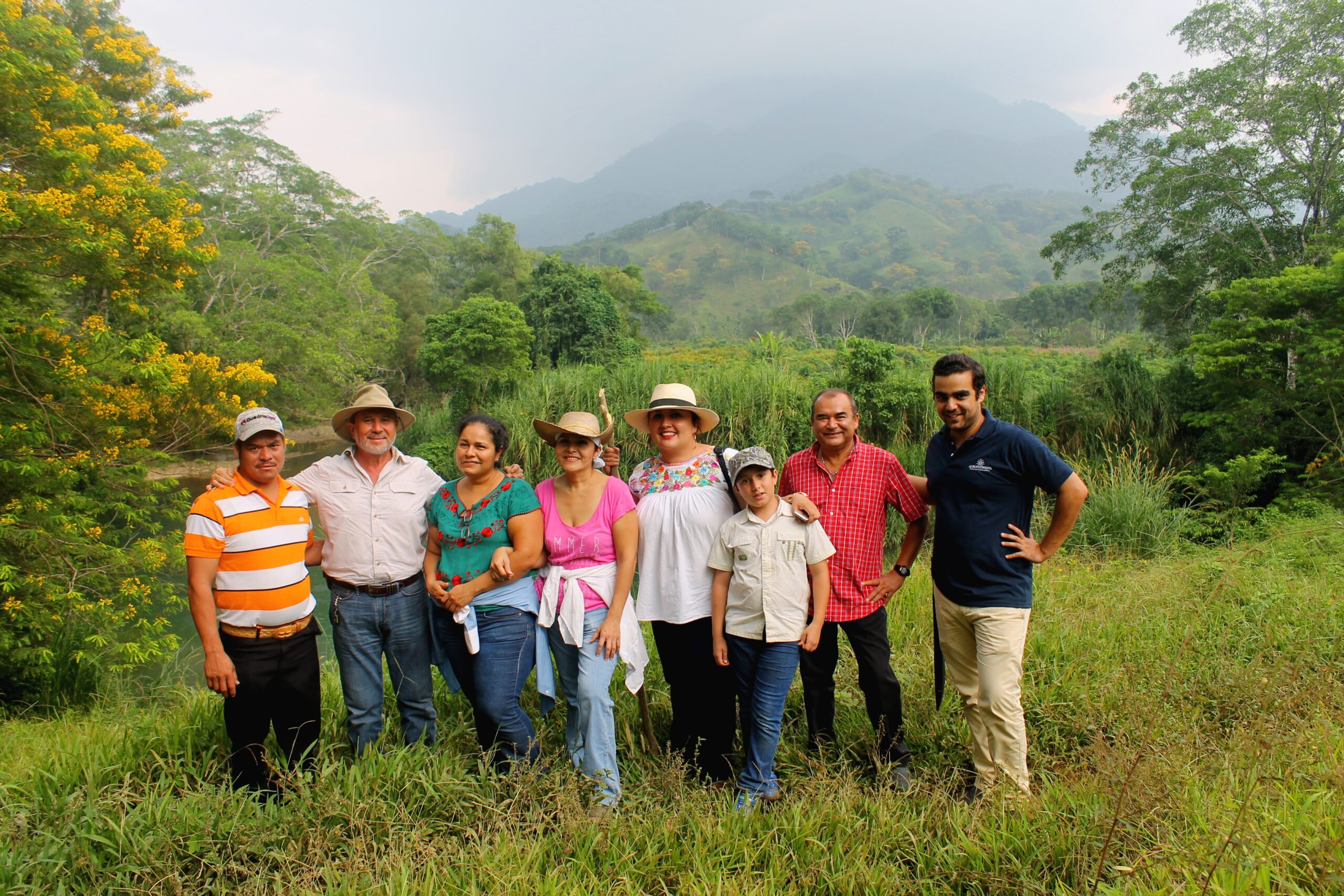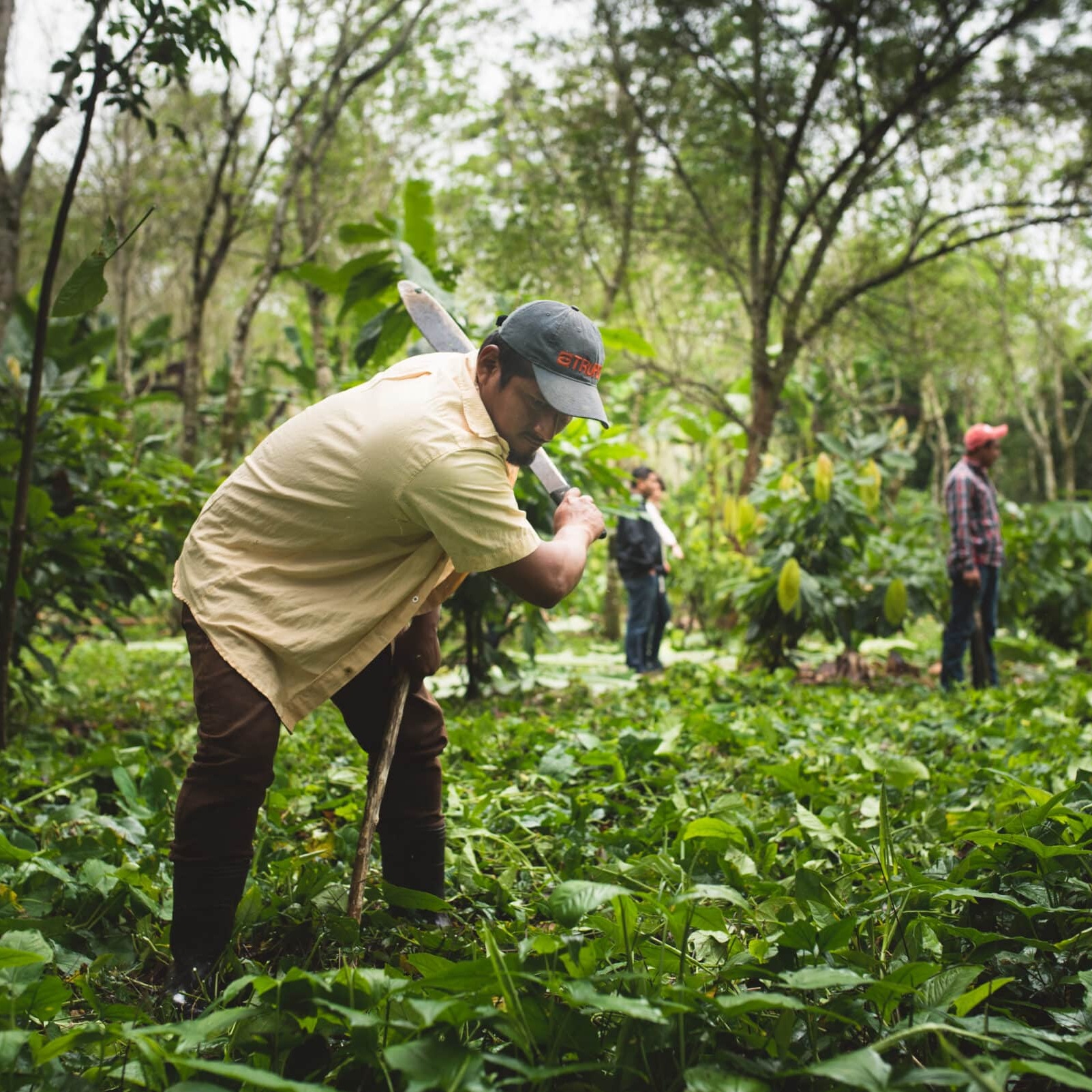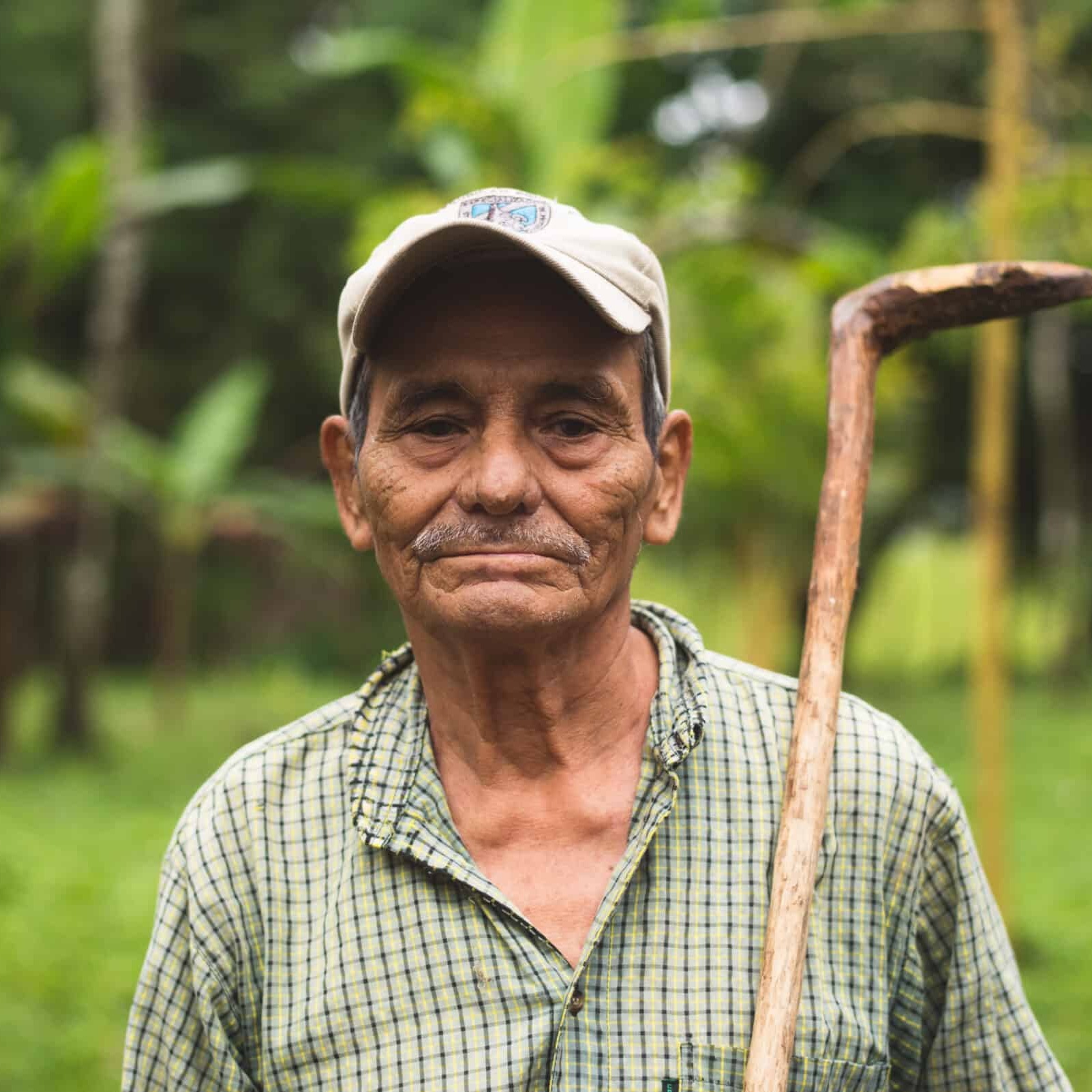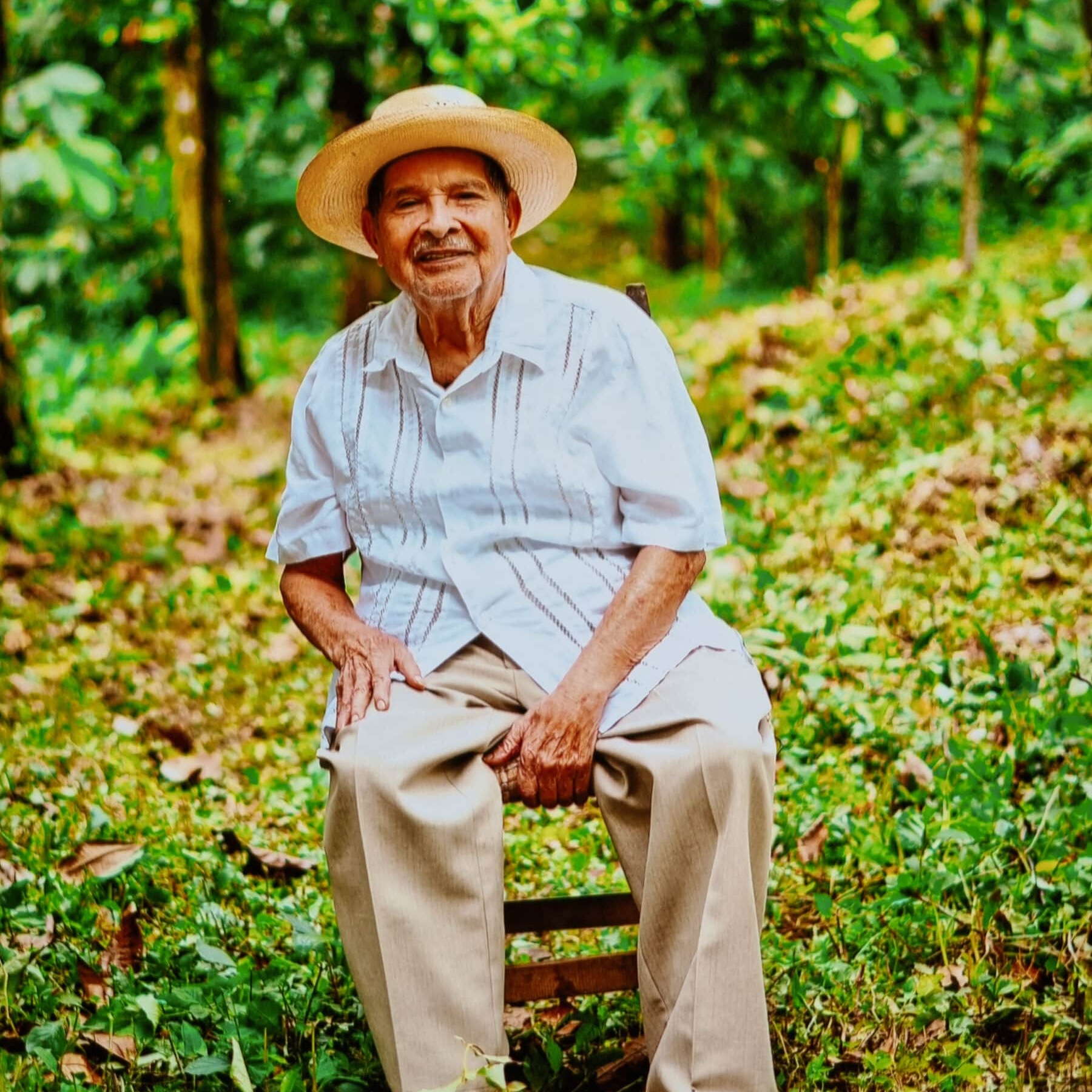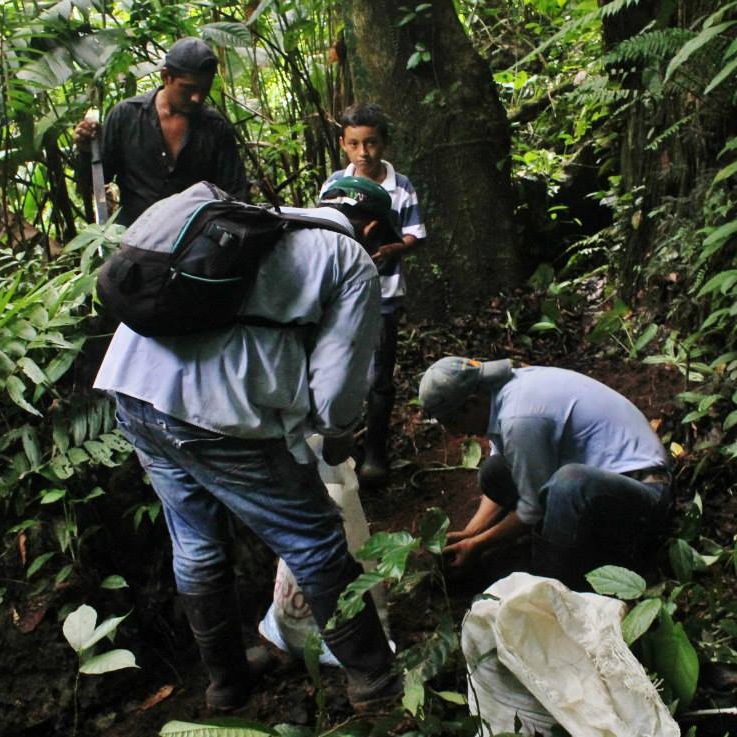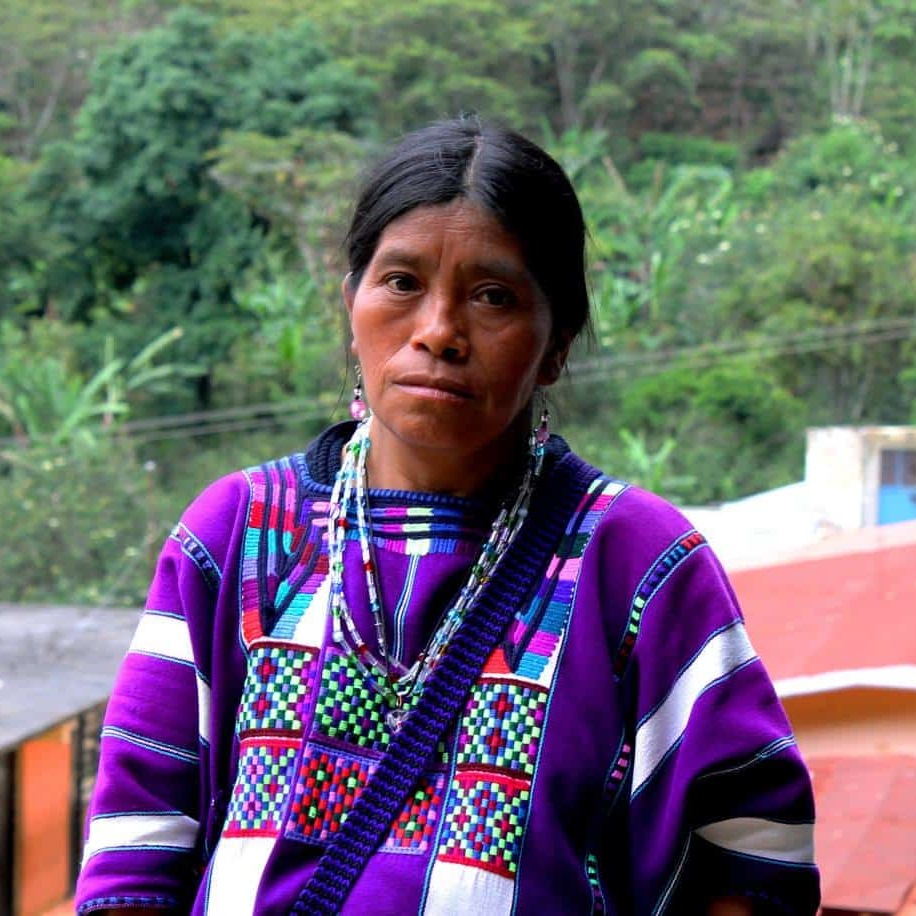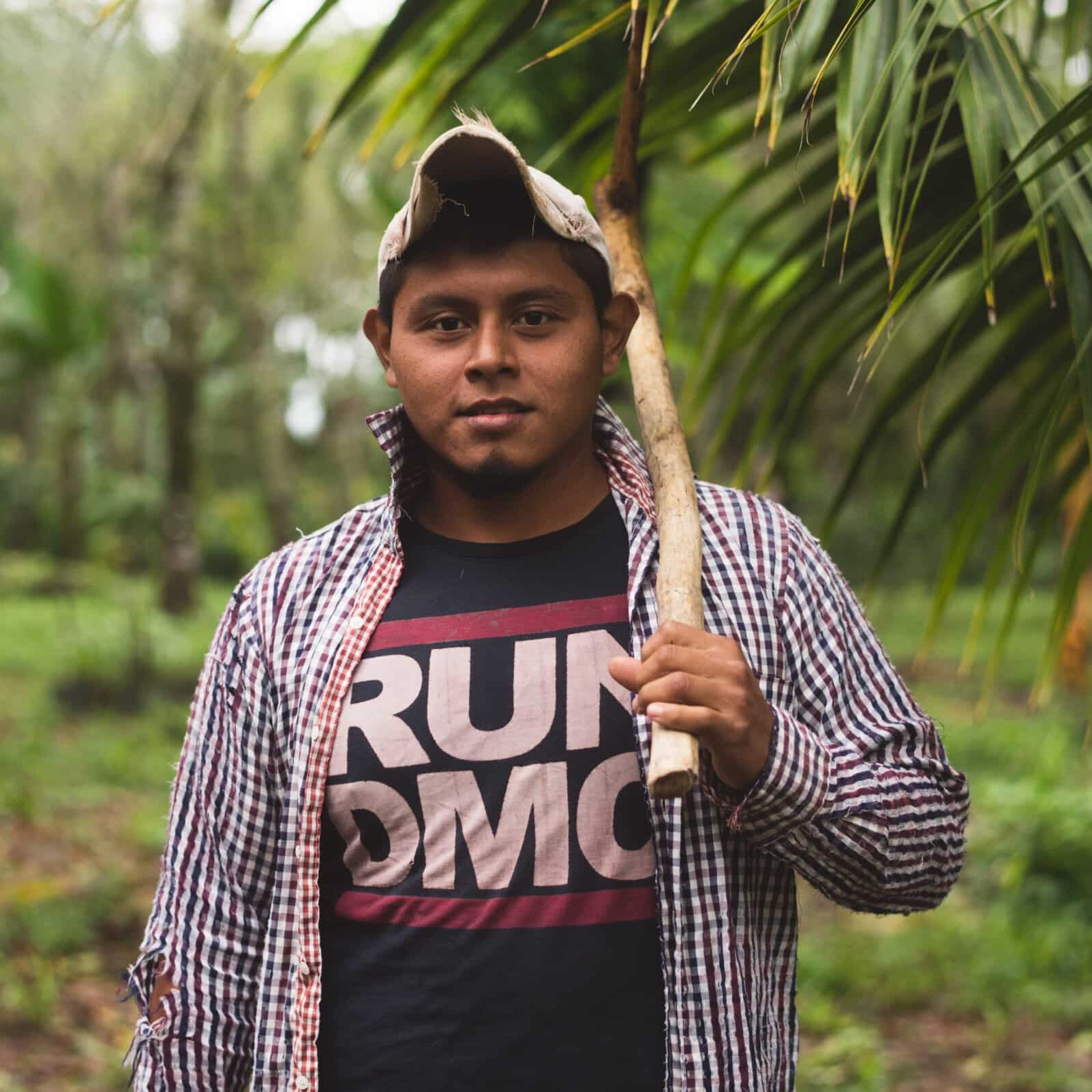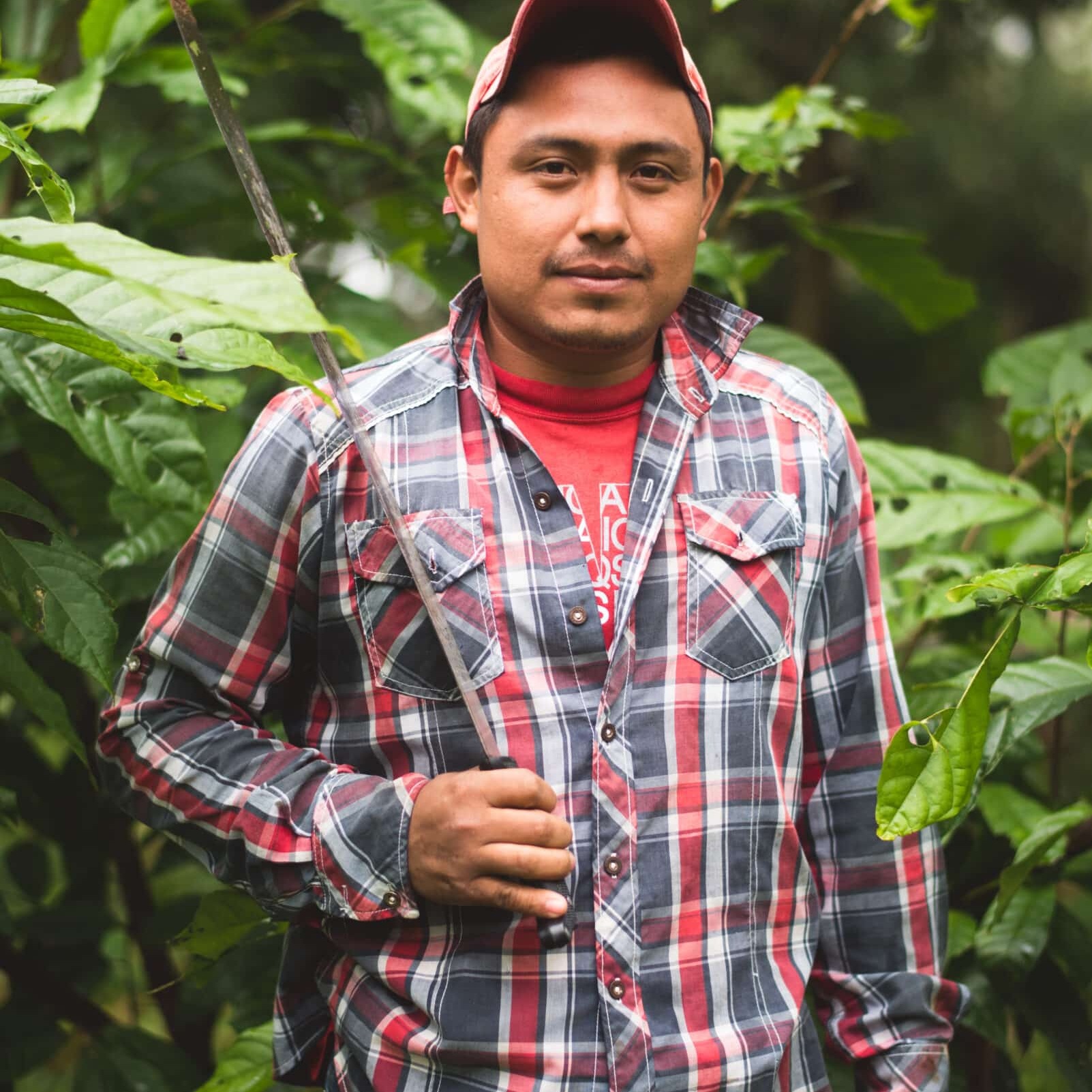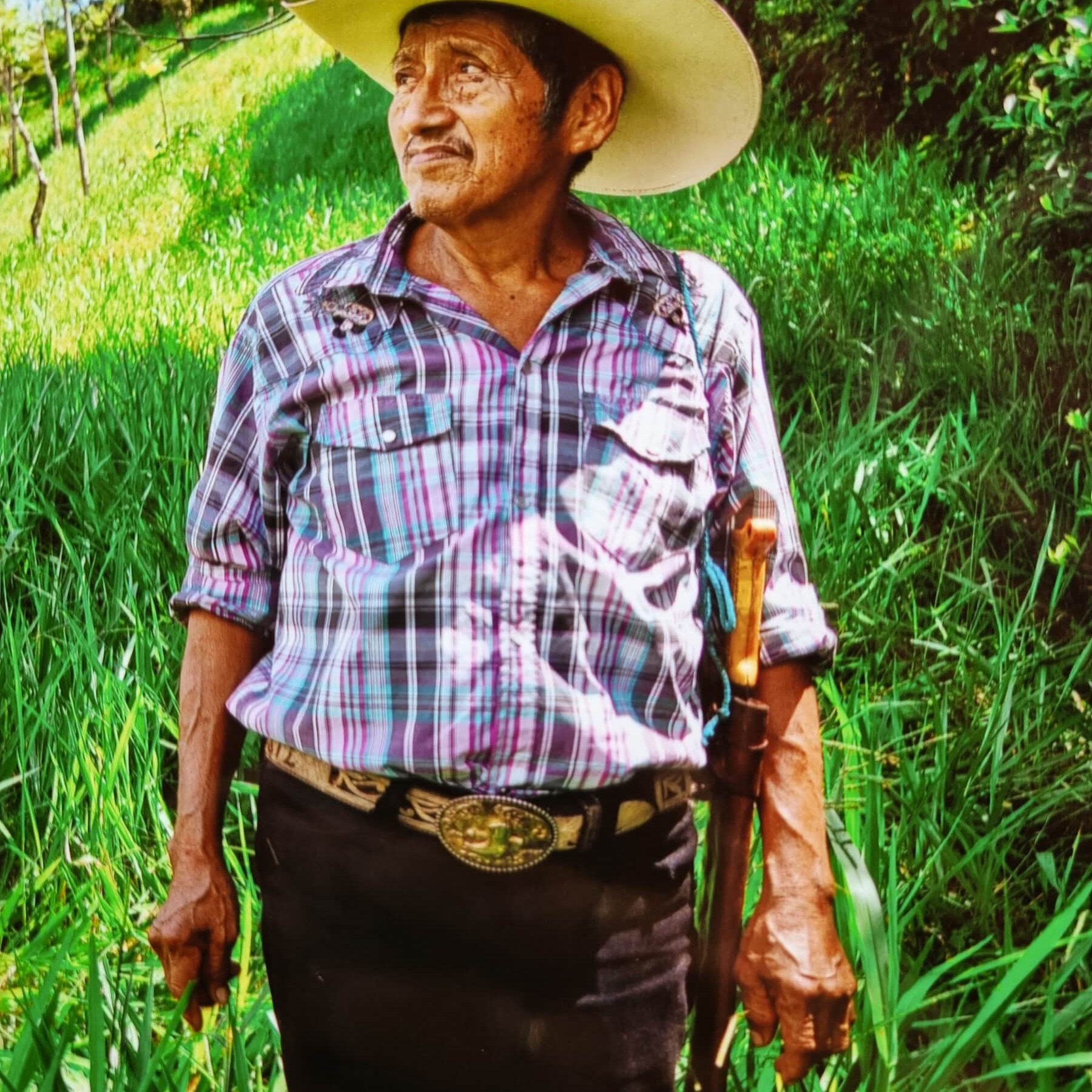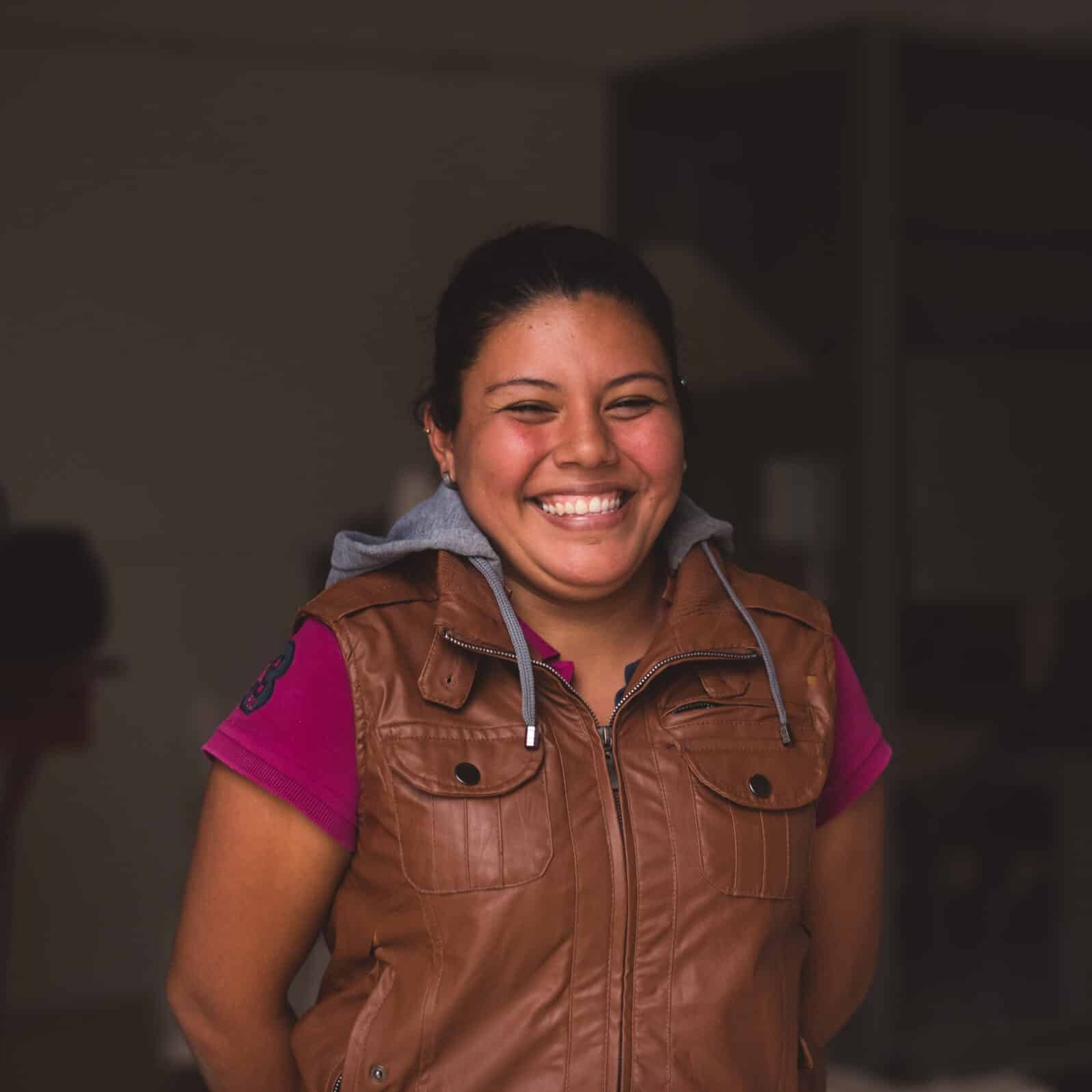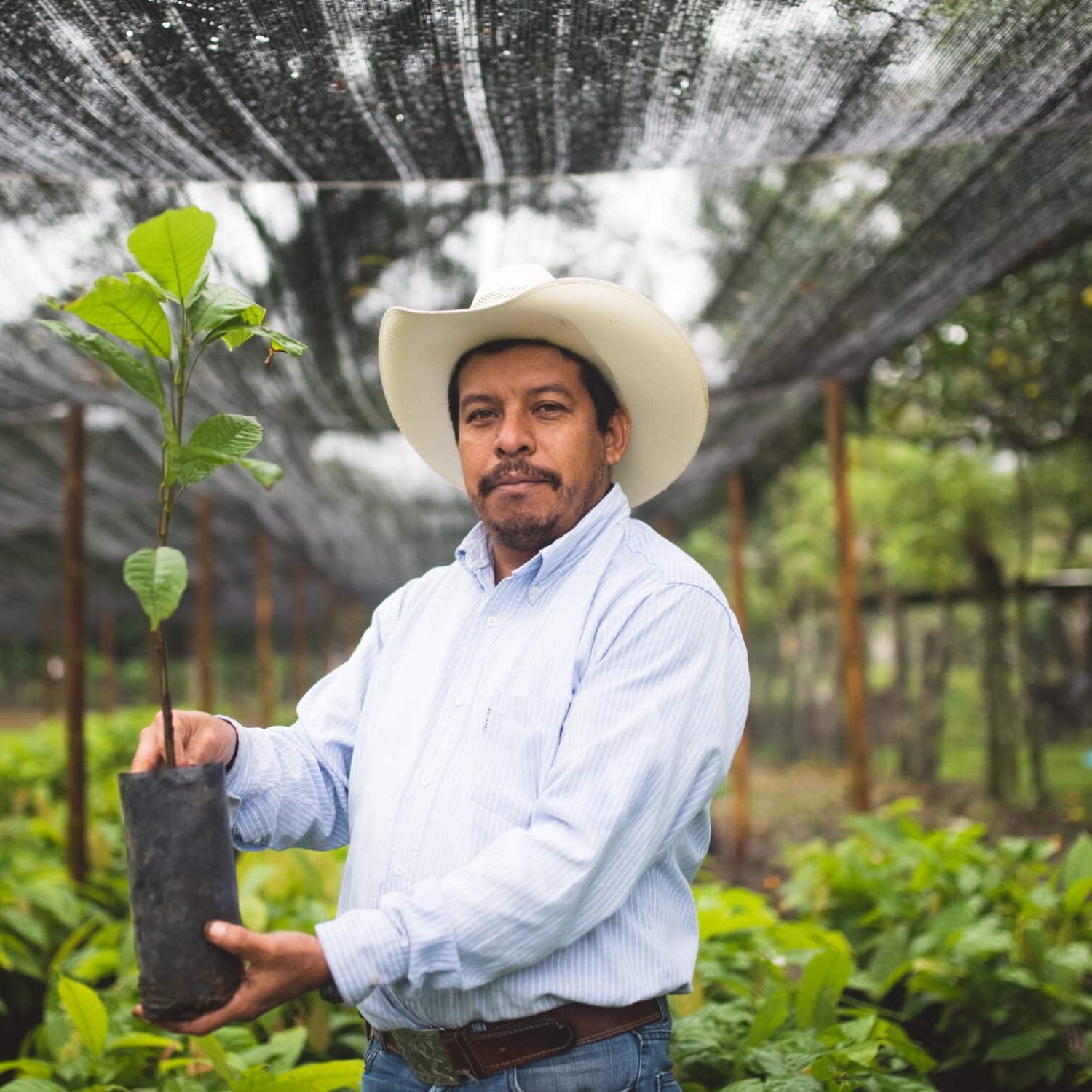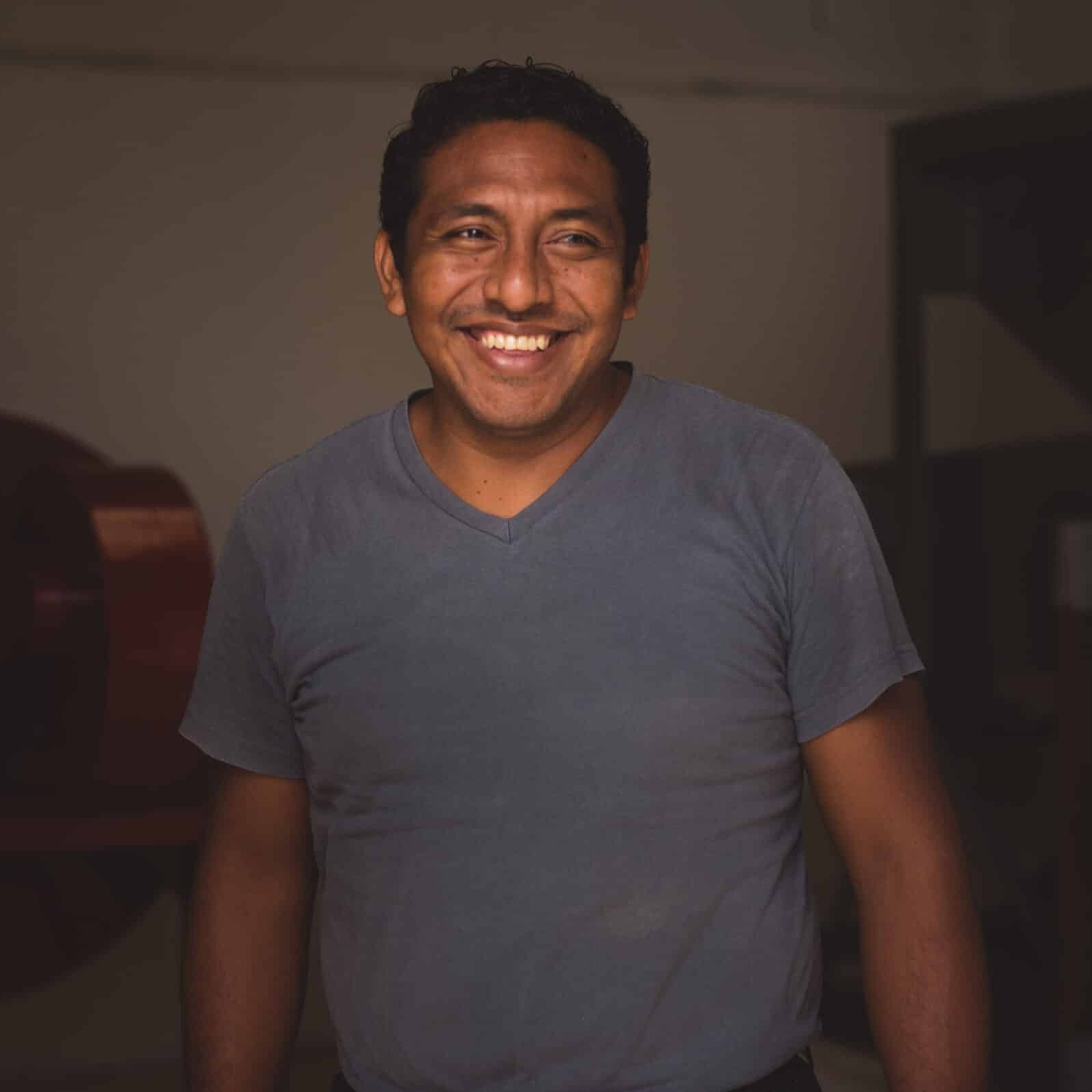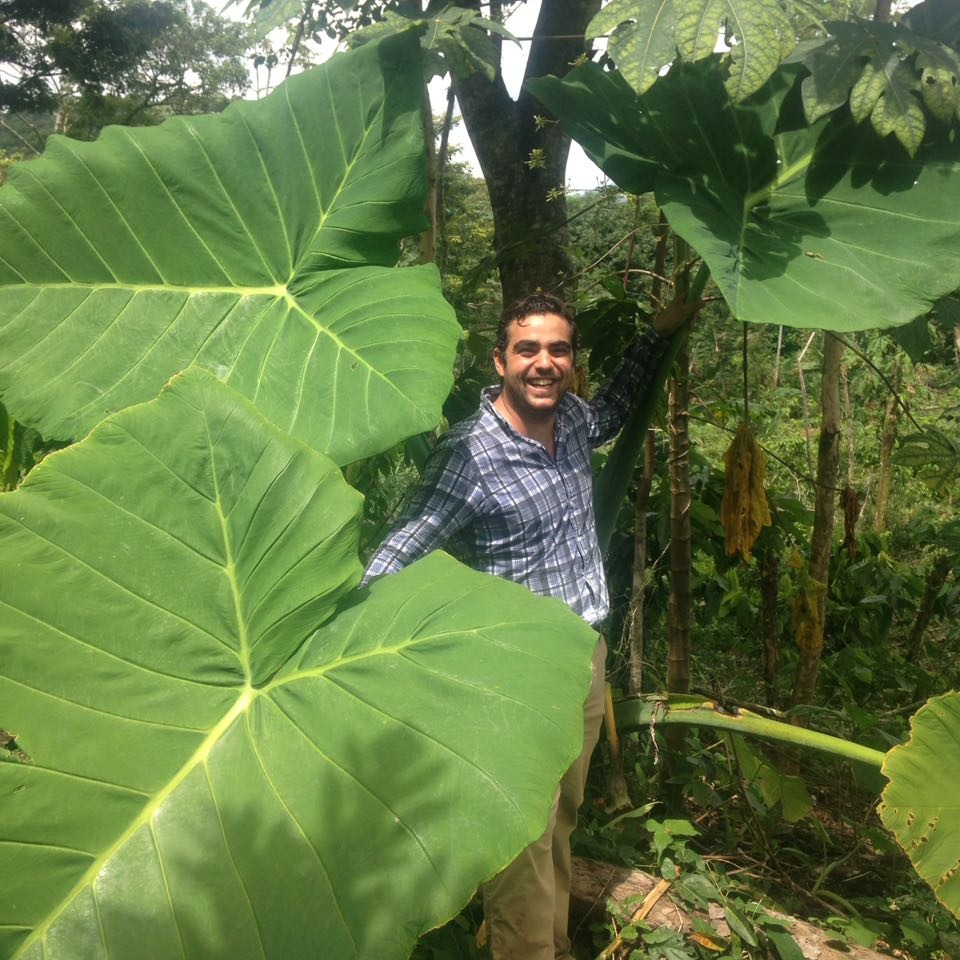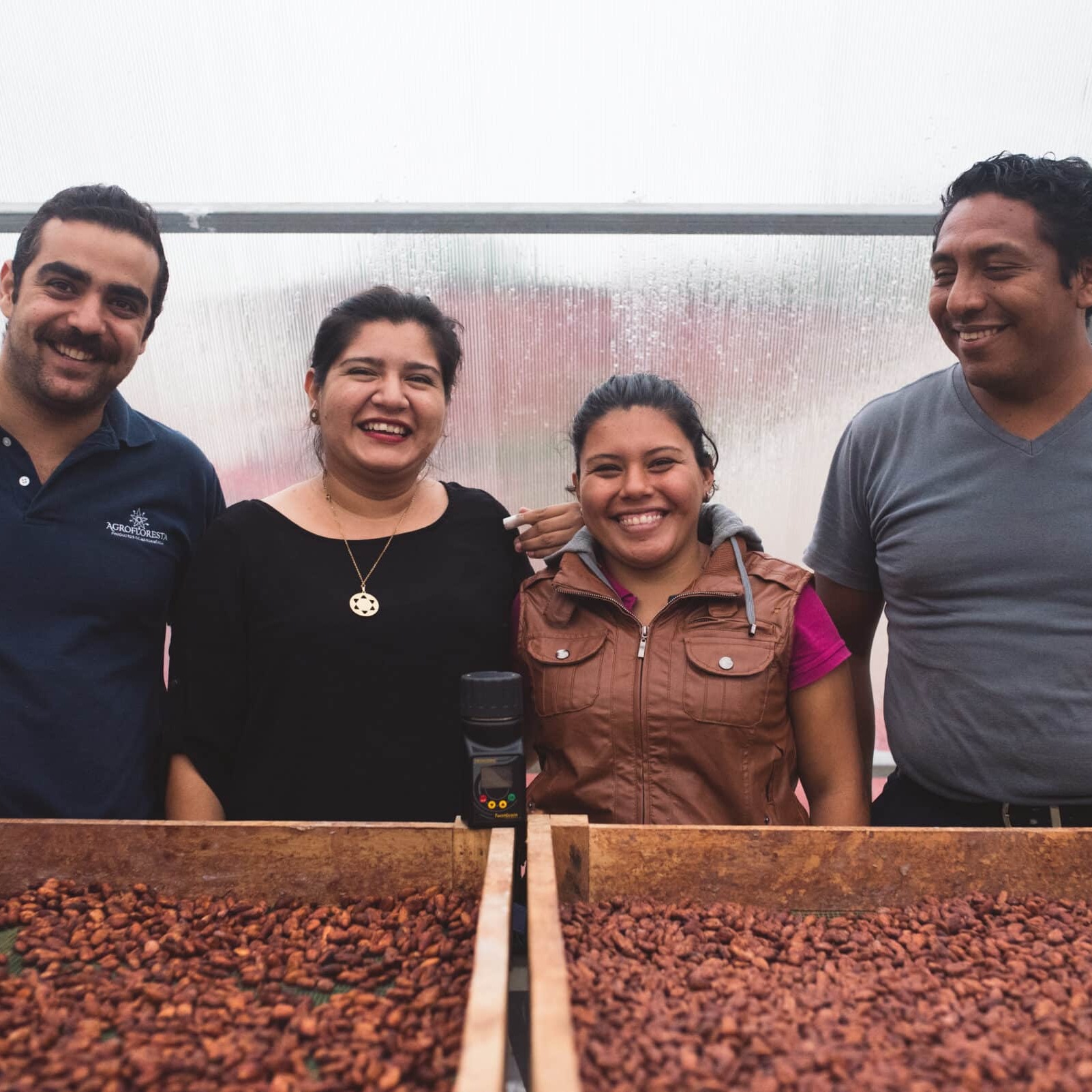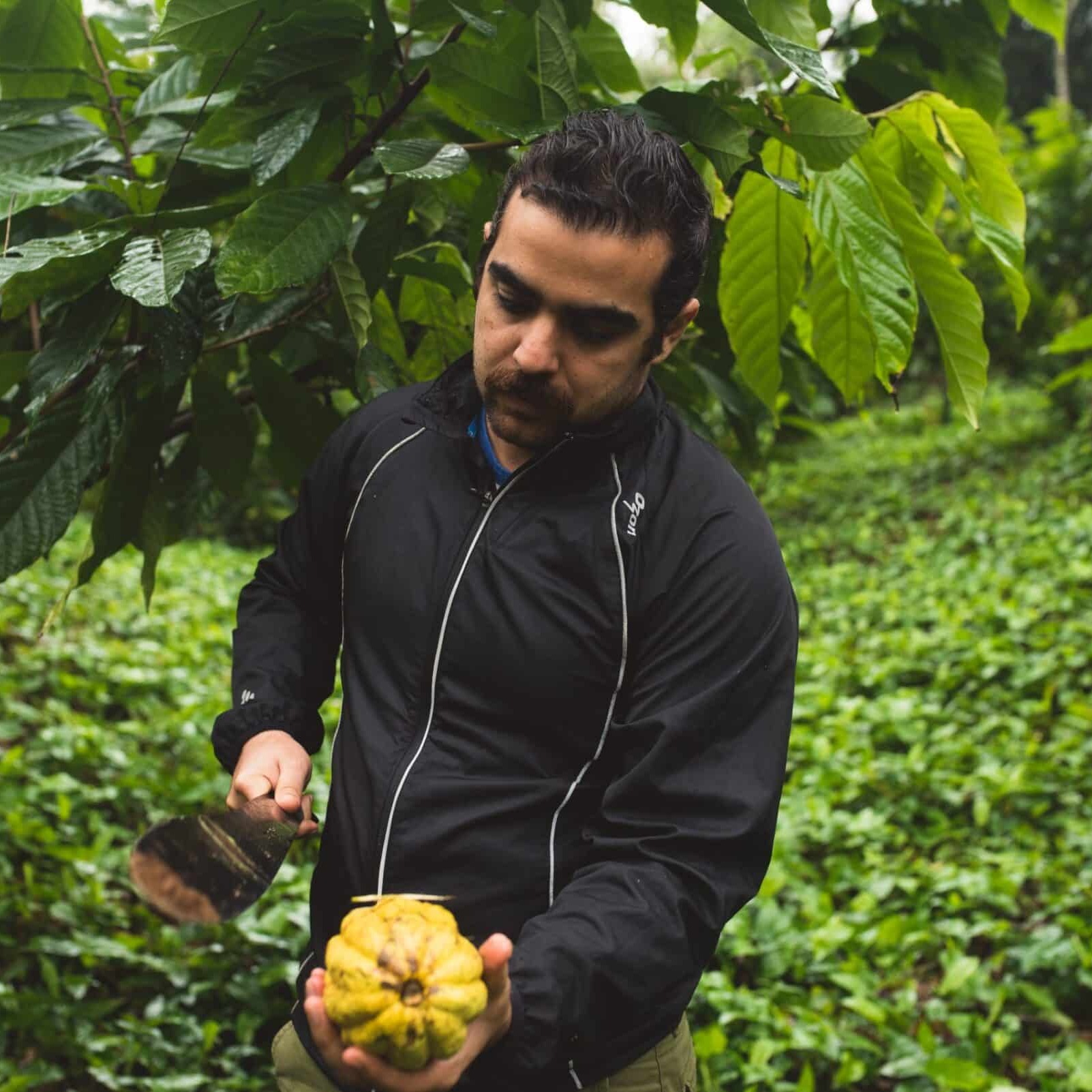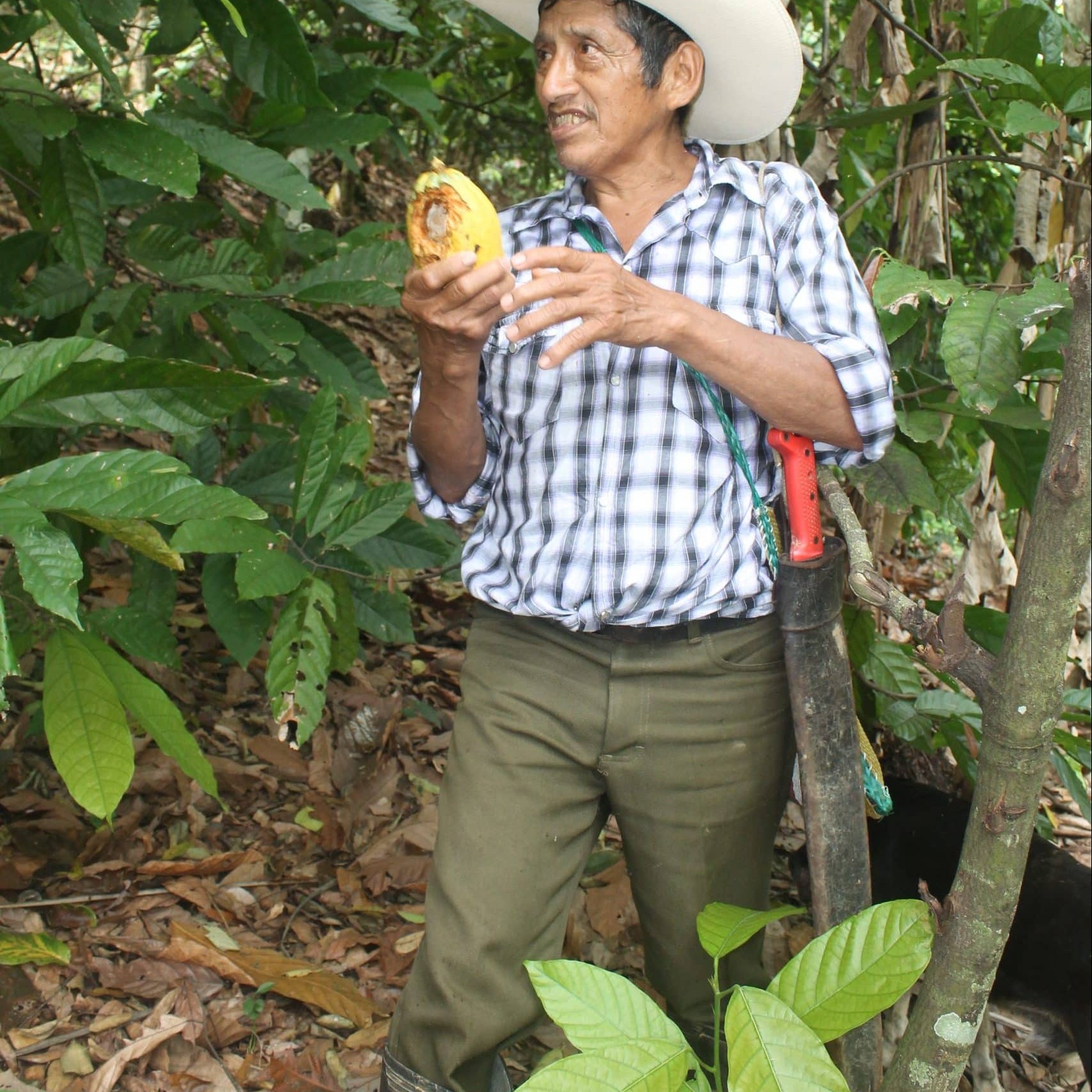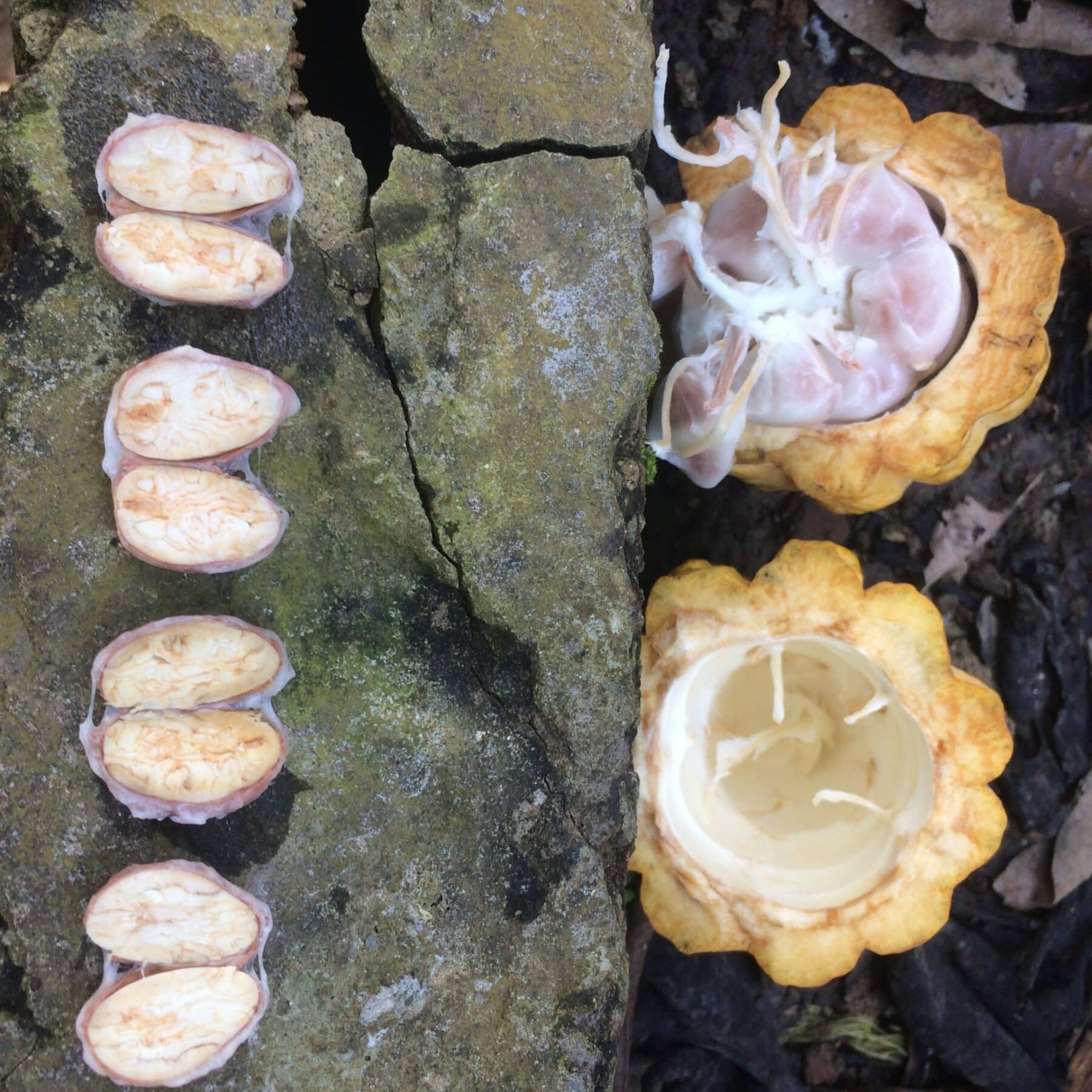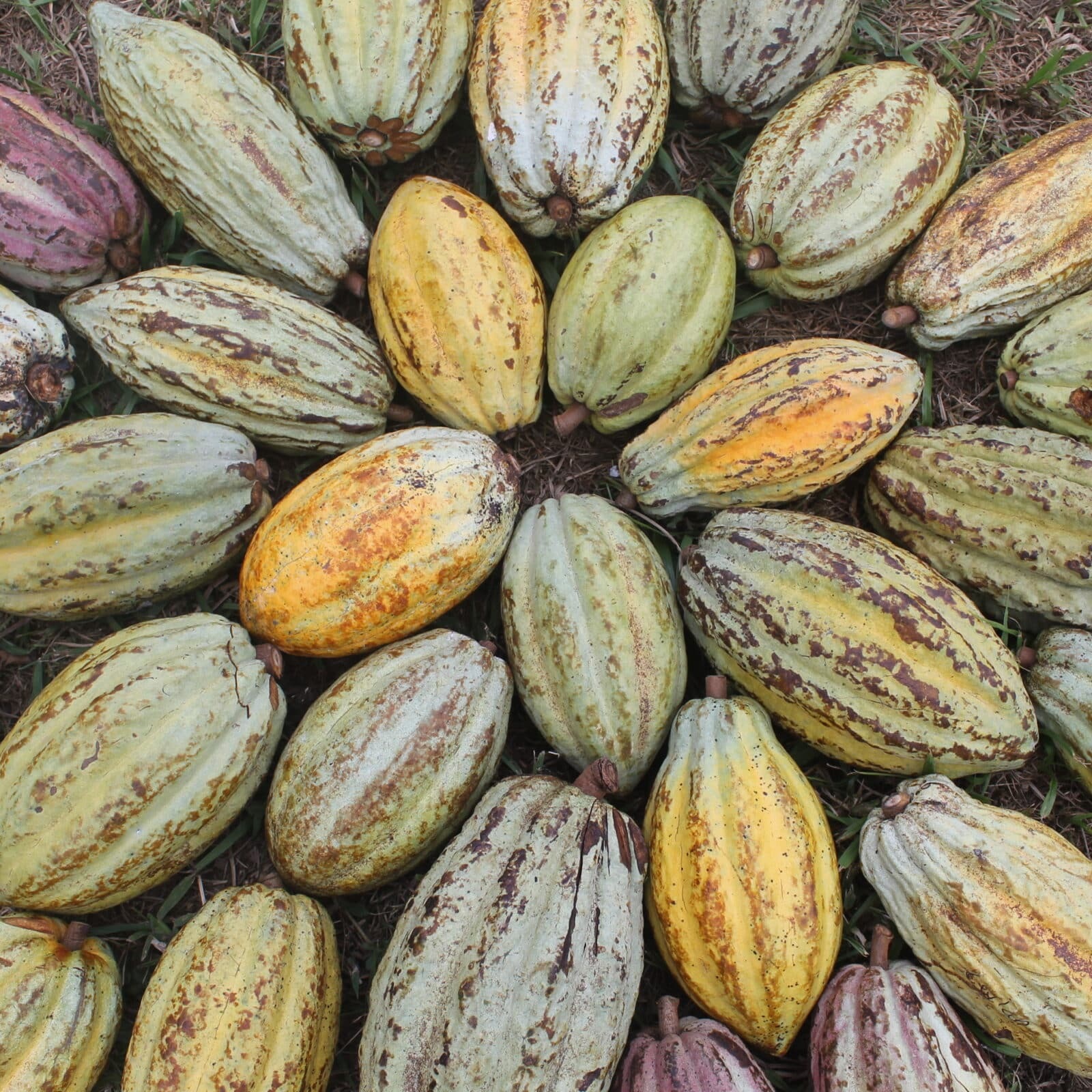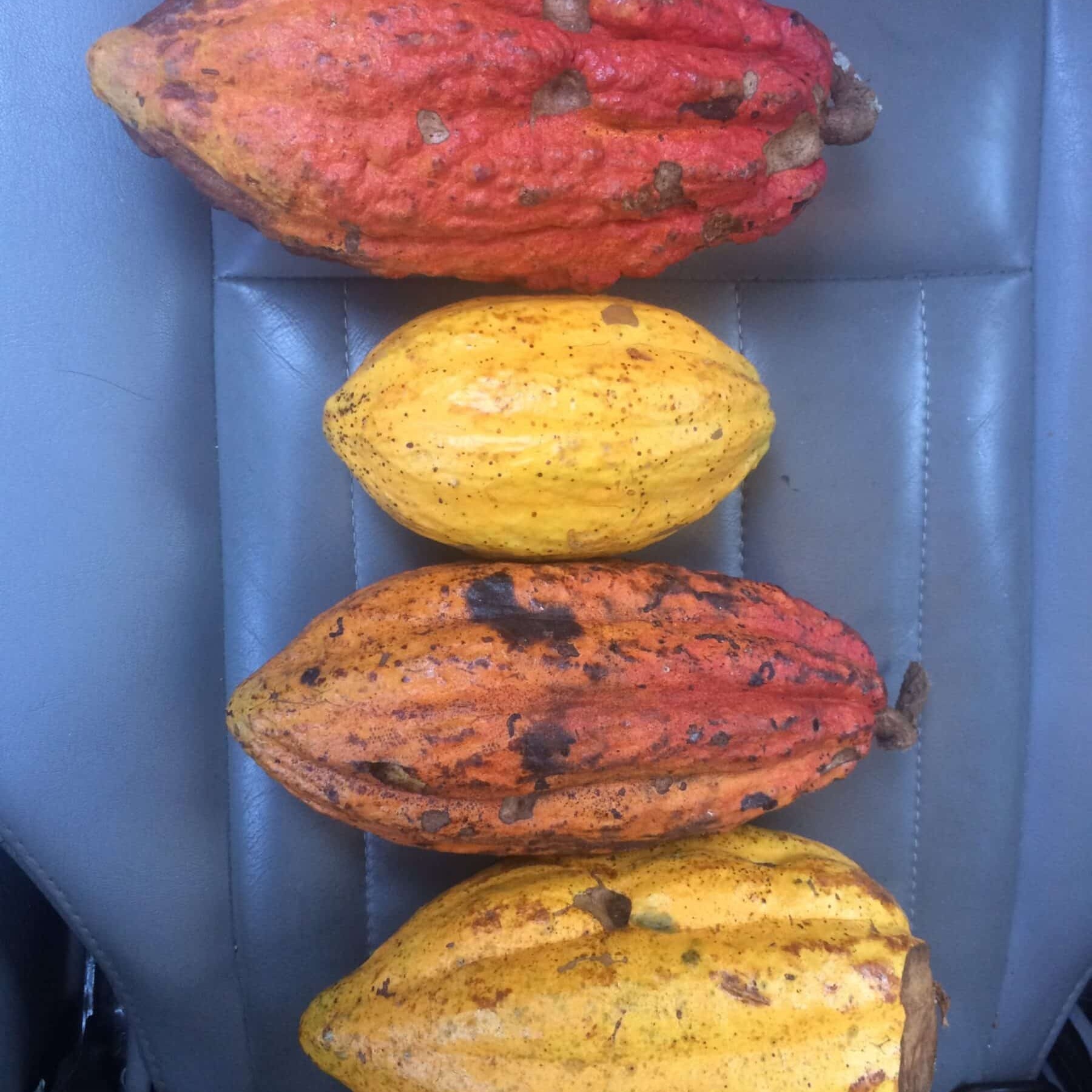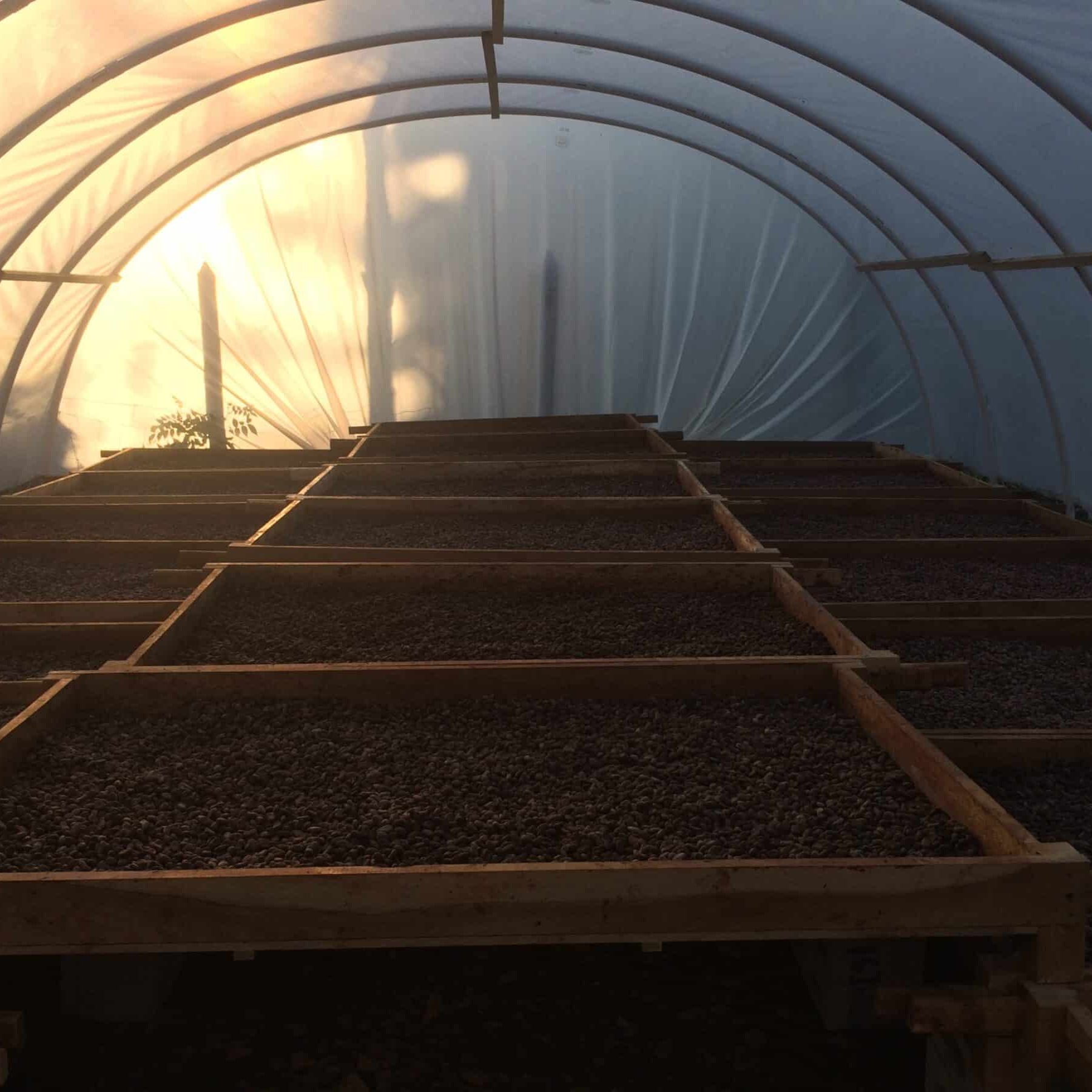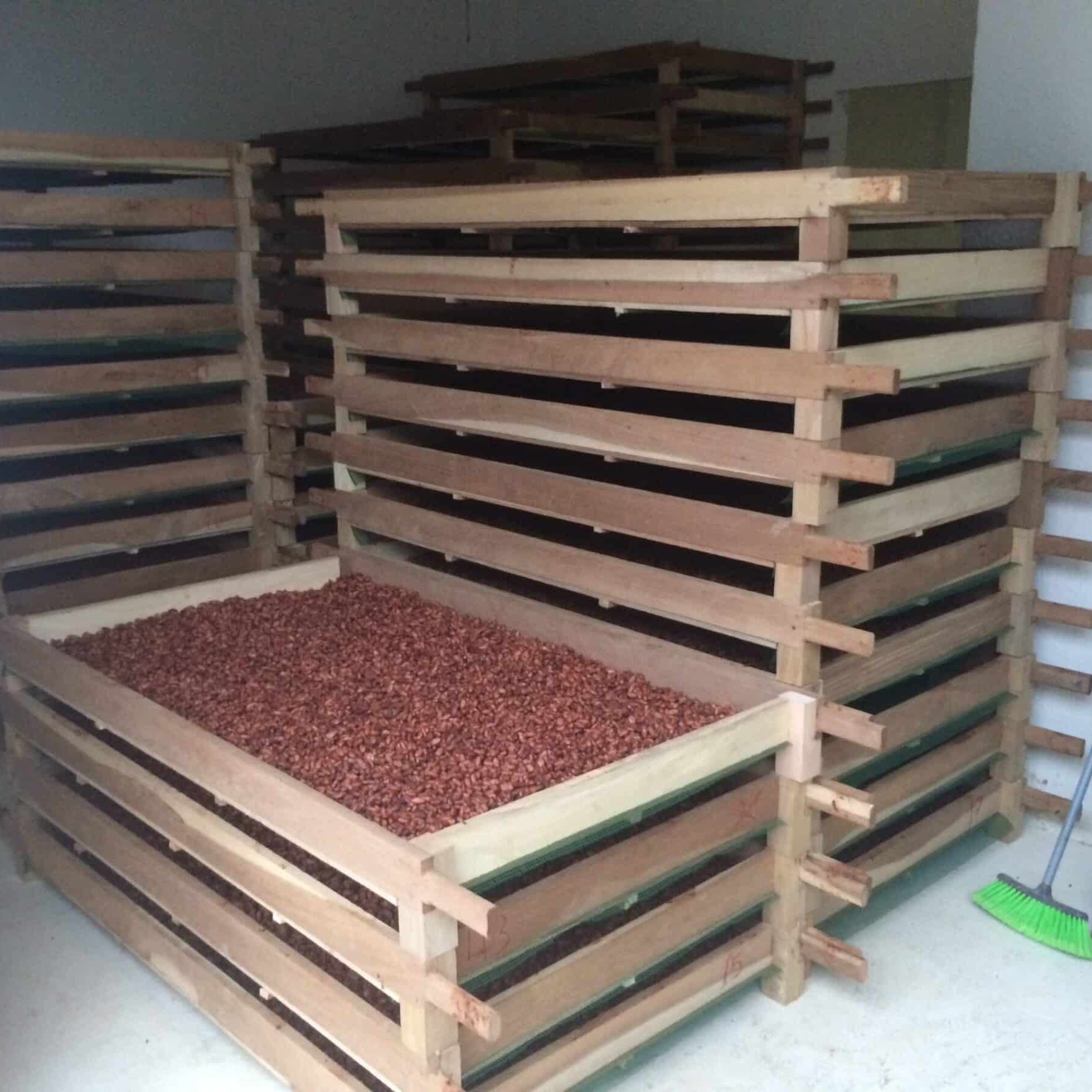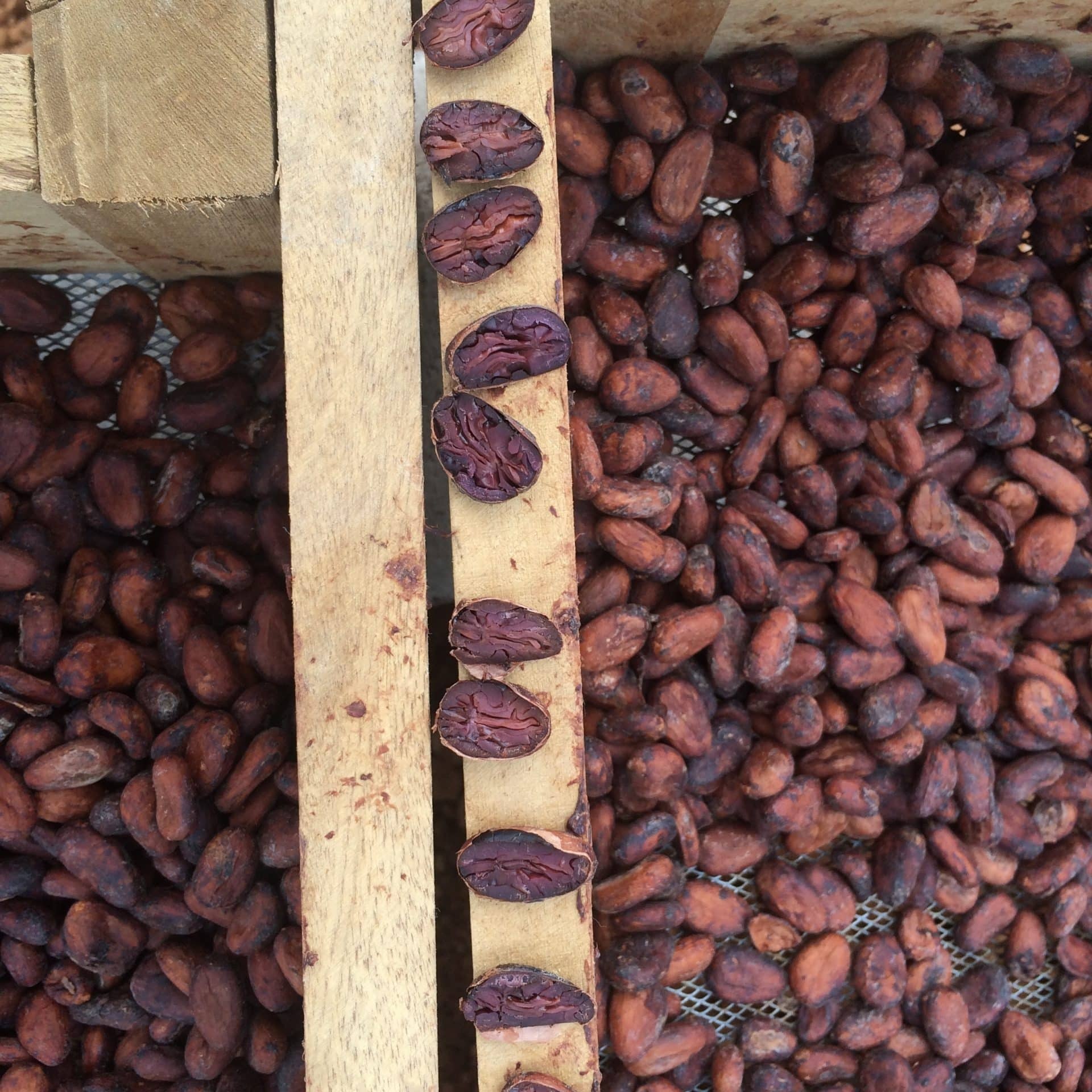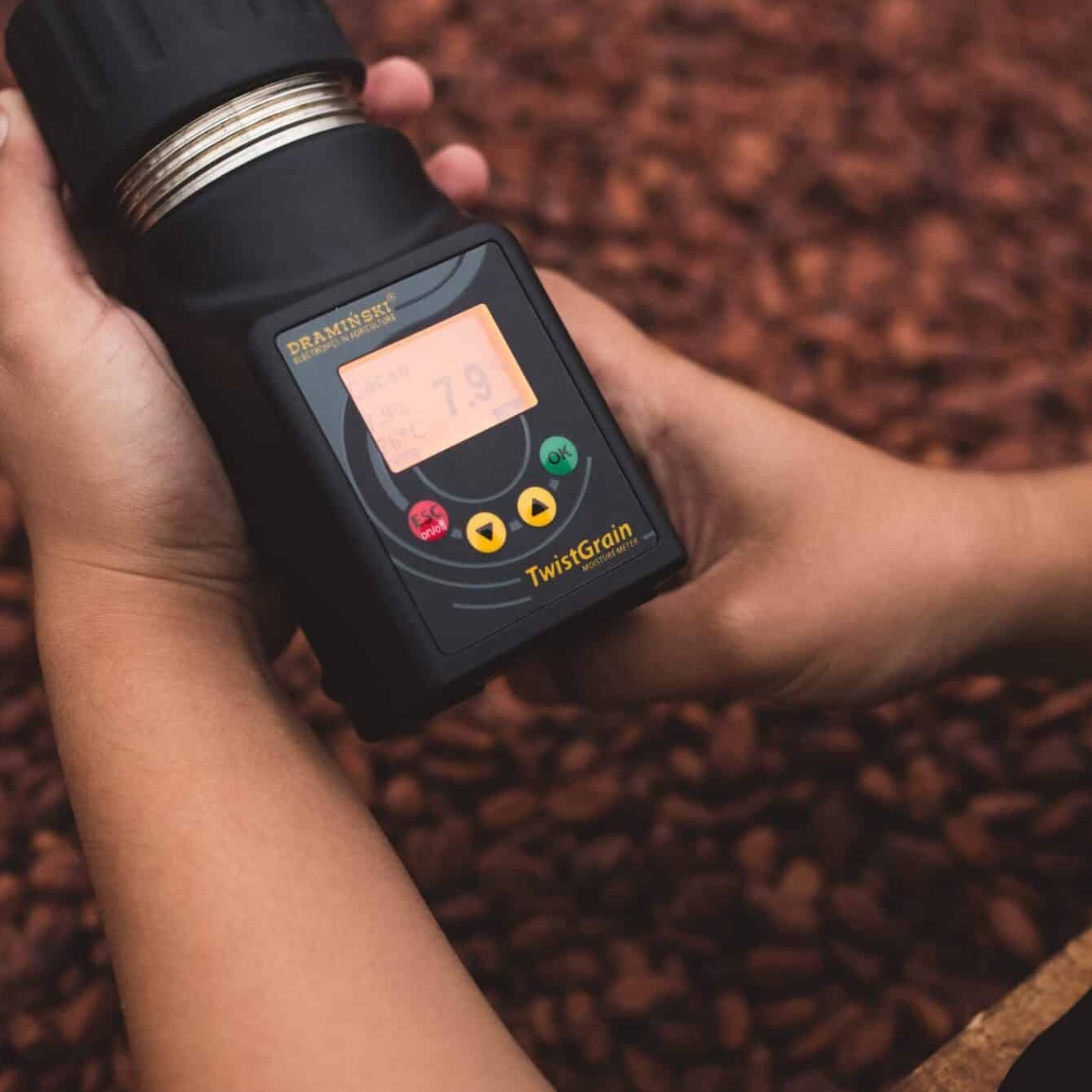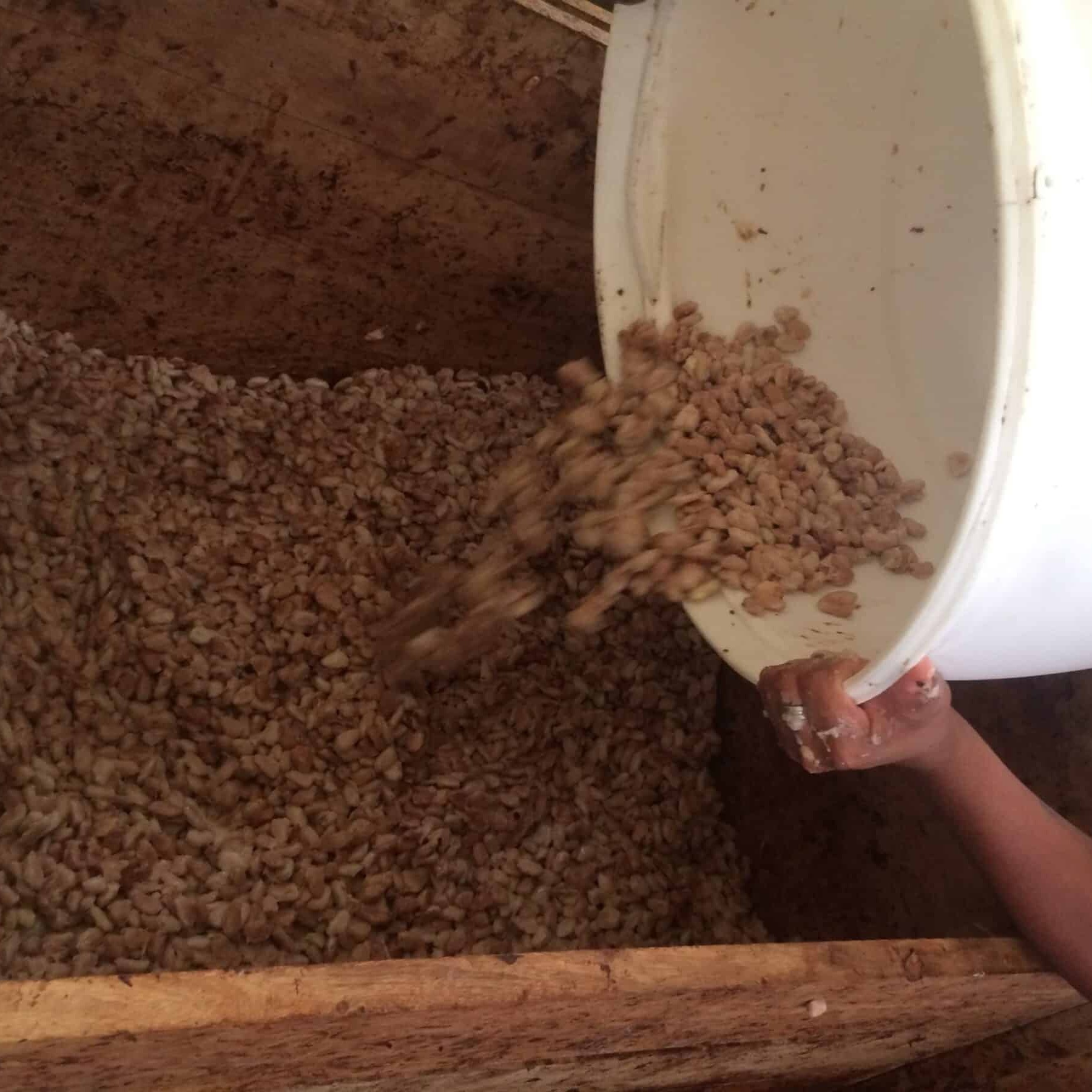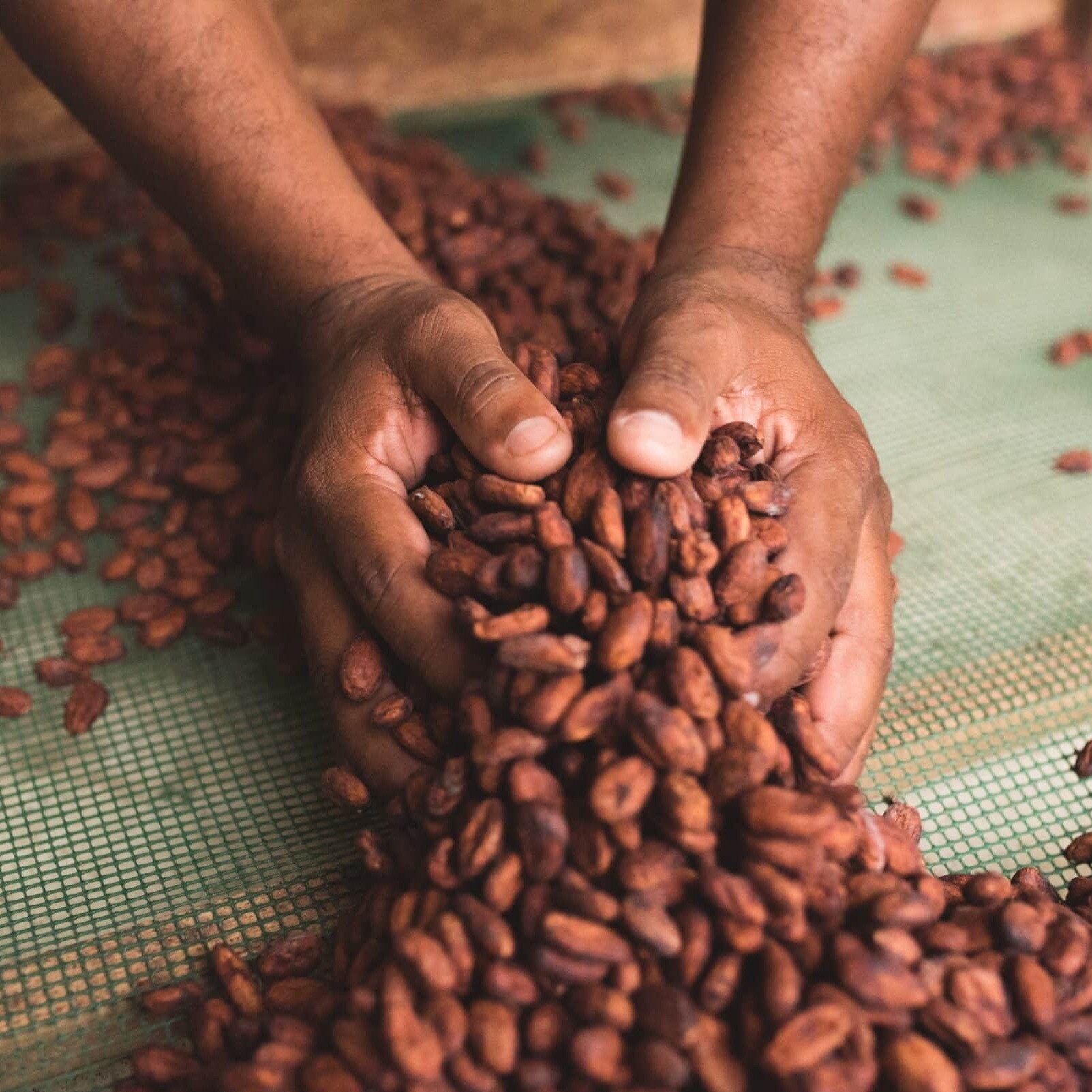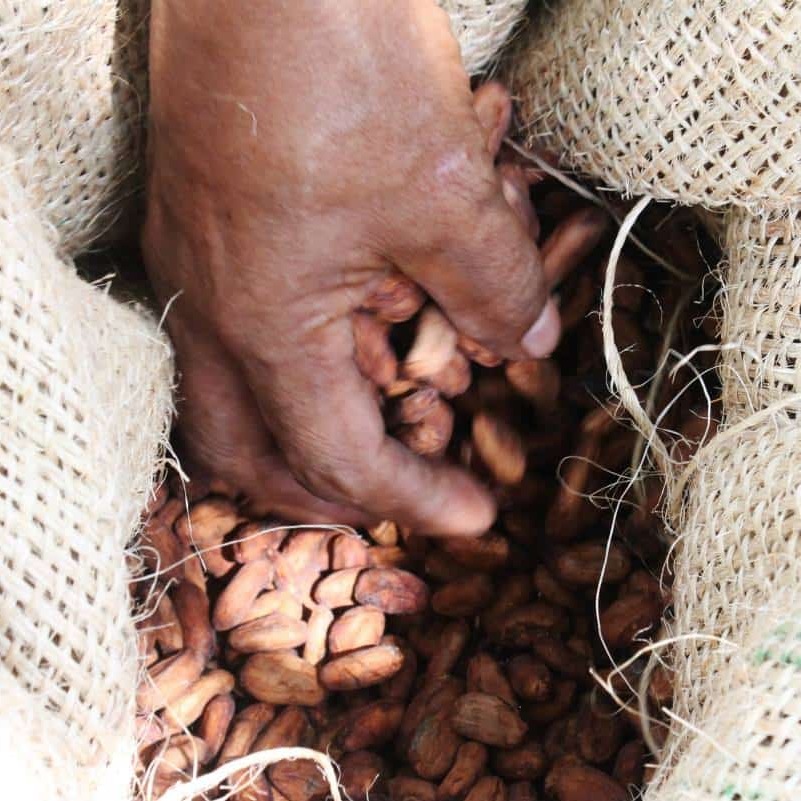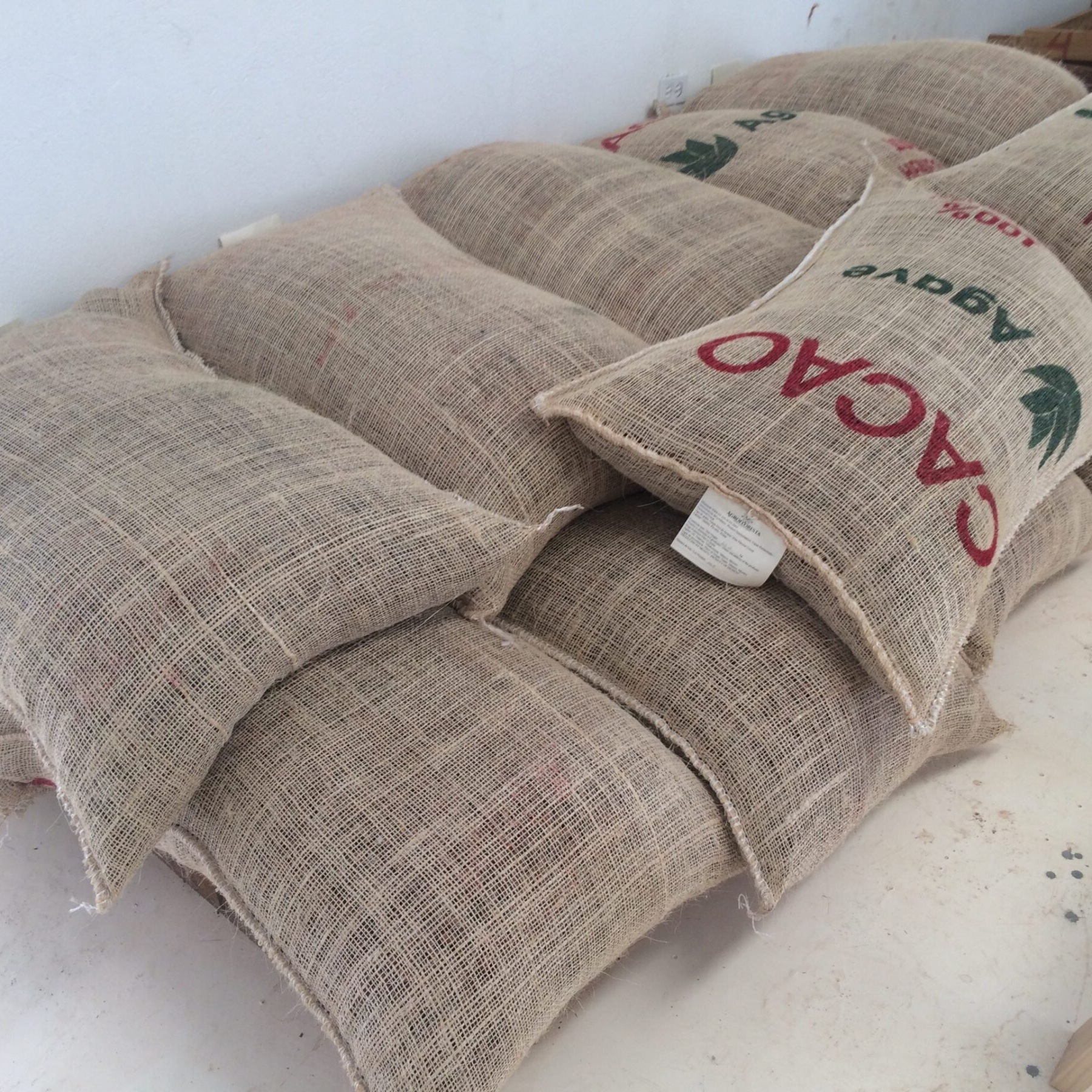Superfood cocoa - why cocoa is so healthy
How can such a healthy substance, with such a fantastic effect, be so unknown in our latitudes?
Frage ich mich und trinke einen weiteren Schluck dieser samtigen, köstlichen, heilenden und cremigen Flüssigkeit. Noch immer fristet Kakao ein Schattendasein neben Tee und Kaffee.
Völlig zu Unrecht, denn das braune Gold wird nicht ohne Grund als „Speise der Götter“ bezeichnet und gilt als Superfood. Schon die Maya und Azteken nutzen Kakao als Medizin. Kakao ist ein wahrer Allrounder an guten Komponenten, er schmeckt fantastisch, ist gesund, macht fit, wach und glücklich! Hier erfährst du, warum Kakao gesund und eine Wunderpflanze ist.
Cacao helps with high blood pressure & contains numerous antioxidants
Cocoa contains numerous antioxidants that are essential for life. Cocoa is particularly rich in the antioxidant phytochemical flavanol, which belongs to the subgroup of polyphenols. Flavanols lower blood pressure and are said to reduce the risk of Alzheimer's.
Diese Antioxidantien bekämpfen außerdem die freien Radikale im Körper und schützen unsere Körperzellen vor Schäden und frühzeitiger Alterung. Sie senken zusätzlich den Cholesterinspiegel, schützen vor Arterienverkalkung und können das Schlaganfall- und Krebsrisiko senken. Außerdem wirken sie der Bildung unliebsamer Fettpölsterchen entgegen.
Kakao enthält diese Flavanole in hoher Konzentration. Genau gesagt enthält er sogar mehr Flavanole als alle anderen Lebensmittel. Nicht einmal die als antioxidativ bekannten Blaubeeren, grüner Tee oder Matcha Tee können da mithalten.
Achtung: Wenn du deinen Kakao mit Kuhmilch und Zucker trinkst, dann verlieren die Antioxidanten ihre Wirkung. Durch die Bestandteile der Milch wird die Aufnahme dieser wichtigen Nährstoffe blockiert. Am besten genießt du den Kakao in Wasser aufgelöst oder in zuckerfreier Pflanzenmilch, wie Hafermilch.
Cocoa is rich in magnesium & makes you awake & fit
Kakao zählt zur weltweit höchsten pflanzlichen Magnesiumquelle. Als wichtiger Energielieferant unterstützt Magnesium den Knochenaufbau und unsere Muskeln.
Unser Herzmuskel freut sich ganz besonders darüber, denn Magnesium fördert nachweislich die Herzgesundheit. Durch den besonders hohen Magnesiumanteil in Kakao wird zusätzlich der Stoffwechsel reguliert und die Gehirnleistung erhöht.
Kakao ist nicht nur gesund. Er macht dich auch wach und fit. Das im Kakao enthaltene Theobromin wirkt ähnlich wie Koffein, jedoch milder und langanhaltender und hilft dir, wenn du dich müde und antriebslos fühlst. Darüber hinaus wirkt sich das Magnesium krampflösend und entspannend aus, was besonders für Frauen während ihrer Periode ein großer Bonus ist.
Cocoa is rich in calcium
Auch der hohe Calciumgehalt in Kakao, macht diesen zu einem wahren Superfood. Unser Körper benötigt Calcium für den Aufbau von Knochen, für unsere Zähne und Nägel. In 100 g rohem Kakao befinden sich bereits 160 mg Calcium, in der gleichen Menge Milch hingegen nur 125 mg.
Deine Muskulatur braucht Calcium genauso wie dein Nervensystem. Auch die Blutgerinnung ist von der richtigen Menge Calcium abhängig.
Nicht zuletzt ist Kakao ein wahrer Energielieferant. Für den extra Energieschub empfehlen wir dir eine Tasse von unserem Tabasqueno cocoa from the sustainable Selva Zoque project.
Cocoa is rich in iron
In addition to calcium, there is also a lot of iron in it good cocoa. With 7.3 mg iron per 100 g, cocoa contains far more iron than spinach, beef or lamb. The trace element is responsible for the formation of red blood cells and ensures better oxygen transport in the body, makes you awake and clear.
Tip: Iron works best when combined with vitamin C. Muesli with crushed cocoa and fresh kiwi or oranges is a fantastic idea.
Cocoa contains many unsaturated fatty acids
Cocoa contains many valuable unsaturated fatty acids. And these fats are not bad, no, because our body needs them to function! The oleic acid in particular is increased in raw cocoa and ensures your heart health.
Attention: In order to unfold its full health effect, the cocoa must not be heated above 42 degrees, otherwise the many valuable ingredients in the cocoa can be lost. Instead, slowly melt it in the warm liquid and use one Molinilloto whip it until creamy and fluffy.
Cocoa makes you happy
Cocoa contains the body's own messenger substance tryptophan, which, like seratonin, is a happiness hormone. As a result, cocoa gives you a deep sense of well-being, conjures up butterflies in your stomach and simply makes you happy and content from the inside out.
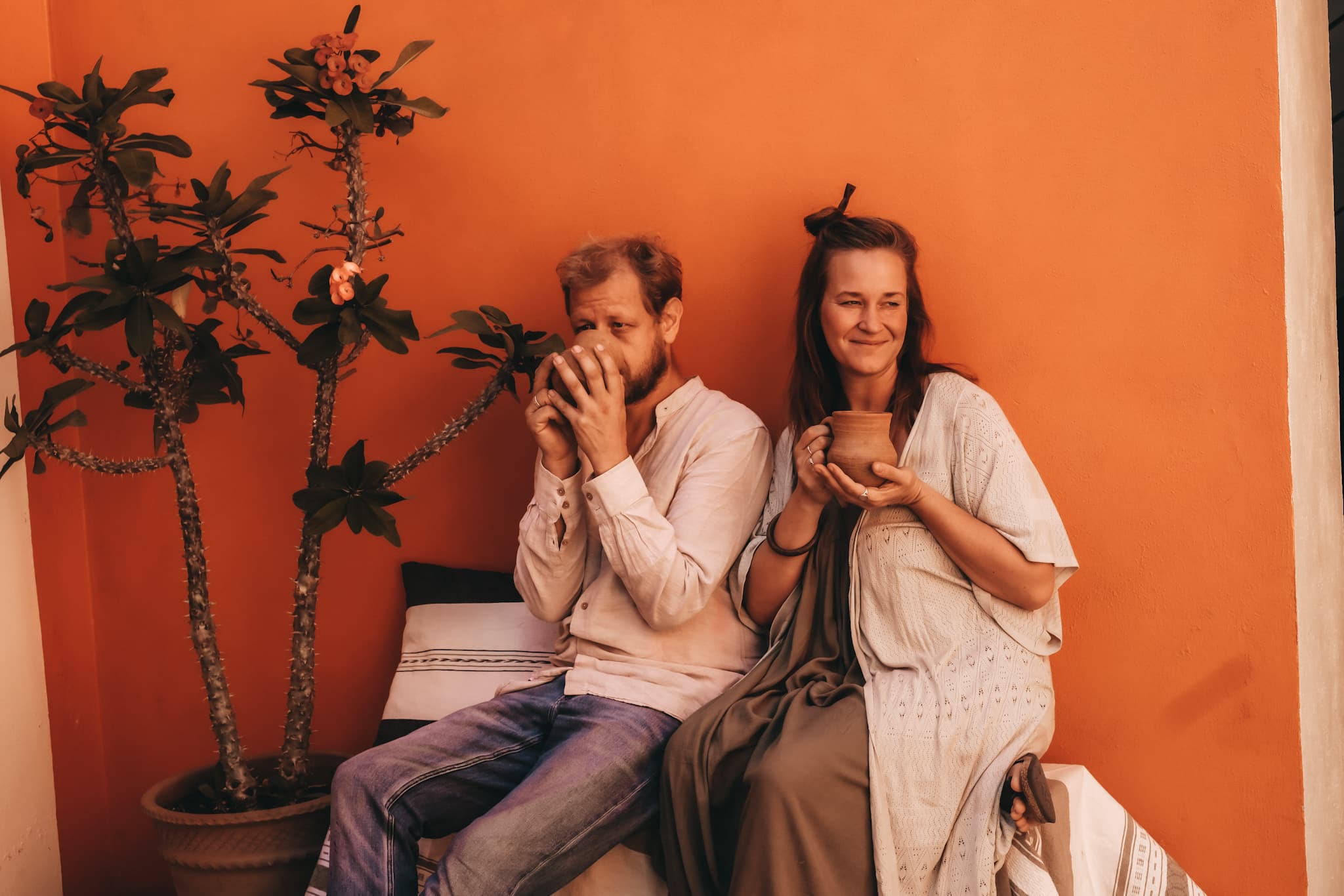
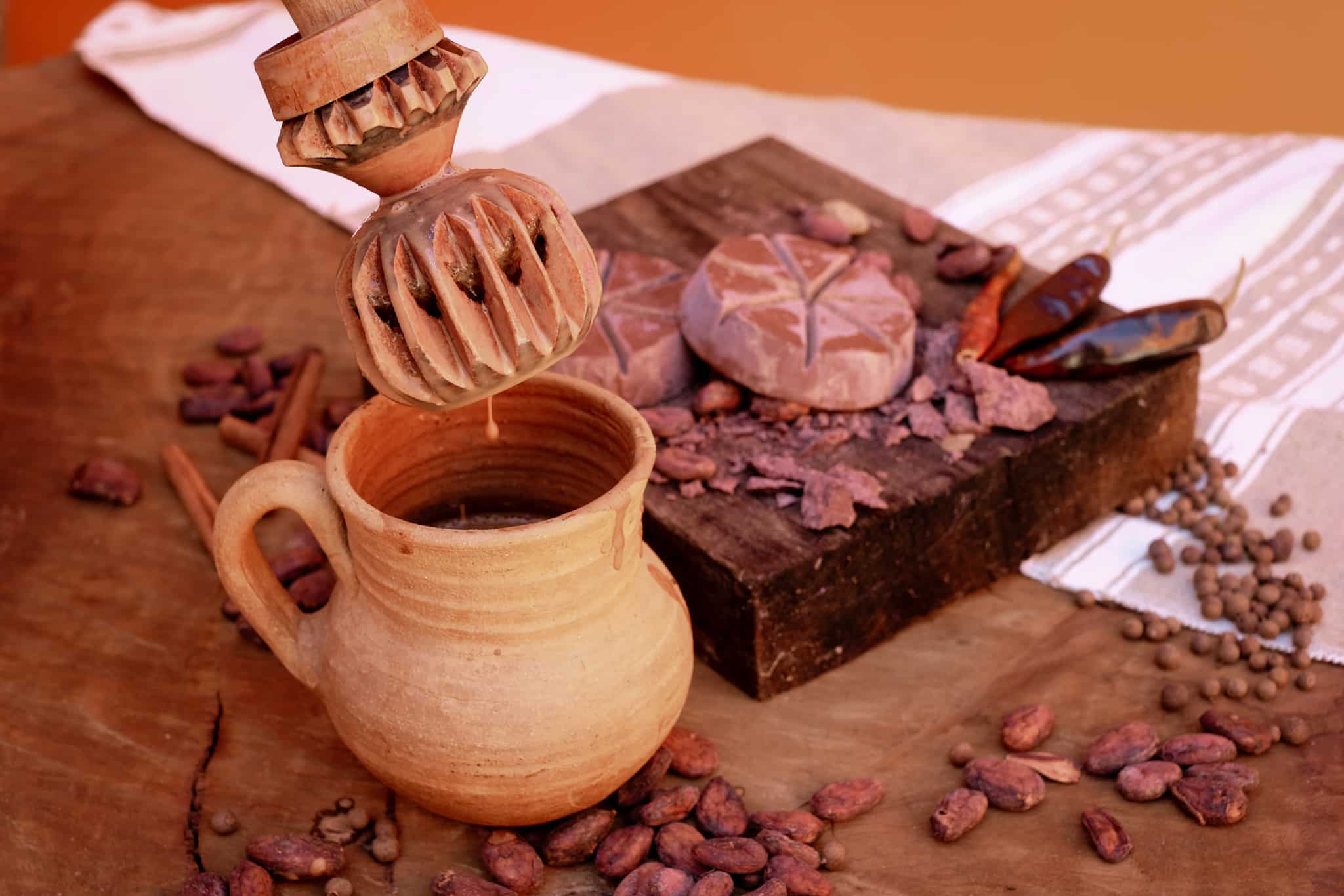
Cocoa and the environment – how cocoa is grown
Kakao ist ein ganz besonderes Genussmittel und geschmacklich etwa so vielfältig nuanciert wie Wein. Seine Herkunft und Anbaumethode hat einen enormen Einfluss auf die Qualität des Kakaos und seinen Geschmack. Ich nehme dich mit in die tropische Heimat des Kakao. Erfahre, woher Kakao kommt, wie verantwortungsbewusster Kakaoanbau aussieht und worauf du beim Kauf von Kakao unbedingt achten solltest.
So funktioniert Kakaoanbau - komm mit auf eine Kakaoplantage!
Der Kakaobaum ist sehr wählerisch was seinen Standort angeht. Er gedeiht nur unter sehr besonderen klimatischen Bedingungen. Als Schattenpflanze fühlt er sich im feuchten, warmen Klima des tropischen Regenwaldes besonders wohl und liebt es, in der unteren Baumschicht im Schatten von anderen Pflanzen und Bäumen zu wachsen. Obwohl der Großteil des Kakaoanbaus heutzutage in Westafrika und Indonesien stattfindet, stammt Kakao ursprünglich aus Lateinamerika. here you will learn more about its origin and what makes high-quality cocoa.
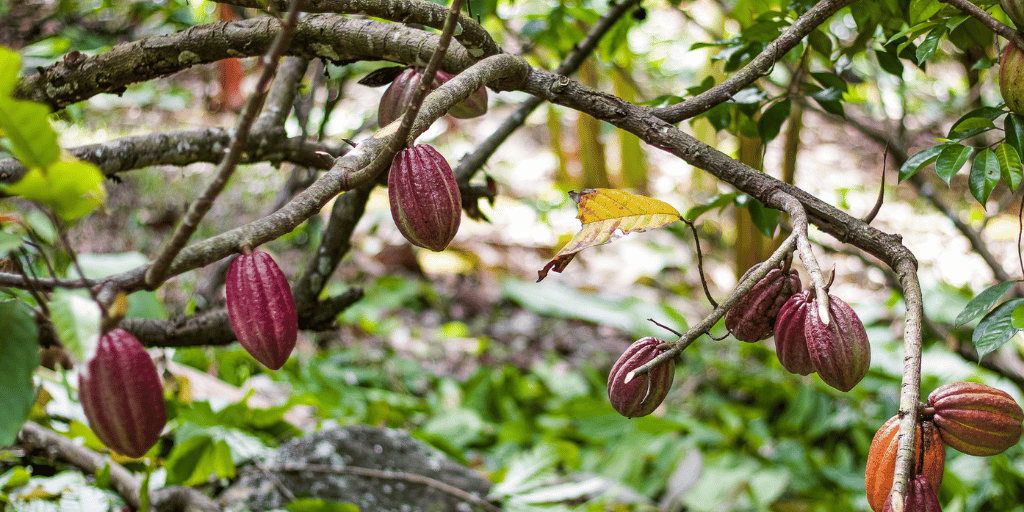
What cultivation methods are there for cocoa?
Der Anbau von Kakao unterscheidet sich stark, je nach Standort/ Lage und Besitzverhältnissen. Im Allgemeinen unterscheiden wir zwischen konventionellem und biologischem Anbau. Die Kakaoernteerträge können dabei je nach Anbaumethode sehr unterschiedlich ausfallen.
Der Kakaoertrag pro Hektar hängt aber generell nicht nur von der Anbaumethode ab, sondern auch von weiteren Faktoren: Das Wetter, die Kakaosorte, die Größe der Anbaufläche, das Alter der Bäume, die Bodenbeschaffenheit u.v.m. beeinflussen den Ertrag.
Ich möchte dir im Folgenden 3 mögliche Anbaumethoden genauer vorstellen.
cultivation in monoculture
Beim Kakaoanbau in Monokulturen werden ausschließlich Kakaobäume angepflanzt. Dabei stehen die Bäume eng auf riesigen Plantagen, die bis zu 430 ha groß sein können. Durch die große Nähe der Bäume zueinander und den fehlenden Ausgleich durch andere Pflanzen, breiten sich Schädlinge und Krankheiten schneller und leichter aus – der Einsatz von Pestiziden ist notwendig. Solche Großplantagen findet man hauptsächlich in Indonesien und Malaysia. Aber auch in Trinidad, Ecuador und Brasilien erfolgt Kakaoanbau in Monokulturen.
Pestizide schaden den Böden
Darüber hinaus werden bei dem Anbau in Monokulturen die Böden sehr stark einseitig belastet, was eine starke Düngung notwendig macht. Die Chemikalien, die auf den Plantagen verwendet werden, gelangen in die Böden und das Grundwasser. Dies wirkt sich auf die Umwelt und Gesundheit der Menschen und Tiere vor Ort aus.
Dieser Anbau ist zudem sehr wasserintensiv. Die fehlenden Schattenbäume werden durch Netze ersetzt. Das erschwert den Zugang für Tiere zusätzlich, was weniger Artenvielfalt auf den Plantagen zur Folge hat. Nach ca. 25 Jahren werden alte Bäume durch junge Bäume ersetzt, um einen kontinuierlich hohen Ertrag zu gewährleisten. Der Kakaoertrag in diesen Anbauformen ist sehr hoch (bis zu 3.000 kg/ha) und anders, als bei anderen Anbaumethoden, werden durch manuelle Bestäubung die höchsten Ernteerträge erzielt.
Der Anbau in Monokulturen wirkt sich ebenso auf den Geschmack des Kakao aus. Die Bäume stehen unter großem Stress, schon allein, weil sie so eng gepflanzt werden. Der Kakao schmeckt als Folge oft bitter und sauer.
Cultivation in a simple mixed culture under shade plants
Wird der Kakao in einer Mischkultur angebaut, darf er sich mehr Platz mit einer anderen Schattenpflanzenart teilen. Das reduziert den Stress der Kakaopflanze und sie sind weniger anfällig für Schädlinge und Krankheiten. Als Schattenpflanze wählen die Kleinbauern oft eine andere Nutzpflanze, wie Bananenstauden. Diese stickstoffbindenden Baumarten bringen den Bauern zusätzliche Erträge oder Nahrungsmittel zum Eigenbedarf ein. Hier wird biologischer Kakaoanbau möglich, denn der Anbau mit Schattenpflanzen funktioniert ohne den Einsatz von Pestiziden. Bei dieser Anbaumethode können nur niedrige bis mittlere Kakaoerträge erreicht werden (etwa 200-1.000kg/ha).
Cultivation in agroforestry systems - a hope for the rainforest
Beim Anbau in naturnahen Agroforstsystemen, wie bei our Tabasqueño cocoa, wird Kakao zusammen mit einer Vielzahl verschiedener Schattenbäumen angebaut. Bananenstauden und andere Nutzpflanzen werden gemeinsam angebaut – darunter Vanille, Piment und Zimt.
Die dadurch geschaffene Strukturvielfalt simuliert einen natürlichen Regenwald und bietet Lebensräume für heimische Tier- und Pflanzenarten. Durch die Vegetation ist der Boden besser vor Erosion geschützt und die zuvor ausgelaugten Böden können wieder eine erhöhte Bodenfruchtbarkeit erlangen.
Die größeren Abstände zwischen den Kakaobäumen vermindern das Risiko einer Ausbreitung von Krankheiten und Schädlingen. Der Anbau erfolgt nach ökologischen Kriterien und ohne Einsatz von Pestiziden und Dünger. Die Kakaoerträge je Hektar sind bei dieser Anbaumethode sehr gering. Für die Kakabauern und lokalen Farmer ist es dennoch attraktiv, da der Anbau unterschiedlicher Nahrungs- und Nutzpflanzen, wie Gewürze, Medizinpflanzen etc., eine nachhaltige Einnahme- und Nahrungsquelle für die Bevölkerung darstellt. Zudem kann der Kakao mit der Bio-Zertifizierung zu höheren Preisen verkauft werden.
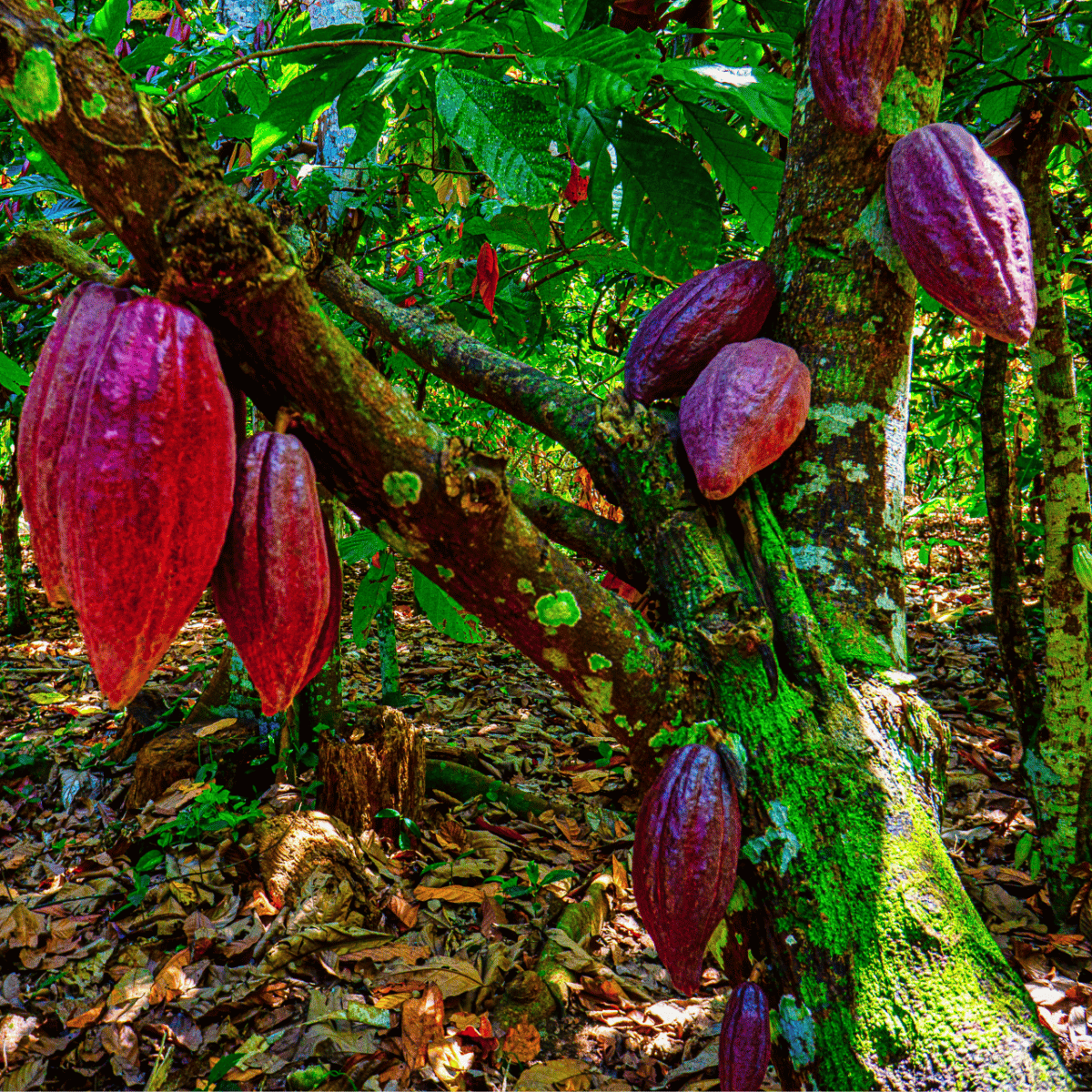
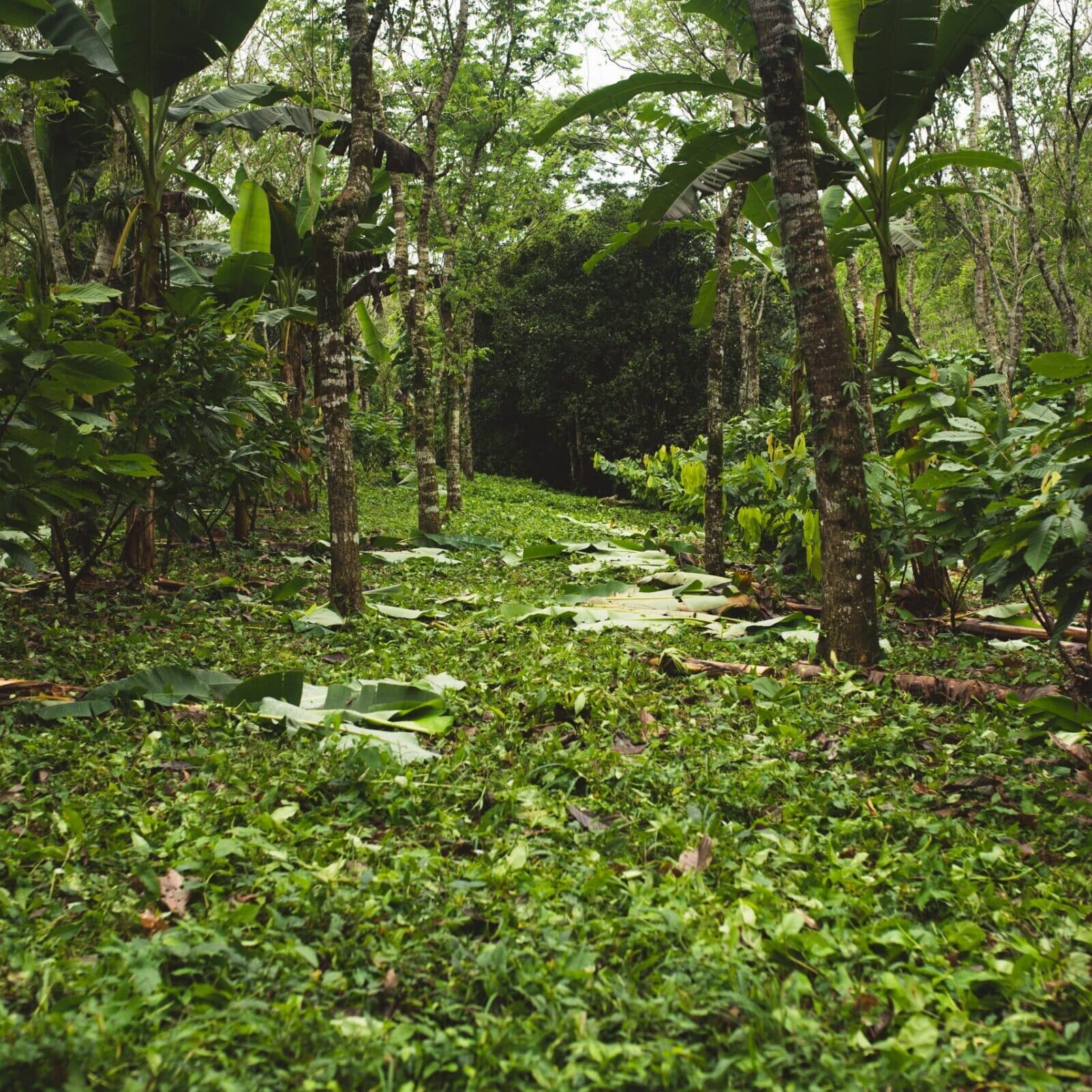
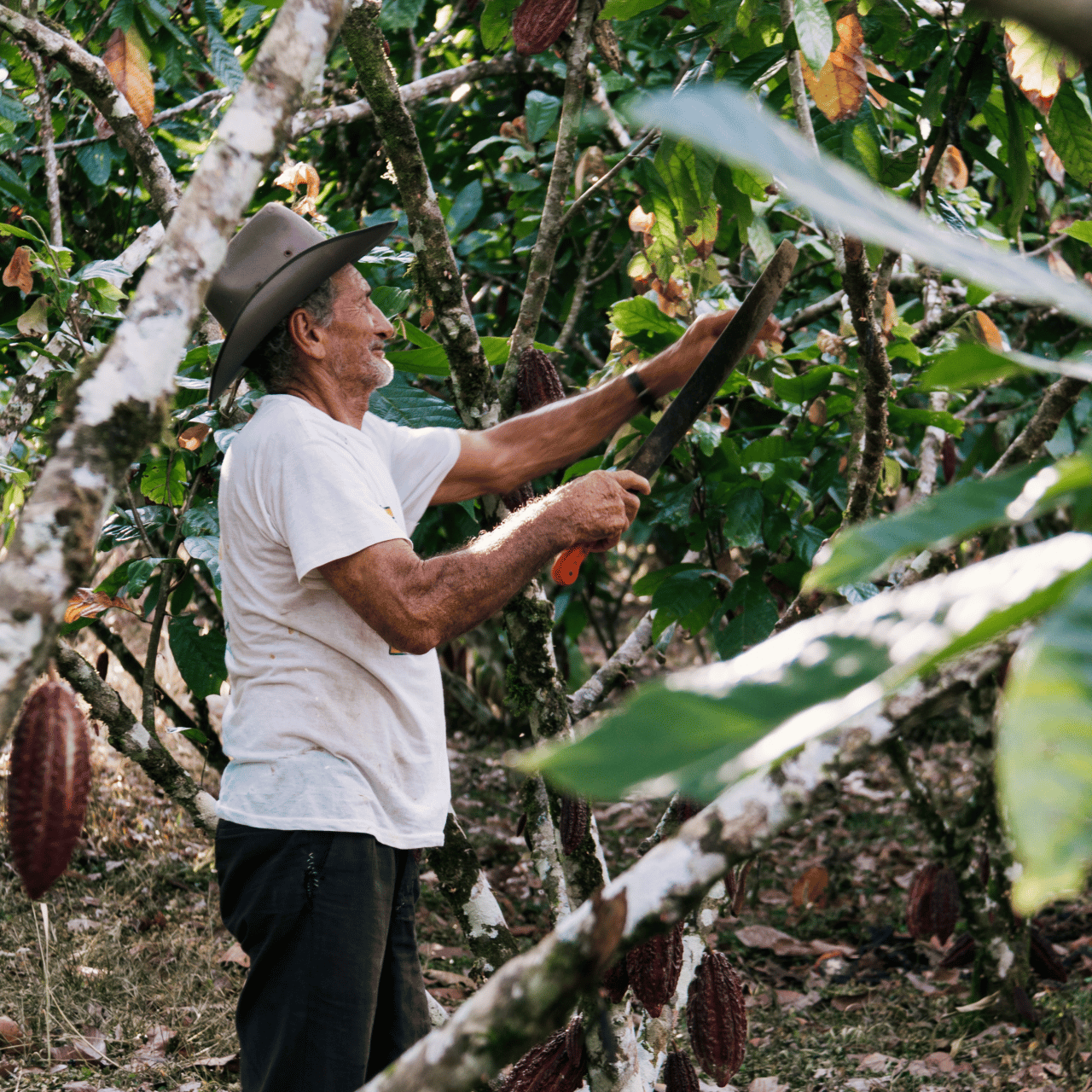
Environmental protection and reforestation through cocoa cultivation
Follow us to the Mexican state of Tabasquo, the cradle of cocoa, and learn our cocoa project Selva Zoque kennen. Hier fördert das Agroforstunternehmen Agrofloresta Mesoamericana gemeinsam mit Original Beans den Anbau von Bio-Kakao in naturnahen Agroforstsystemen.
Ehemals ausgelaugtes Farmland wurde dort in den letzten 6 Jahren zu einem 40ha großen Misch-Regenwald umgewandelt. Die Kleinbauernfamilien der indigenen Zoque und Tzotzil Stämmen erlernen naturnahe Anbaumethoden. Außerdem wird der Kakao zu fairen Preisen abgenommen. Auf diese Weise findet direkter, fairer Handel, Umweltschutz und Förderung der Artenvielfalt gleichermaßen statt. Ziel des Selva Zoque – Projektes ist es:
- den Familien vor Ort Ernährungssicherheit zu geben
- Einkommensalternativen zu schaffen und
- die Kleinbauern zu motivieren, durch erlerntes Wissen keinen weiteren Raubbau an den Regenwäldern zu betreiben.
Realisiert wird das durch den Mischanbau vielfältiger Nutzpflanzen mit Kakao als Schattenspender sowie verschiedenen Fruchtbäumen. Dadurch entstehen in den Nutzflächen wieder Lebensräume für heimische Tier- und Pflanzenarten. Gleichzeitig wird die Widerstandsfähigkeit gegenüber Klimaveränderungen, Schädlingsbefall und Pflanzenkrankheiten erhöht.
Learn more about that Project Selva Zoque and support it with your donation.
Does cocoa farming harm the rainforest?
Cocoa cultivation in intensive forms such as monocultures has strong negative consequences for the environment:
Durch die Abholzung des natürlichen Regenwaldes verlieren wir lebenswichtige Bäume. Bäume, die Sauerstoff bilden, CO2 binden und ein Zuhause für vielerlei Arten sind. Durch die Abholzung für Anbauflächen gehen wichtige Lebensräume vieler Arten verloren und die Artenvielfalt wird enorm reduziert.
Monokultur hinterlässt Spuren
Der intensive Kakaoanbau hat auch negative Folgen für den Boden. Durch die sehr einseitige Belastung laugt der Boden extrem aus, da nur bestimmte Nährstoffe genutzt werden. Aus diesem Grund ist eine extensive Düngung des Bodens notwendig. Andernfalls wird die Plantage nach kurzer Zeit aufgegeben.
Im konventionellen Anbau halten die Famer den Bodengrund frei von „Unkraut“ und Sträuchern. Dadurch wird die ohnehin sehr dünne Humusschicht der Regenwaldböden weggeschwemmt und die Großplantagen verlieren die letzten verbleibenden Nährstoffe. Wind und Wasser lassen den Boden in Folge weiter erodieren, sodass er kontinuierlich gedüngt werden muss, um den Kakaobäumen genügend Nährstoffe zuzuführen. Ein Teufelskreislauf.
Schädlinge und Pflanzenkrankheiten bei Monokultur
Außerdem breiten sich in einer Monokultur Schädlinge und Pflanzenkrankheiten sehr viel schneller aus, weshalb Farmer mit Pestiziden dagegen vorgehen. Diese unterschieden jedoch meist nicht zwischen Schädlingen und Nützlingen. Auch wichtige Bestäuber wie Bienen, sterben an den Folgen des Pestizideinsatzes und verschwinden aus dem Ökosystem. Eine künstliche Bestäubung der Kakaoblüten wird in Folge unumgänglich.
Die intensive Düngung und der Einsatz von Pestiziden und Pflanzenschutzmitteln beeinträchtigt die Qualität des Wassers und Grundwassers und hat somit Auswirkungen auf die Gesundheit der Plantagenarbeiter*innen. Diese arbeiten meist ohne die notwendige Schutzbekleidung. Vergiftungen, Allergien, Reizungen der Haut und der Atemwege sind nur einige der Folgen, die meistens langfristig und irreversibel sind.

Overview - the cacao tree
Finally, the cocoa tree introduces itself to you with a short profile.
Latin name
Theobroma cacao
origin
Already around 1500 BC. the Olmec living in Central America used the cacao fruit and passed on their knowledge to the Maya. The Maya were the first to plant cacao purposefully around 600BC and even use the cacao beans as currency. With the conquest of America by the Spaniards in the 16th century AD, cocoa came to Europe as “black gold”. Up until the 18th century, however, the enjoyment of cocoa products was reserved for the wealthy. From the middle of the 19th century, a real boom in the chocolate industry began.
distribution
Originally, the cocoa tree was distributed from the Amazon basin to Central America. Today, cocoa is grown anywhere in the tropics where the demanding growing conditions are met. The highest production volumes come from Ivory Coast and Ghana.
The fruit
The leathery-woody cocoa pods are 10-35 cm long and weigh 200-1000 g. They are green when immature. Depending on the variety, they can turn yellow to reddish-brown when ripe. It takes about 6 months for the blossom to develop into a ripe cocoa fruit.
The beans
These lie in five rows in a whitish, sweet and sour flesh called the pulp. Up to 60 beans can grow in a cocoa pod. Each bean is about 2-3 cm long and 1 cm wide.
yield
On average 300 kg per hectare per year. In intensive plantations even up to 3 tons.
Ceremony cocoa recipe - instructions for your cocoa ceremony
Start your journey into the powerful and bittersweet world of cocoa with this special drink and enjoy the relaxing and at the same time invigorating effect of cocoa - for your daily break in everyday life. Depending on the dosage, our cocoa recipe can be used as a light cup of cocoa or as a ceremonial cocoa.
What is a cocoa ceremony?
Cocoa ceremonies are a shamanic ritual and are primarily used to help people achieve more clarity or self-determination, as well as to release inner blockages. In addition, the cocoa ceremony should open your heart and put you in a harmonious state - with yourself, your environment and fellow human beings.

What is ceremonial cocoa?
Ceremonial cocoa is made from whole fermented cocoa beans. These are roasted particularly gently and finely ground to create a uniform mass. This mass is the basic material for ceremonial cocoa and is called "cocoa mass". Of the Mellow Magic Cocoa is 100 % cocoa liquor (except for a pinch of salt to round out the flavor) and we use it for both ceremonial cocoa and our daily morning cup of cocoa. The basic ingredient of our cocoa is always "chocolate" made from 100% cocoa, without sugar, chemicals or other ingredients, completely untreated and gently roasted.
What is also special about ceremonial cocoa is that it is grown, harvested and processed with love and respect, just like at our cocoa project in Mexico. Because the frequencies of its origin, the cultivation and handling of the cocoa tree are contained in your cocoa drink. Here you can find out more about our sustainable Cocoa Project Selva Zoque from Mexico,
In contrast to the (mass) products of the food industry, noble, ceremonial cocoa actually has the potential to be a stimulating medicinal plant with an intensive effect.
Find out more about the production of cocoa and what makes "good cocoa":
What you should know before preparing
- Water is important, especially if you drink cocoa daily or want to attend a cocoa ceremony, because cocoa has a dehydrating effect.
- Cocoa has a lot of antioxidants and is therefore very healthy. However, animal protein, i.e. normal cow's milk, and sugar inhibit the antioxidant effect of cocoa. For this reason you should avoid cow's milk and added sugar for your cocoa ritual and instead use plant milk, such as. B. unsweetened oat or almond milk. Traditionally, only water is used for ceremonial cocoa.
- You should start with a smaller amount of cocoa and better not exceed the officially recommended amount of 40 grams per day. Feel your way slowly and feel how much cocoa is good for you.
Learn more about the positive properties and effects of cocoa here:
Set your intention for the ceremony
For a cocoa ceremony, or just for your daily cup of cocoa in the morning, it is valuable if you gather yourself beforehand, are completely with yourself and set an intention. Ask yourself how you want to feel when drinking the cocoa, what you want to let go of, what you want to bring into your life, what you need help for, what you are grateful for, etc.
Give your intention to the cocoa and then drink it consciously.
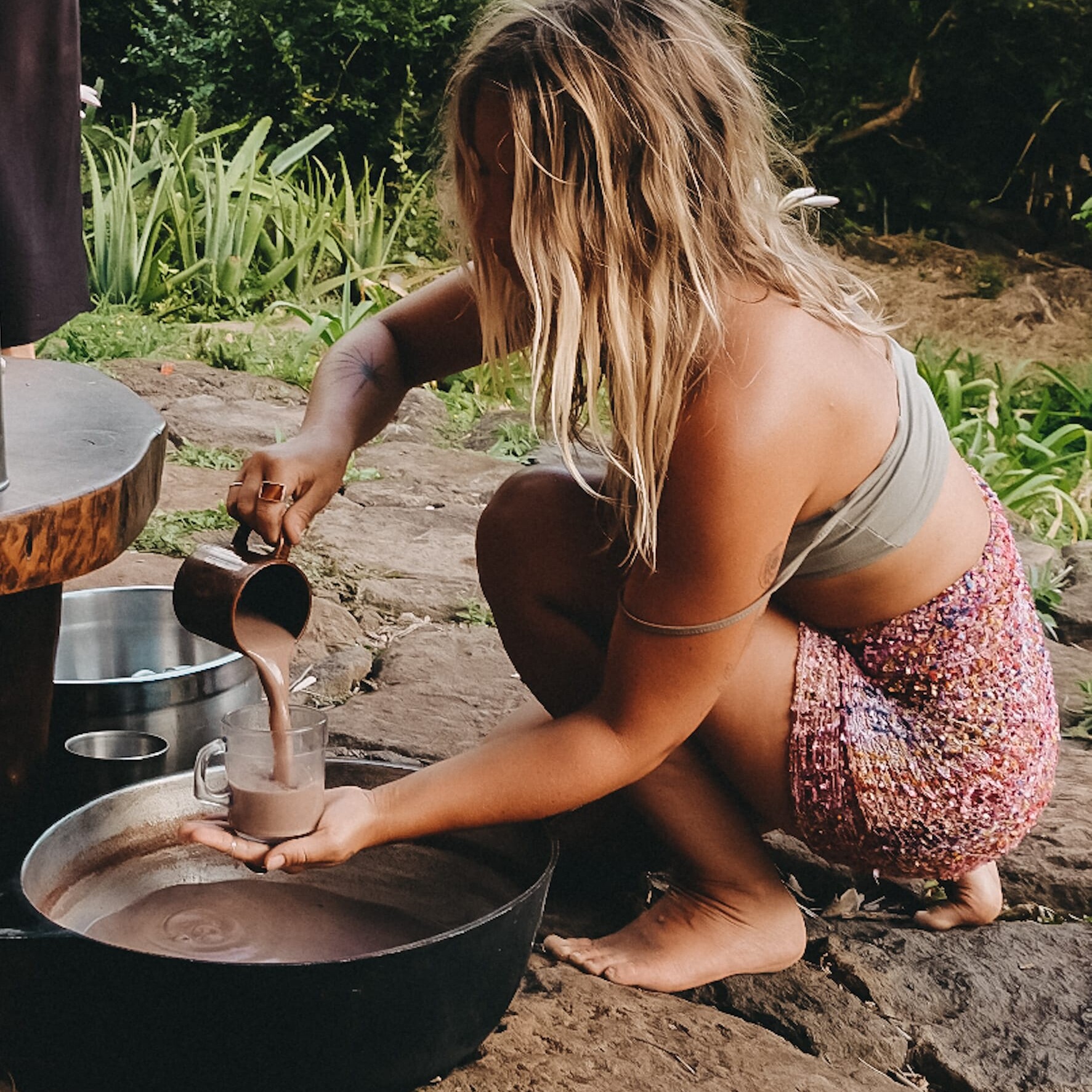
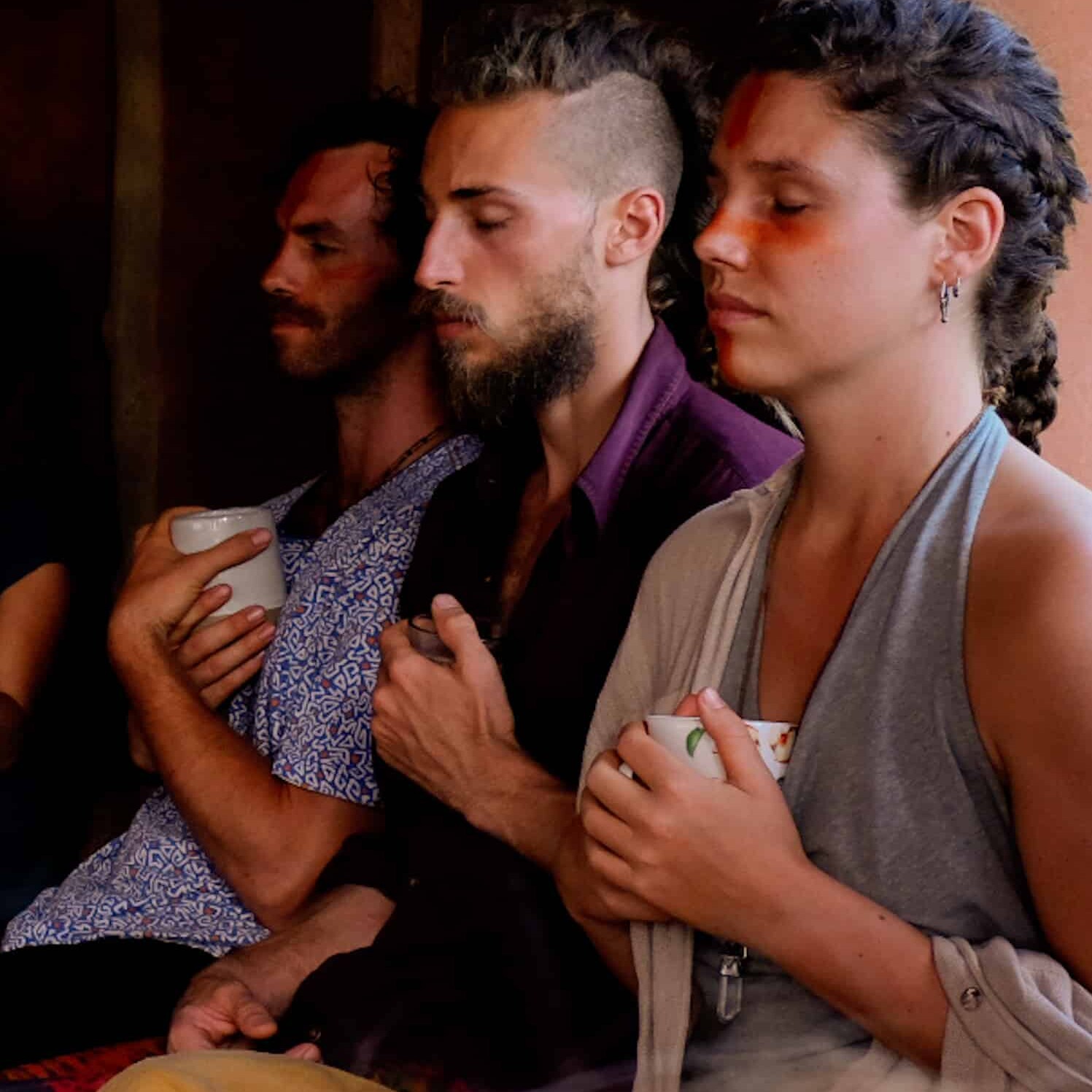
The role of Molinillo
We recommend using a traditional, handmade Molinillo from Mexico. The cocoa whisk has been manufactured and used for centuries and, in addition to frothing and whipping the cocoa, is also used to transfer your intention and energy to the cocoa. By regularly rubbing your hands, the molinillo will start spinning. His carved rings will start beating in your rhythm. In this way you transmit your very own frequency and consciously hand it over to the cocoa.
Ingredients for your ceremonial cocoa
- approx. 150ml of water – alternatively unsweetened oat or almond milk (depending on the cup size and the desired smoothness and intensity of the taste)
- Mellow Magic Cocoa – ½ triangle for a light cup of cocoa, 1 triangle for a regular-strength cup of cocoa, 3 triangles (34 grams) for ceremonial cocoa
- Spices according to your preferences: e.g. B. cinnamon, turmeric, chili or cayenne pepper, a drop of vanilla extract. Chilli is used especially in cocoa ceremonies because it additionally supports the effect of the cocoa.
- coconut blossom sugar if it should be sweet or e.g. date sugar, date syrup, agave syrup, etc.
Utensils for your ceremonial cocoa
- smaller Pot
- Molinillo or whisk (alternatively an electric frother or mixer)
- favorite mug or beautiful cocoa cup
Preparation of the cocoa
Start with about 30 grams of cocoa for your ceremonial cocoa. If you tolerate it well, you can take about 40 grams per ceremony. 11 grams (a triangle) are enough for a simple cocoa in between, without time and leisure, or for a small ritual, for a light cup 7 grams (approx. half a triangle).
- Have all the ingredients ready: cocoa, pot, molinillo, cup and spices if necessary.
- Heat part of the water or plant-based milk on the stove and add the desired amount Mellow Magic Cocoa added.
- Heat the cacao slowly and gently and do not let it boil under any circumstances (otherwise it will become bitter). Stir slowly with the whisk or Molinillo until the cocoa has completely dissolved.
- Slowly pour in the rest of the liquid and rub the Molinillo between your hands until the cocoa has a creamy-frothy consistency.
- Add the spices and, if necessary, the sweetness step by step.
- Take a spoon and taste your cocoa. Maybe add seasoning.
- Pour the cocoa into your cup and enjoy it consciously. Feel how it warms and enriches you from the inside out.
- Take a glass of water with it, because cocoa makes you thirsty.
Your cocoa ceremony - tips, preparation & implementation
Think of a suitable place for your cocoa ceremony and set it up. This can be a (tidy) dining table or coffee table in the living room or your favorite spot on the floor or in the garden. You can decorate the place of the ritual with a nice doily or cloth. I love to decorate it with plants, flowers, seeds, shells. I make sure not to damage any plants, but rather collect what I find on the ground seasonally.
To enjoy the ritual with all your senses, you can smoke with Palo Santo beforehand or use an incense stick. Candles and dimmed, pleasant light are also part of it for me. In addition, you can add a personal valuable, a figure, a piece of jewellery, a photo, a special feather to create a "sacred space".
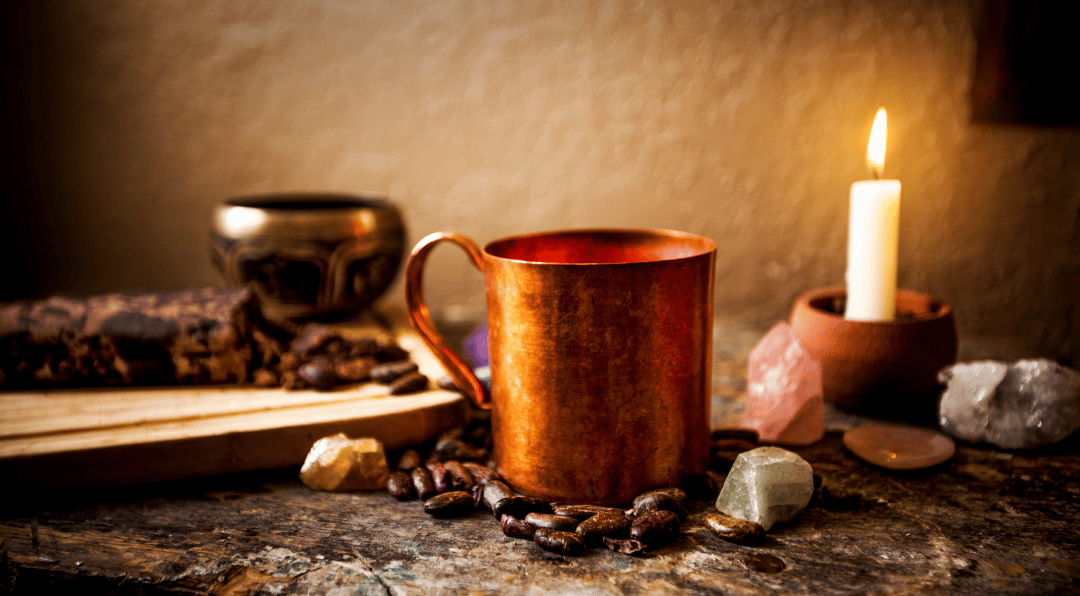
The easiest way to repeat the cacao ceremony is to have a fixed location and keep all the ingredients within easy reach. Of course, you can also simply sit down in a nice place with a cup of cocoa without any "extras" or take it out into nature in your hand.
Choose some relaxing music to listen to in the background during the Kakao Ceremony. There are nice playlists for the cocoa ceremonies on Spotify. Calm meditation music with nature sounds, gentle mantra music or steady drum beats are also very suitable for this.
Set the duration of your cocoa ceremony beforehand so you don't have to check your watch or cell phone. 20-35 minutes is a good time for your cacao ceremony.
Give your ritual an intention. Say or write down what you long for. You may want to let go of a pain, fear, or dissatisfaction. Formulate a sentence about what you want to bring into your life (positive orientation) and place the leaf in the center.
Be loving with yourself. Let go of ideas and expectations of you, your feelings and the effect of cocoa on you. Expect nothing and be okay with what is there. Realize that everything is fine the way it is right now. That you are where you are supposed to be, that things/ people/ situations leave you because they no longer belong to you, you no longer need them. Realize that you are the creator of your life and look forward to everything that is yet to come. The cocoa plant acts as a medicinal plant in and with your heart space and is said to strengthen harmony, love and unconditional self-acceptance in your life. Cocoa, or "Mama Cacao", will ground you with its gentle, loving powers and support you on your way.
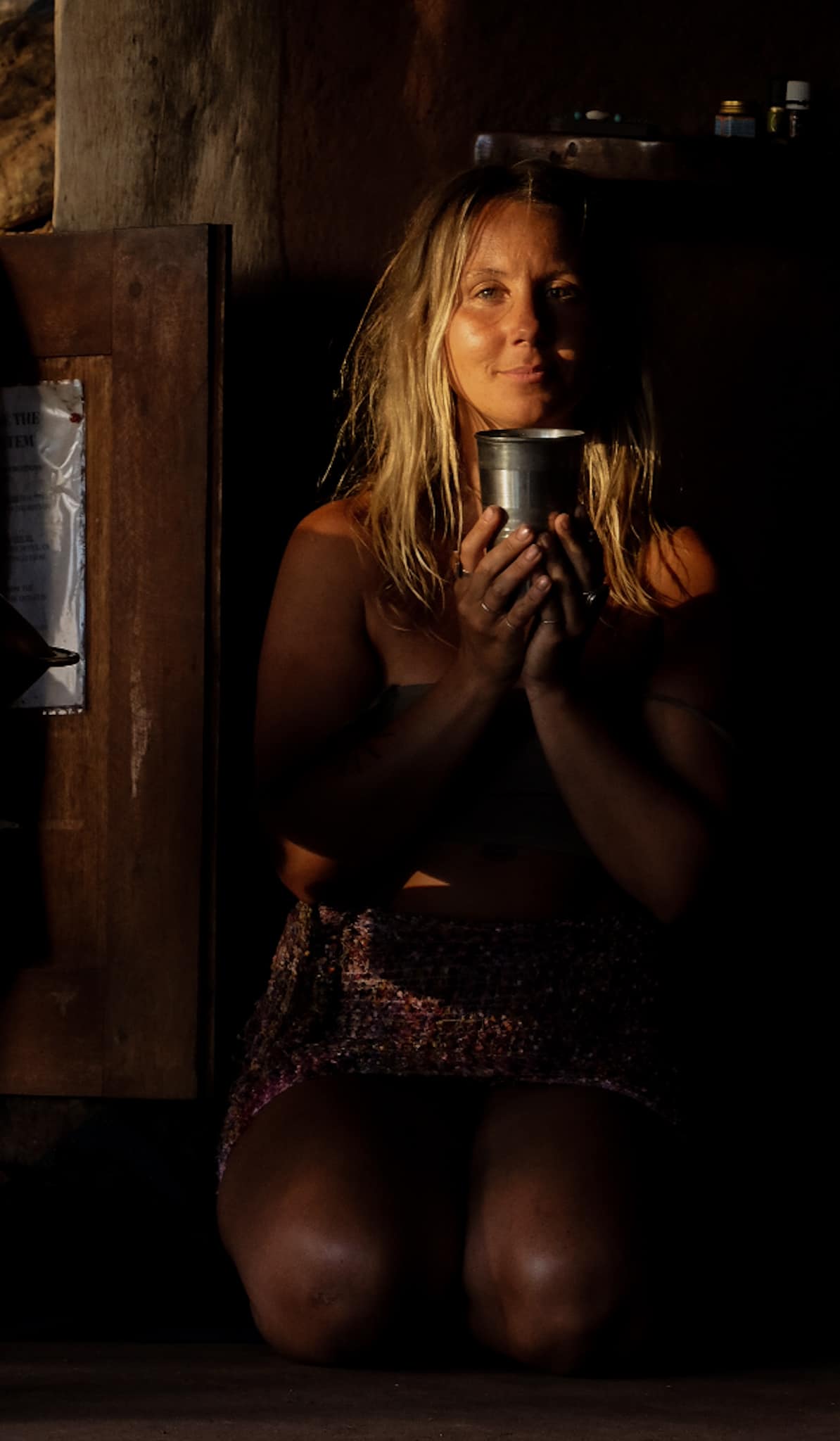
Consciously end your cocoa ceremony when the time is up. Close your eyes, remember your intention and empower yourself with these thoughts. Thank Mama Kakao and thank you (and all participants) for this beautiful ceremony. Send loving thoughts to your loved ones and open your eyes with a smile. Räkel and stretch and arrive consciously at you and in the day.
Cacao ceremonies are also a wonderful group experience. All participants sit in a circle around the center. If you wish, you can share your thoughts and intentions for the ritual beforehand. After a short meditation together, the cocoa is then slowly drunk. The cocoa ceremony is often combined with a subsequent ecstatic dance. Cocoa has a stimulating effect, especially in combination with chilli/chilli water and, combined with music, can lead to an intoxicated, very liberating feeling.
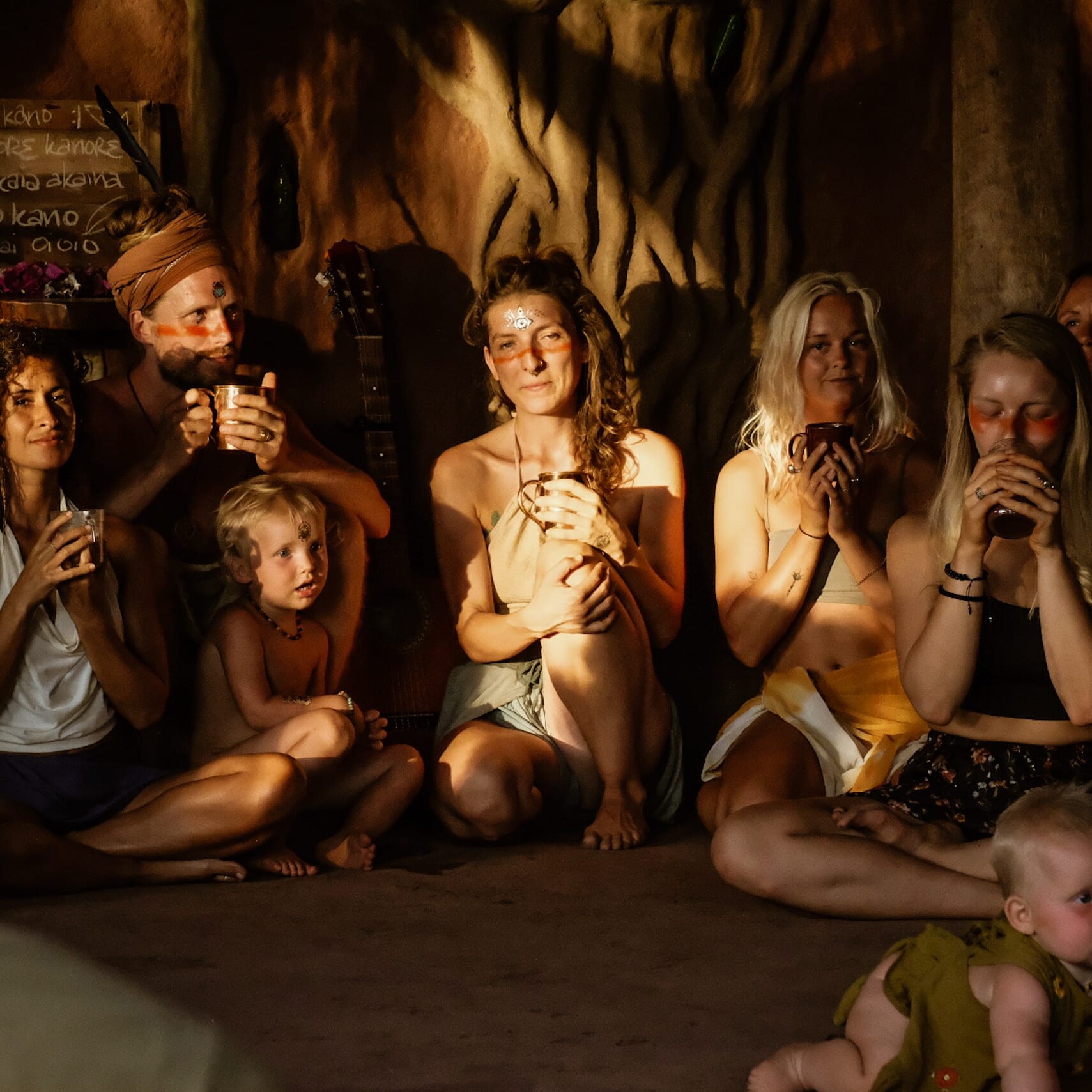
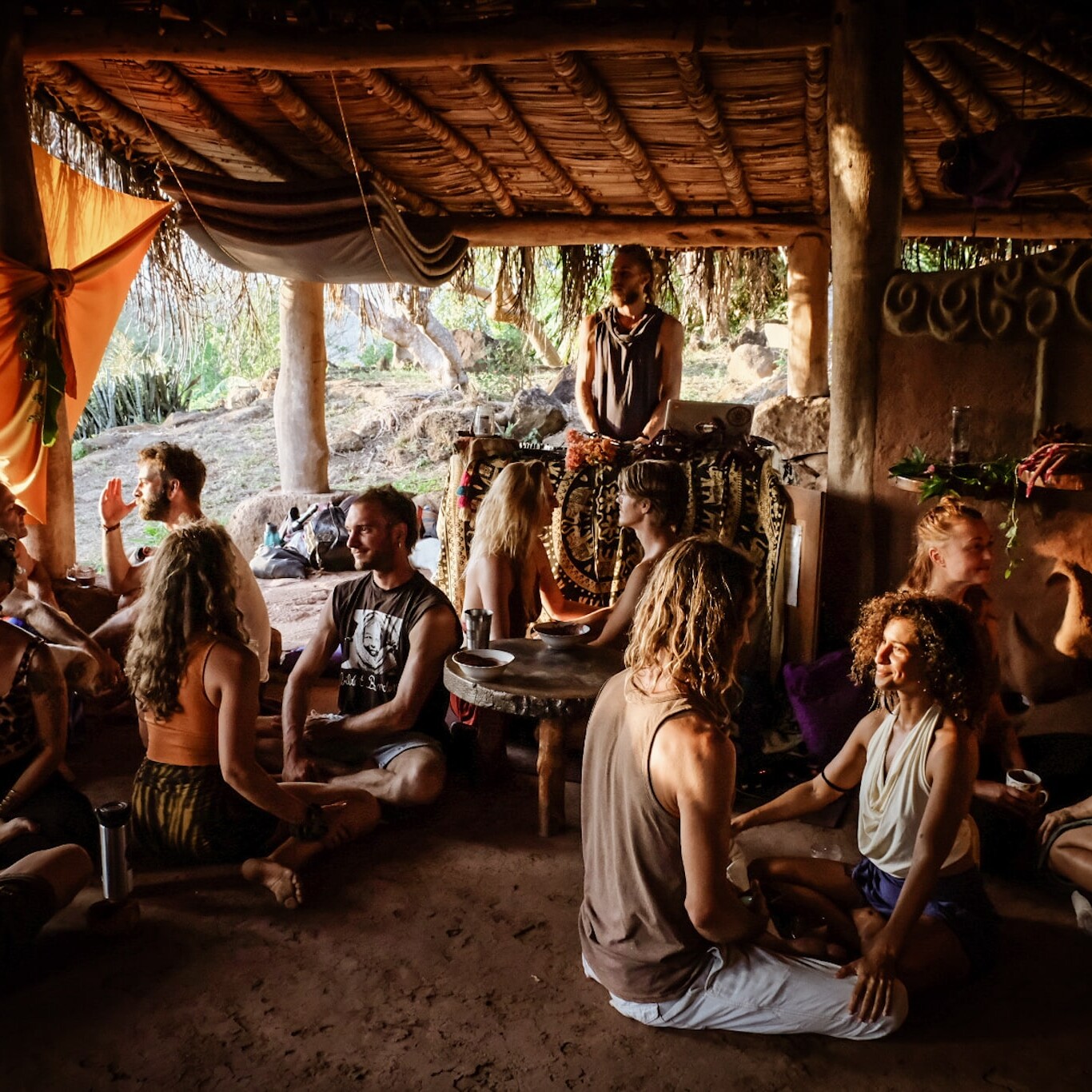
A fourth generation Molinillo family workshop
We always work, because it is less a tiresome work than a fulfilling life.
Jesus Gomez Torres
Oaxaca de Juárez is the lively, colorful capital of the Mexican state of Oaxaca and is located in a valley of the Sierra Madre del Sur at around 1550 meters. There it happened that we finally fell for cocoa, as our long-awaited one Tabasqueno Mellow Magic cocoa arrived at our bright orange house in the middle of the city. We unpacked the cocoa, drank it and literally melted away. We hadn't drunk anything that good in a long time. It was immediately clear to Wallo and me that one of our Selection products, has to be about this beneficial liquid, which we wanted to devote ourselves to from now on. Nothing was more obvious than the Molinillo - a traditional cocoa whisk and Mexican craftsmanship through and through.
What is a Molinillo and where does it come from?
First came the research, because we didn't know for a long time that this chic, hand-carved wooden stick, which is traditionally used to froth cocoa, was called "Molinillo". We scoured the World Wide Web for "cocoa spoon" and found nothing. It was not until "Kakaoquirl" that the first references to its actual name, the Molinillo, and with it information and background information about its use, came.
A molinillo is a utensil with a long history, having been made in Mexico for centuries and used to cream and foam cocoa drinks. About 4000 years ago the Omelek invented the kakaw, which was cultivated by the Maya around 2,500-3,000 years ago. By around 1400 AD, a cocoa drink was an essential part of Aztec culture, which they xocolatl called. Originally, plants and simply wooden sticks were used to stir and froth the cocoa. Then, in the 17th century AD, the Molinillo as we know it today was invented by the Spanish colonists in Mexico to facilitate the preparation of their cocoa drink. Since then it has been manufactured and used by hand.
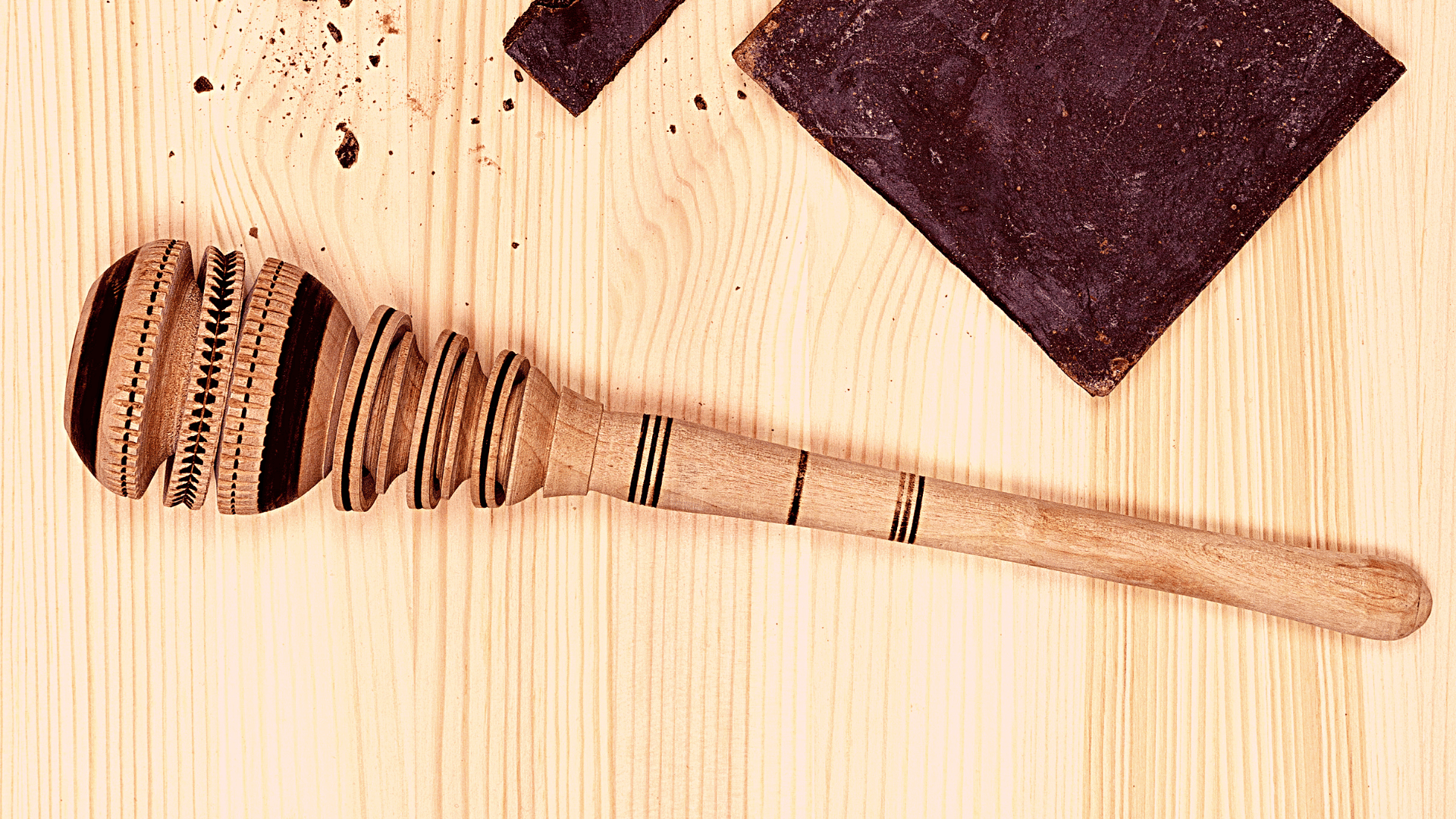
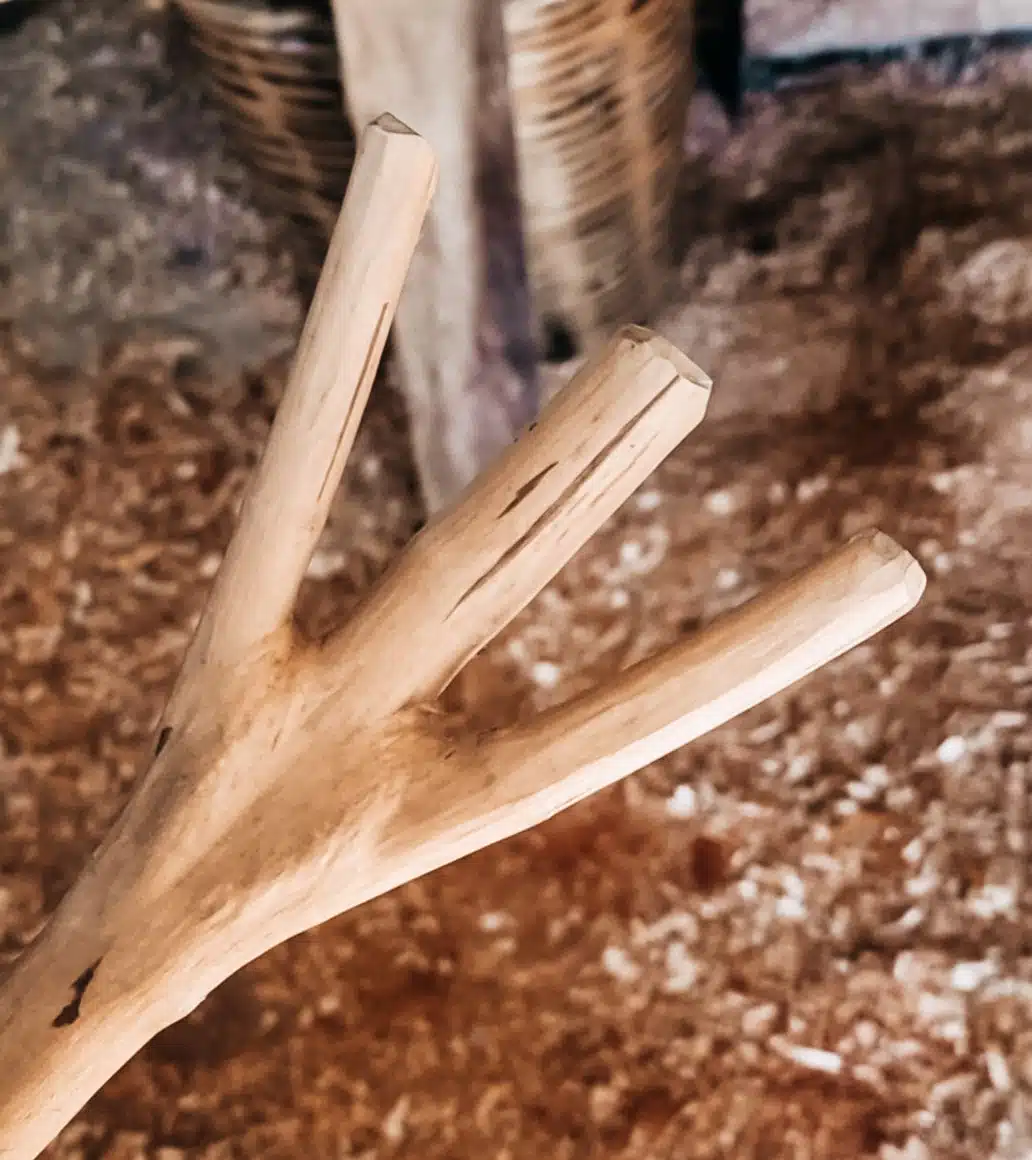
How do you use a Molinillo?
While the water or plant-based milk for the cocoa is slowly warming up in the pot and the cocoa begins to melt, the molinillo is used to stir and crush the cocoa mass to further dissolve the cocoa. When the cocoa has completely melted, take the Molinillo between your palms and start rotating it rhythmically while rubbing your palms together. The texture of the Molinillo gently froths the cocoa while the wooden rings on its shaft set the rhythm as it spins.
Set the right intention
Traditionally, especially in cocoa ceremonies, it is important to use the molinillo with the right intention. Before you start spinning, you should collect yourself, close your eyes, concentrate on your heart space and connect with yourself and your field. Then you start to turn the Molinillo in your own rhythm and your own frequency, as well as the frequency of the set intention, is transferred via the Molinillo to the cocoa, which you then consciously consume and drink.
It all depends on the right Molinillo
Wallo and I are convinced that a product is never just a product, but that the frequencies of its materials and manufacturers are part of it. It was therefore particularly important to us that our Molinillos (like all products from our Selection) are made by hand and with love, under fair conditions and with a conscious and respectful use of natural resources.
Wallo and I then spent hours in the crowded market of Mercado Benito Juárez in Oaxaca. It wasn't enough for us to buy a Molinillo there, we wanted to go to the source. We wanted to get to know the craftsmen behind the market stalls and see and understand their work. It is of course difficult to gain the trust of the market traders as an unknown "gringo". That takes a lot of time and patience, but we didn't have much time in Oaxaca de Juarez at that time. But when I hold on, I hold on and don't give up. I researched and researched and finally found a name: Jesús Torres Gómez, a fourth-generation miller who makes Molinillos. "This is our man!" I thought immediately and we wanted to meet him and his family! In the middle of the research flow, I soon found an address in Las Ánimas, Santa Catarina Ixtepeji, about 1.5 hours drive from Oaxaca in the mountains of the Sierra Madre highlands. How fortunate that almost everything in Latin America can be managed with a messenger program. I found Jesús Gómez Torres' number, wrote a devotional text in broken Spanish and got a reply the same day! I cheered with joy and anticipation, because the next day Wallo and I were allowed to visit Jesús, his family and his small workshop in the mountains.
Jesús Gómez Torres and his family
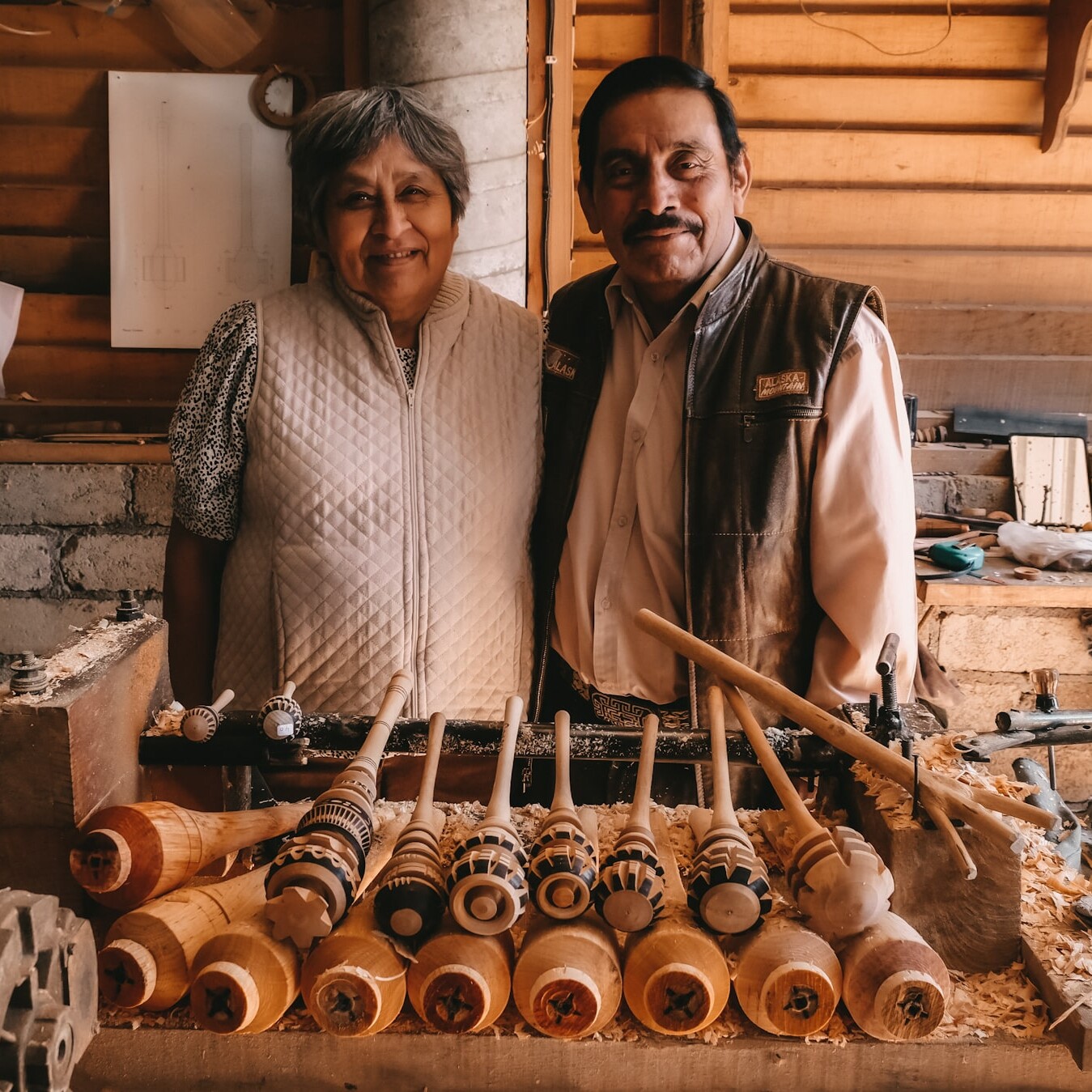
Jesús Gómez Torres, a mill craftsman, is originally from Las Ánimas, Santa Catarina Ixtepeji. Together with his wife, he embodies the third generation in his family dedicated to the production of Molinillos. His children work voluntarily and are already the 4th generation of the small, traditional family business. When we arrive at Jeus's, the first thing we notice is the unbelievable calm of this small piece of earth in the mountains. She calms my pounding heart. My Spanish skills are (still) rudimentary and the result of two rather lazy school years 20 years ago. I'm afraid I won't be able to express myself enough and clutch my notepad with my pre-written Spanish texts tightly.
The air smelled pleasantly fresh, of flowers and pine trees, mixed with the smell of a wood fire heating a kettle in a small stove. The sun pleasantly warms our skin and peace spreads through us. My tension disappears completely when Jesús and his wife Arminda run out of a small, crooked building towards us, beaming. His eyes are big, dark and the wrinkles make us smile, along with his dark mustache. He is shorter than me and wears a large, typical Mexican cowboy hat with a traditional leather vest. He leads us into the crooked building made of wood, corrugated iron and mud and my nose is filled with the smell of freshly cut wood. Arminda smiles shyly at us, while Jesus gets straight to work and proudly raves about himself, his work, his craft and his family - and rightly so.
“The work was started by my grandfather, he taught it to my father and uncle. My father taught me and my brothers to carve wood and in 1970 we started working with lathes powered by electric motors."
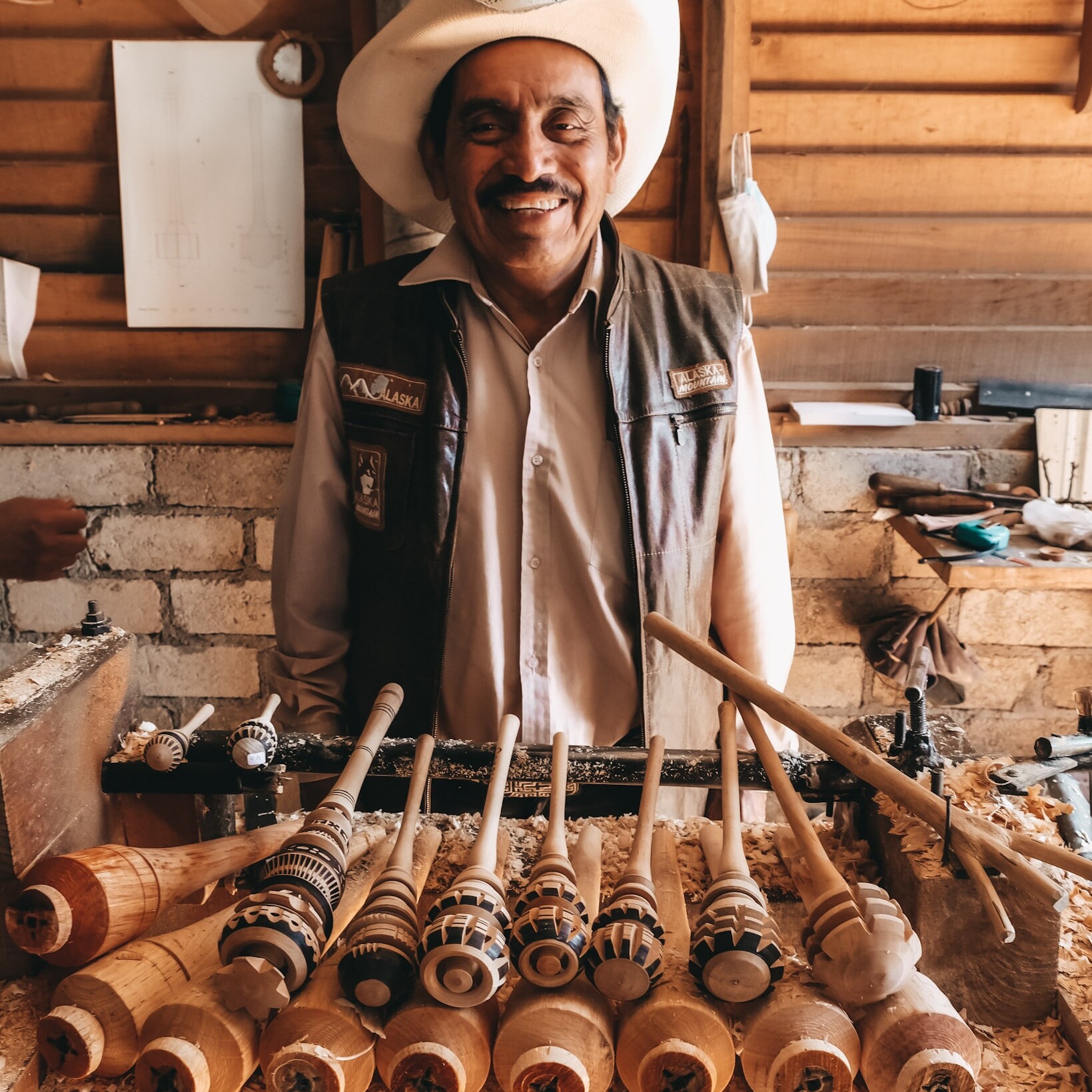
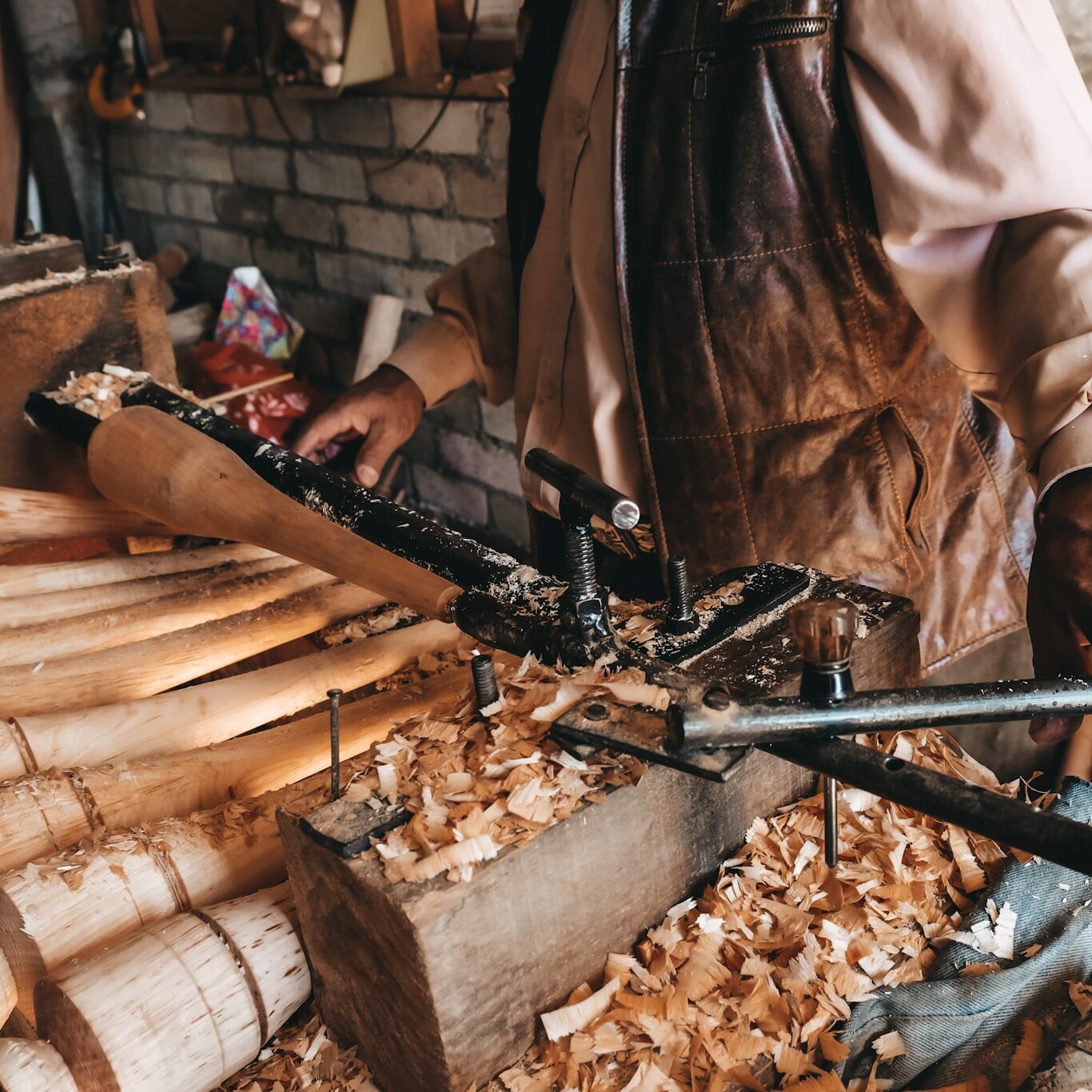
Everyone works under Jesú's leadership, his wife Arminda, his brother-in-law Evencio, his daughter Sandra and occasionally his niece. Jesús tells us that he learned the art of carving pine by hand from his father when he was nine years old. Jesús later studied at high school in the city of Oaxaca, where he discovered that there were lathes that could make his father's job easier. But it wasn't until the 1970s that electricity came to his community. With electricity, he was finally able to start working with lathes, revolutionizing the small family business. Thanks to this lathe, they began to increasingly produce the Molinillo, the product that they sell the most today.
The manufacture of the molinillo
Jesús Gómez Torres and his family work with different types of wood, such as jacaranda, which they source in the central valleys, and ash and ail wood, which they source from certified sawmills in the Sierra Madre. He only uses wood from trees that are marked for felling. Don Jesús is a guardian of his forests, he explains, and is opposed to illegal felling of trees. The wood he works with is certified, which is very important to him. He is the one responsible for choosing the right wood for his production, he explains to us seriously.
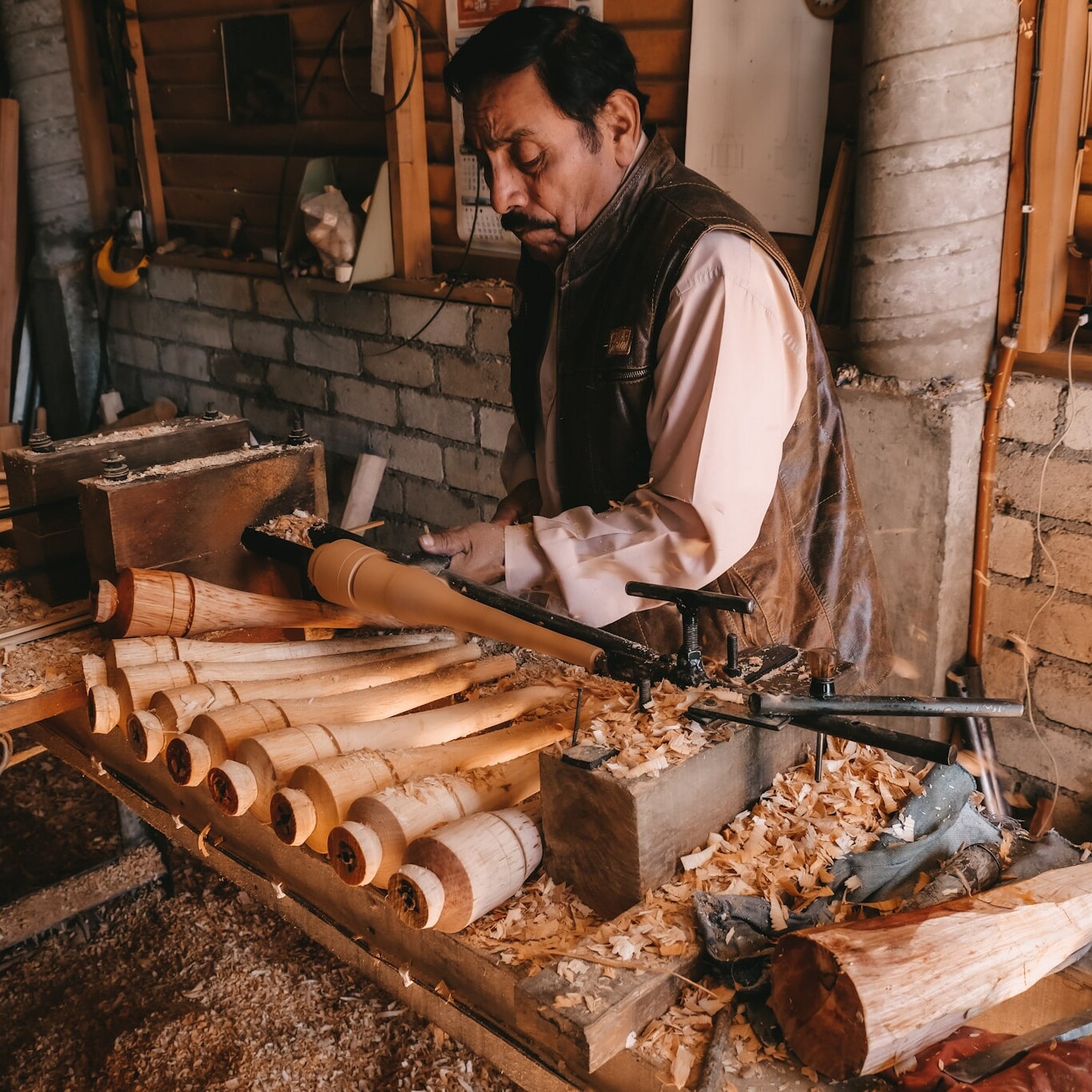
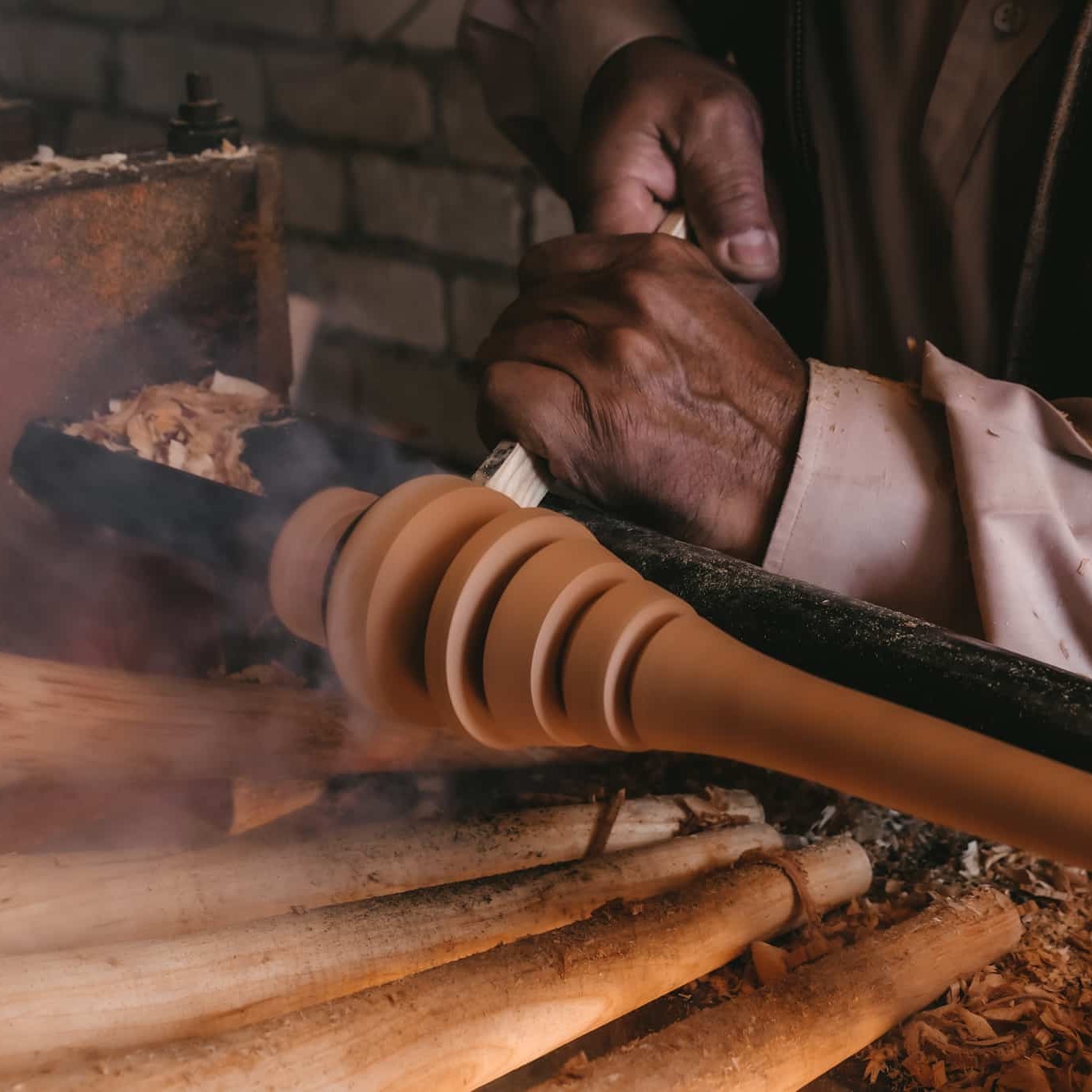
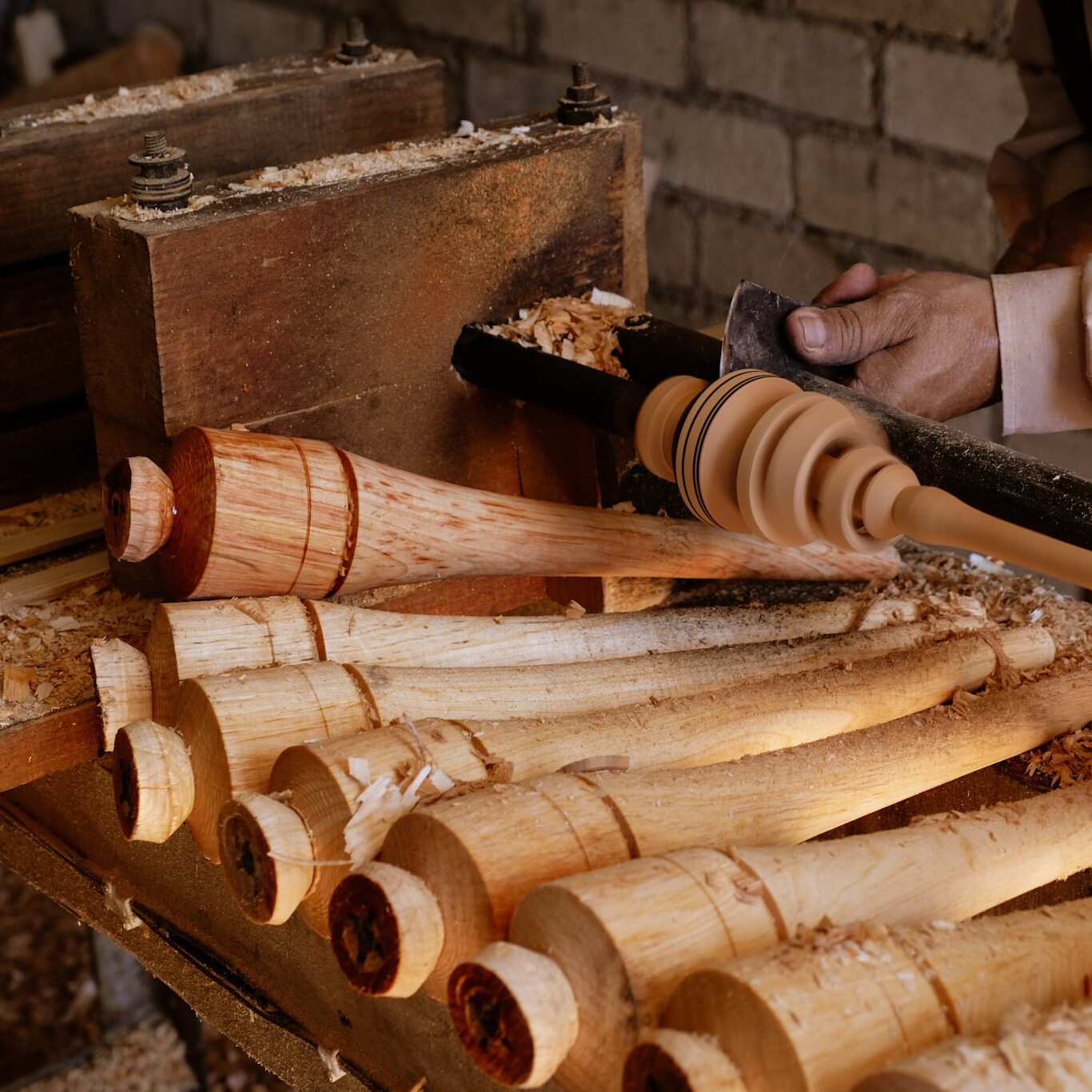
Don Jesús takes off his hat and shows and explains how he makes a Molinillo. After he personally selects the wood, the most difficult thing is to cut the hard wood into smaller pieces that are suitable for further processing. His brother-in-law, Evencio, roughly cuts the pieces and prepares them for the lathe that Jesús uses to make different types and sizes of molinillos. His wife Arminda decorates the wooden utensils by burning beautiful patterns into them. Meanwhile, his daughter Sandra takes care of the molinillios, which are used less for decoration than for use, and lovingly paints them in bright colors and patterns. We feel that it is very important for Jesús to demonstrate his work. He shares how in the past, to sell his products, he had to find customers and walk into town from his community. That was a whole day's journey. Now it's the customers who drive from the city to his workshop and he smiles proudly.
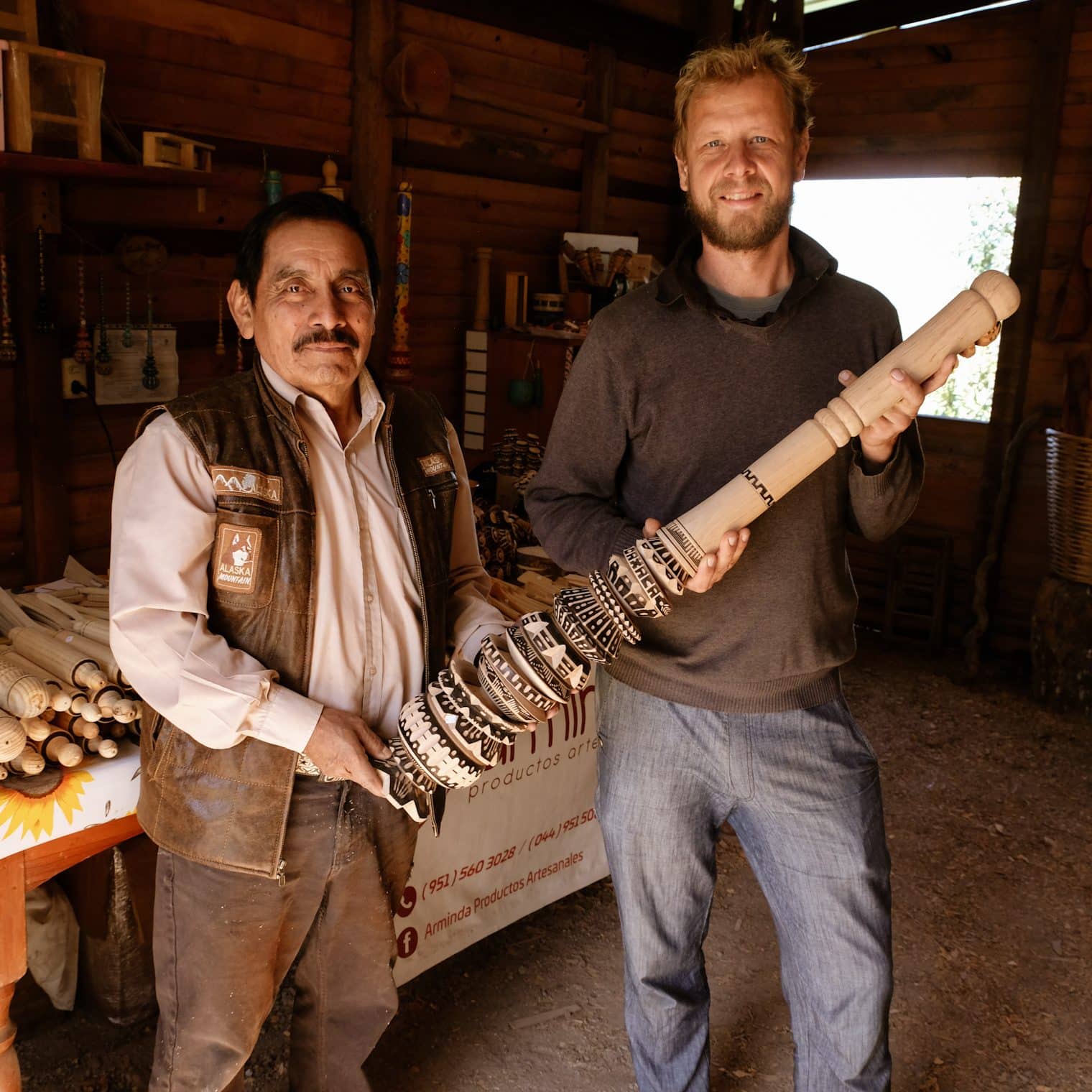
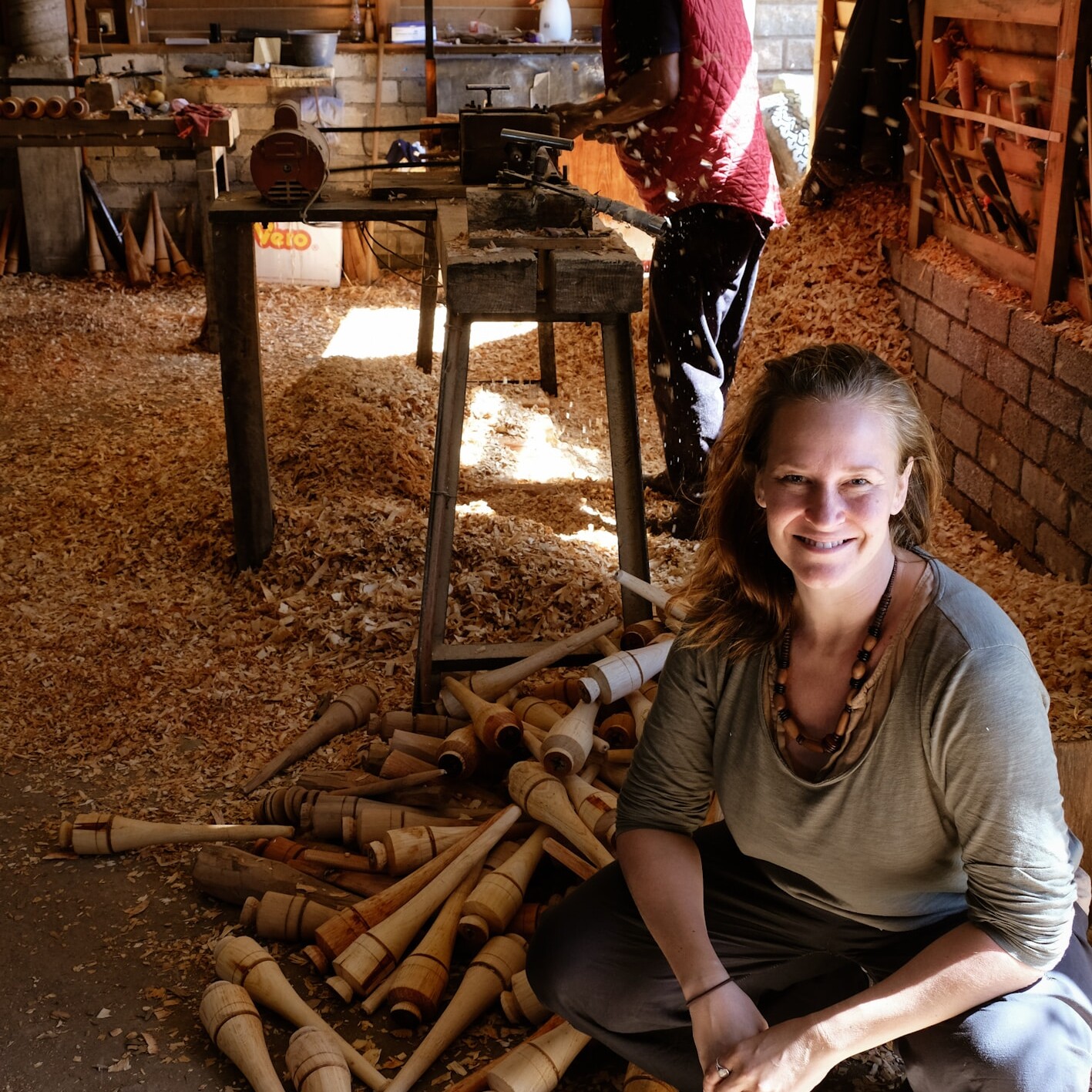
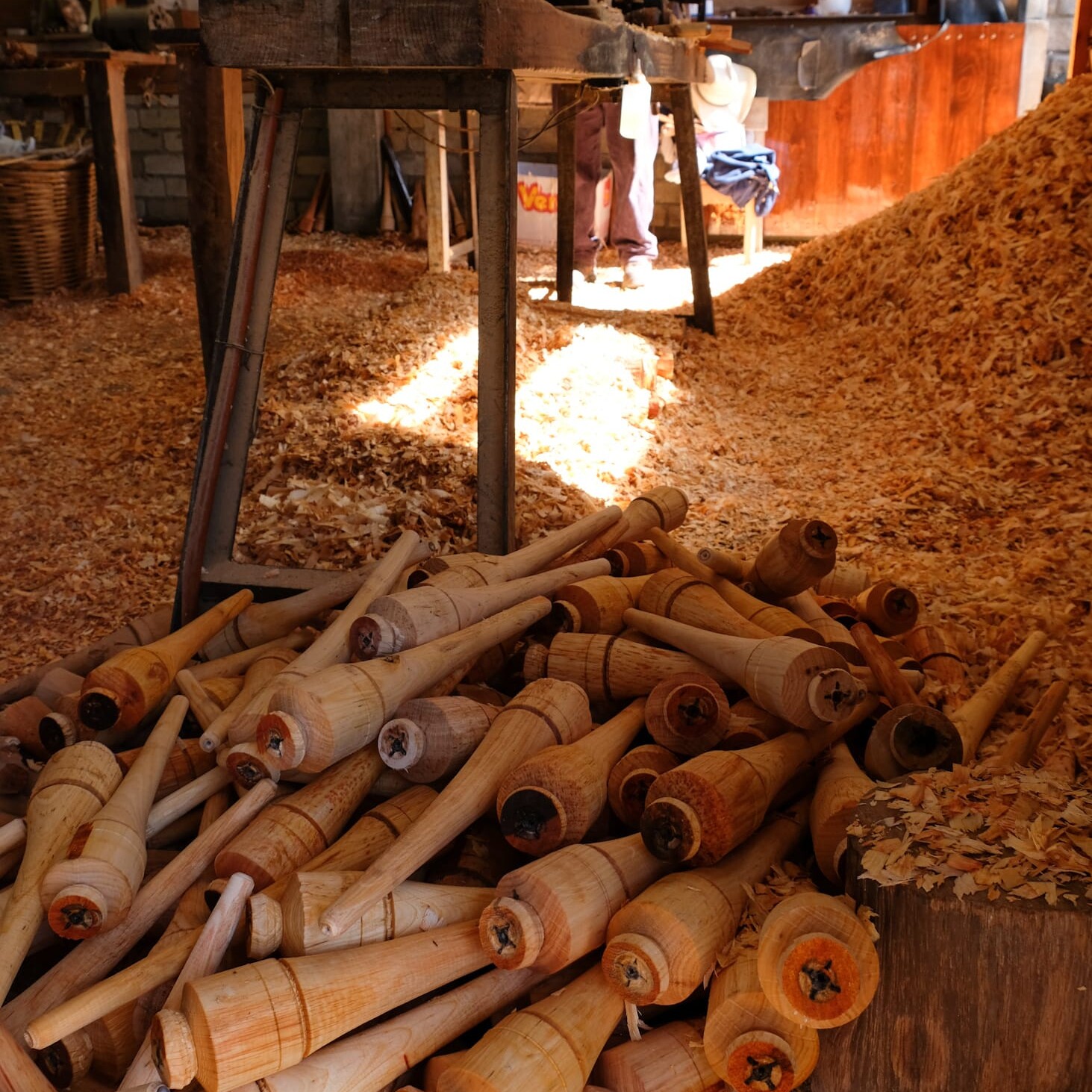
Don Jesús demonstrates his passion for his craft with the care he puts into each of his pieces and with the pride and almost childlike joy as he talks about his work. "We're always working," he says. "because it is less a tiresome work than a fulfilling life for us". Wallo and I can only understand that. Everything here seems peaceful, loving, relaxed. We can't help but imagine having a small workshop ourselves, where our hands work while our minds switch off, surrounded by equally wild, soothing nature. We leave the workshop and go into the small garden filled with flowerpots and Jesús concludes by saying: “It gives us great pleasure to teach our children and grandchildren the technique and tradition of making molinillios, here, in our small workshop. Now we offer our customers the best. I intend to continue doing it because I really enjoy it and I've gotten my kids interested too.”
Arminda brings us freshly picked pears and 2 stools. We sat down and enjoyed the fresh fruit. Wallo and I smile. It cannot be overlooked that everyone enjoys their work here. We are incredibly lucky to have had the opportunity to meet and get to know Jesús Torres Gómez and his family. And we are most pleased that we can now share their story with you and thus actively and directly build bridges between their traditions and their handicrafts and our western culture.
Would you like to give your life a new depth with our cocoa and the Molinillios made by Jesús and thus support this project and his family?
We are very happy about your purchase!
Fine flavor cocoa vs. consumer cocoa – What is the difference?
Anyone who has ever drunk real cocoa will certainly not want anything else. It is by no means a coincidence that it tastes so deliciously like chocolate: cocoa is the raw material from which the treat is made. But what is real cocoa?
In the supermarket you can find cocoa powder, baking cocoa, organic cocoa, raw cocoa, cocoa drinks and much more. But what is the difference? What makes really good cocoa and how do I recognize real fine flavor cocoa? There are few things that connoisseurs of cocoa and chocolate agree on: nothing has a greater impact on the taste of cocoa (and chocolate) than the quality of the cocoa beans used and the way they are processed, so that the cocoa can unfold its healing, invigorating and health effects.
The origin of cocoa
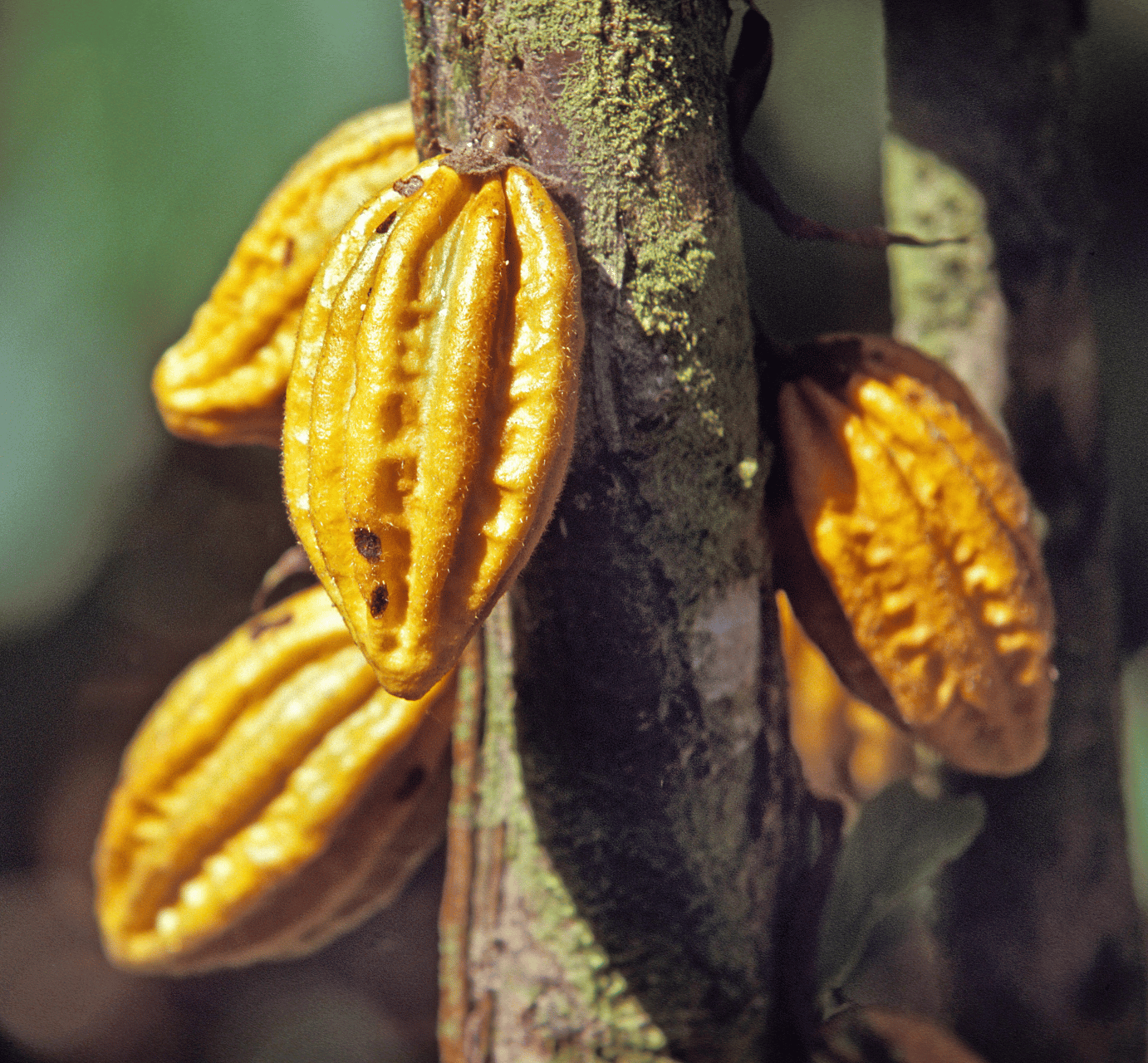
The origin of the cocoa is essential if you want to consume cocoa with positive energy and unique quality. The cocoa plant (Theobroma cacao) grows in the tropical rain forest. The climatic conditions only exist near the equator. As a shade plant, it grows in the lower tree layer of the rainforest, below other shade-giving plants and trees. Cocoa originally comes from Latin America, but today it is mostly grown in West Africa (especially Ivory Coast and Ghana) and Indonesia. Consumer cocoa in particular is often grown in monocultures. These have a disastrous effect on the environment, on wildlife and on the quality of the cocoa itself, due to the use of vast amounts of pesticides and stress on the tree. here you will learn more about the different ways of growing cocoa and their impact on the environment and taste. In mixed cultures, for example together with banana or other fruit and spice trees, as is the case with our cocoa project Selva Zoque is the case, cocoa feels most comfortable. The higher the biodiversity, the finer and more complex the aromas the cocoa develops, the better the taste and the greater the chance for our rainforests.
fine flavor cocoa and consumer cocoa
Although there are now many more secured cocoa varieties, such as old and recultivated varieties as well as new breeds, the public usually only talks about consumer and fine flavor cocoa. In the cocoa trade, fermented and dried cocoa is divided into fine flavor cocoa and consumer cocoa according to its origin and aroma properties.
The cocoa varieties
There are roughly three different types of cocoa: Forastero (consumer cocoa), criollo(fine cocoa) and Trinity (also a fine flavor cocoa, but more productive).
- The consumer cocoa, Forastero, is one of the highest-yielding cocoa varieties and accounts for over 90 percent of world production. It is less aromatic and sometimes bitter or sour. Nevertheless, due to its robustness and its high yields, the Forastero is of the greatest importance for the world market and is cultivated in all major producing countries.
- the fine flavor cocoa, criollo there are, with only a few exceptions, in South and Central America. The Criollo is considered the noblest of the fine flavor cocoas. It is usually slightly acidic, hardly bitter and, in addition to a mild cocoa taste, has pronounced side aromas. The aromatic fine flavor cocoa varieties are cultivated using sustainable methods and are therefore only available in limited quantities. This explains the significantly higher price (up to 10 times more) for fine flavor cocoa on the market.

Reality is colourful
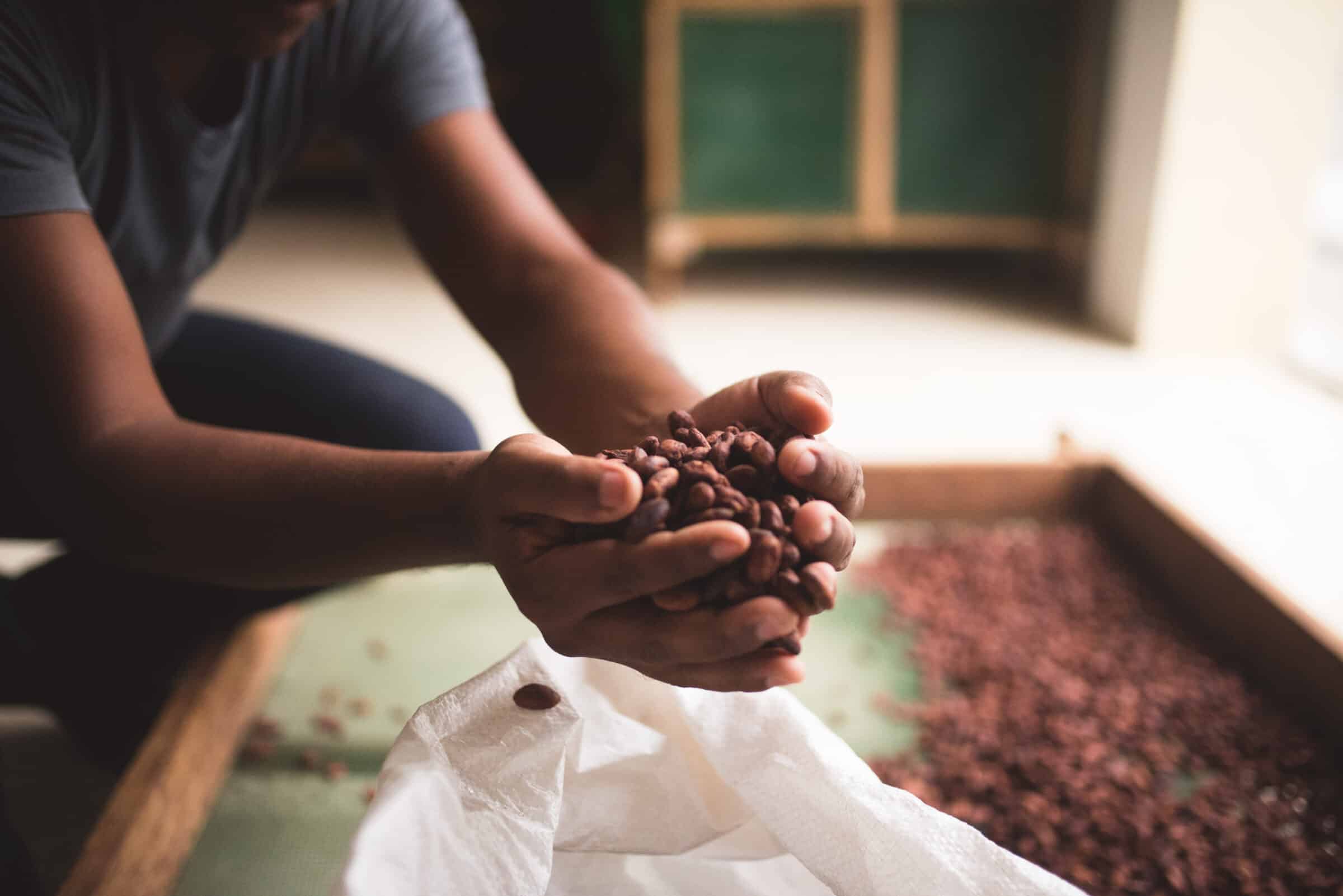
So much for the theory, the reality is more complex, colorful and even more aromatic! Cacao grows outdoors, partly wild, mostly with unclear origin. In many countries, the quantities harvested by the local cocoa farmers are mixtures of different cocoa varieties. This is often part of the appeal of certain cocoa regions - examples include the famous one Tabasqueño fine flavor cocoa from the Selva Zoque, whose delicious cocoa mass we are very proud to offer you here, or the Chuao region in Venezuela, whose cocoa mix achieves prices beyond pure criollos on the world market. In addition to the origin of the bean, the entire processing and fermentation process is essential when it comes to exceptional taste!
Ceremonial fine flavor cocoa from Mexico - A cocoa project for the rainforest
Reise mit uns in eine der ursprünglichsten Kakaokulturen der Welt: in die Sierra Madre de Chiapas, Mexiko, in das Gebiet des Selva Zoque. Die Region gilt als die Geburtsstätte des Kakao, denn der Kakao wird von den dort lebenden Tzotzil- und Zoque- Stämmen seit über 4000 Jahren angebaut, kultiviert und konsumiert. Die alten Zoque und ihre Vorfahren – die Olmeken – erfanden hier das für sie heilige Getränk aus einer ganz besonderen Waldfrucht, die sie „Kakaw“ nannten. Doch nicht nur das, die Region gehört außerdem zu den größten und ökologisch bedeutendsten Regenwaldgebieten Mexikos. Kein Wunder, dass wir hier ein Kakao Projekt gefunden haben, dass sich nicht nur dem ökologischen Anbau von feinstem Edelkakao widmet, sondern vor allem auch den Regenwald schützen möchte. Wie? Das erfährst du in diesem Beitrag.
A vision is born
In the spring of 2014, two friends were exploring the old cocoa country and rainforests of Tabasco and Chiapas in southern Mexico: Hugo is an agronomist and his friend Anders works for the sustainable chocolate company Original Beans. Together they visited the local farmers and cocoa farmers of the Sierra Madre de Chiapas and tasted the local cocoa varieties. The indigenous tribes of the region have been cultivating cocoa for their own needs for thousands of years, as the plant is considered a medicinal plant. They can hardly cover their living expenses with the cultivation and sale of their cocoa, because they cannot keep up with the prices of industrial cocoa from monocultures. Hugo and Anders want to change that because they are enthusiastic about the quality of the cocoa beans. A common vision is emerging more and more: They want to share this exquisite cocoa with the world, reforest the rainforest and help the local cocoa farmers. The project Agrofloresta Mesoamericana is born, in which the finest fine cocoa is produced in cooperation with the indigenous tribes and at the same time fallow areas are reforested in order to protect the biodiversity of the plants and animals of the rainforest.
The origin of Tabasqueño cocoa
This southern Mexican fine flavor cocoa, commonly referred to as Tabasqueño, is a wild crossing of an old, millennia-old Criollo cocoa from the Olmec, Mokaya and Mayan times and the Amelonado cocoa from the Amazon, which was produced around 1900 by a French family was brought to the coast of Tabasco. Here, in the rainforest-covered highlands of the Sierra Madre de Chiapas, in the Selva Zoque, wild hybridization has been taking place for more than 100 years. The Sierra Madre region is the only place in the world that can be credited with more than 4000 years of uninterrupted cocoa cultivation and consumption. The region is a hotspot for flavorful cacao varieties selected and perfected by different civilizations.
The Selva Tabasqueño is classified as Acriollado cocoa and thus reflects an old local landrace. The mother trees of this rare cocoa variety are now over 100 years old and still intact.
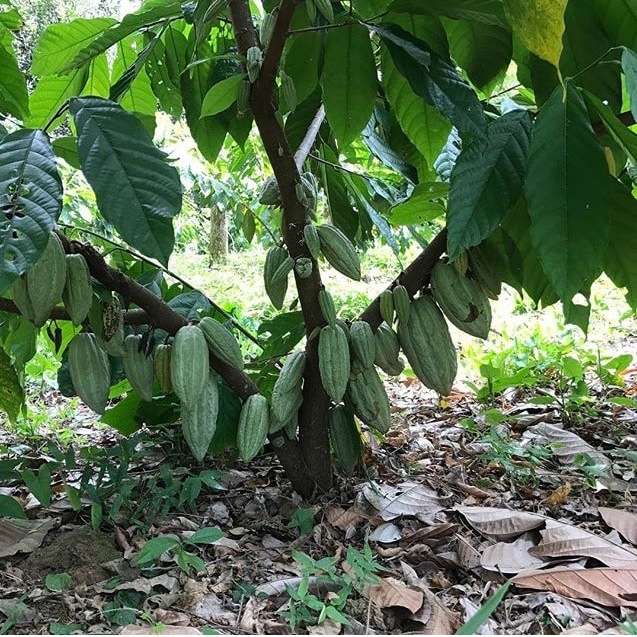
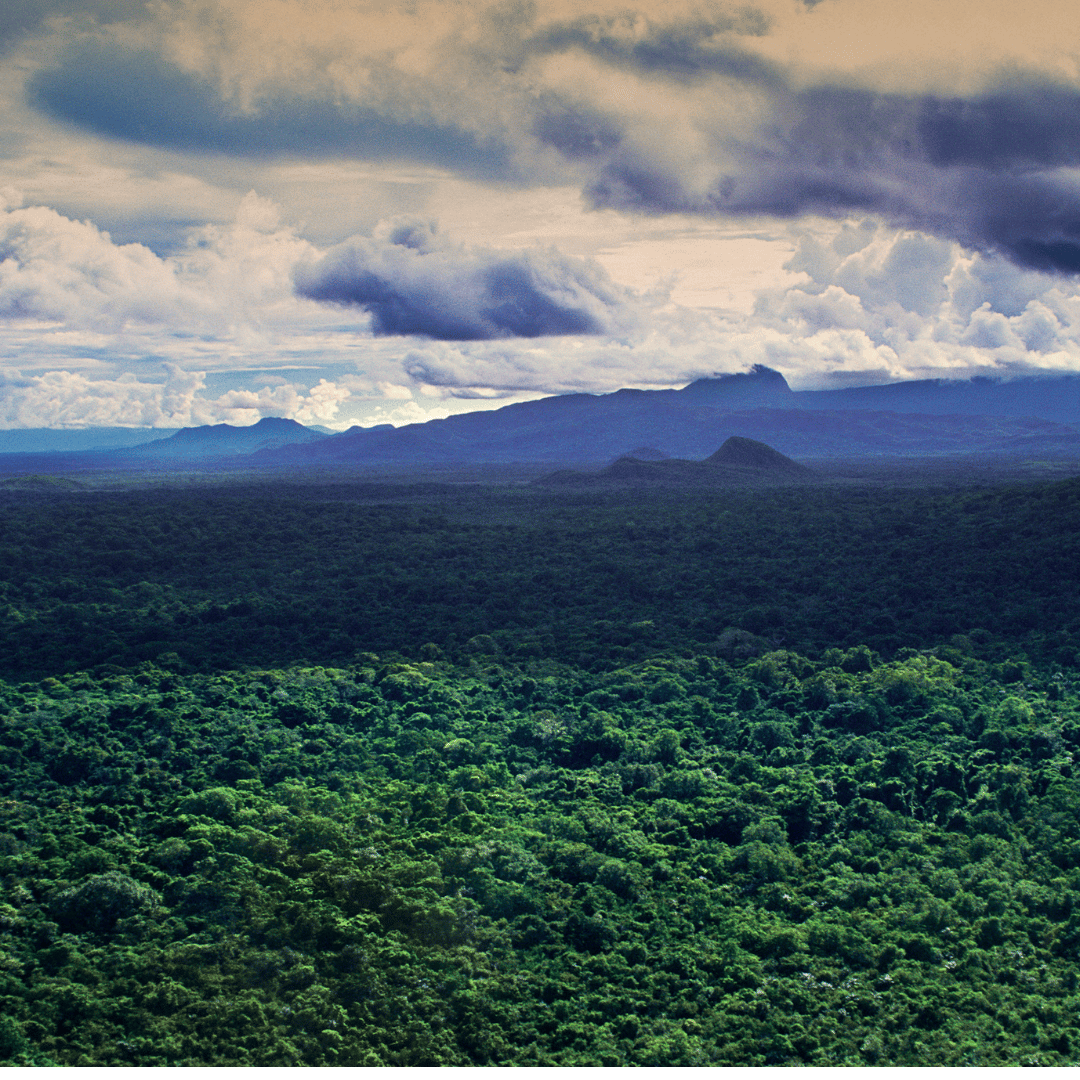
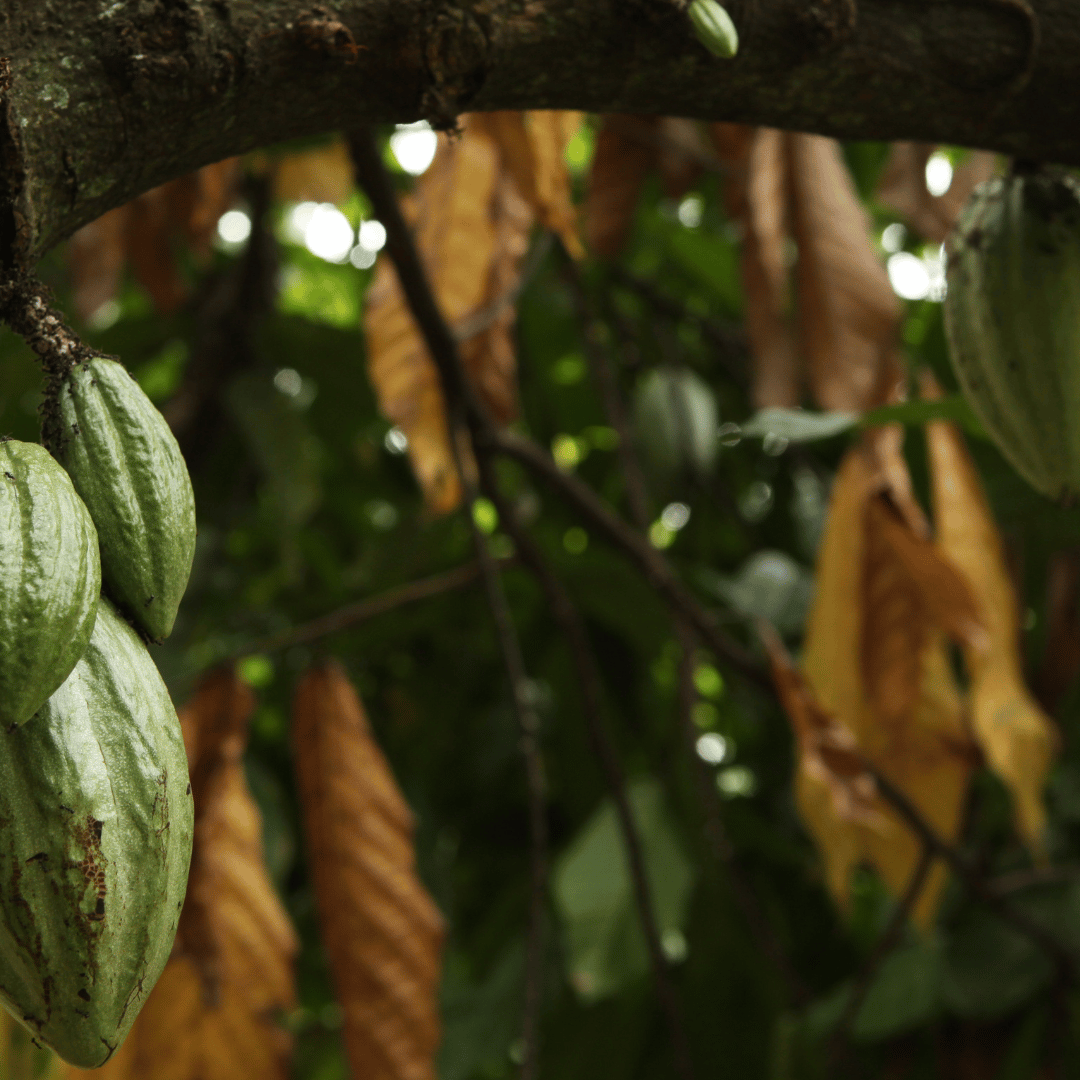
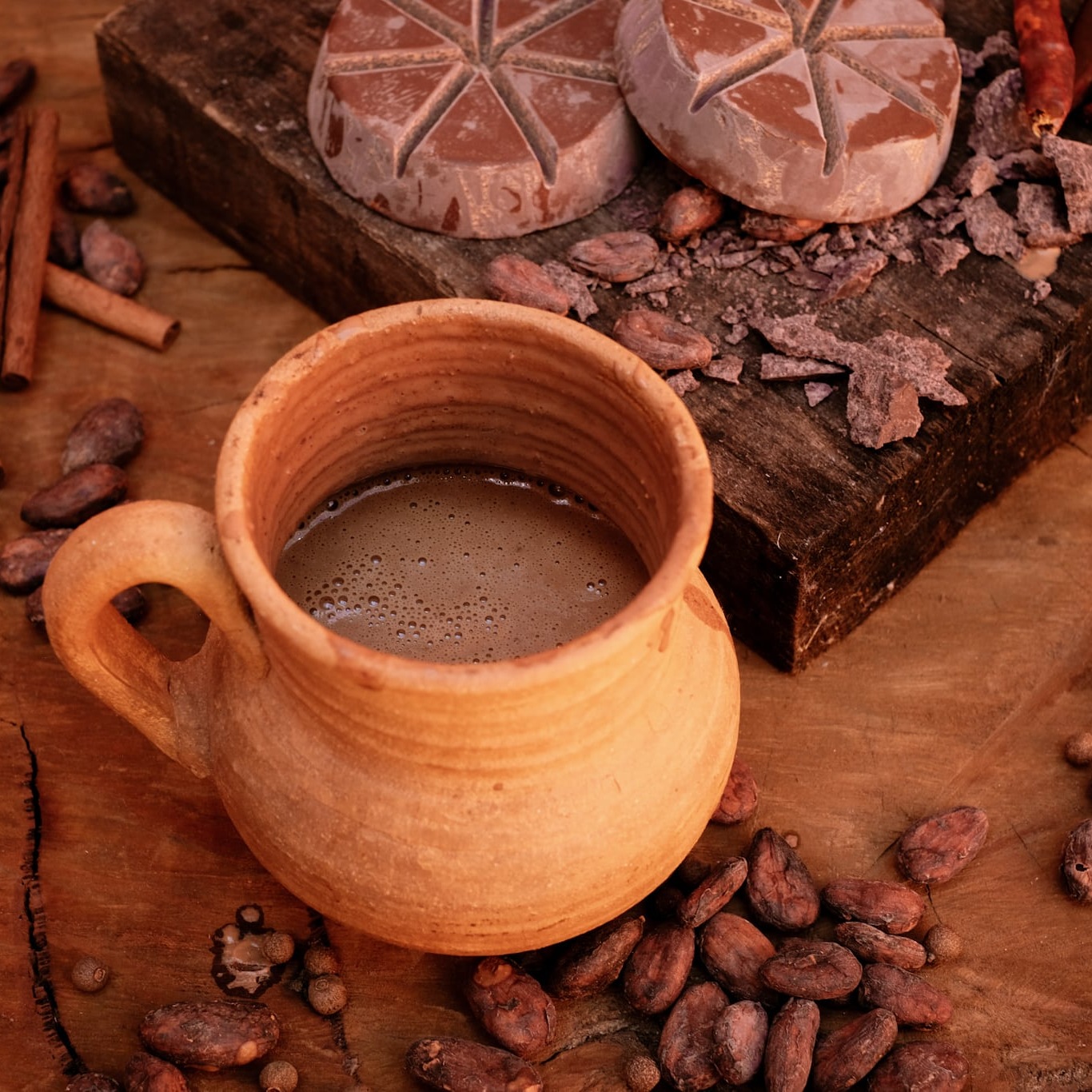
The properties of Tabasqueño cocoa
The Selva Tabasqueo cocoa bean has a very harmonious profile and intoxicates the senses with its spicy notes of chili, cocoa, sweet fruits and a hint of biscuit. The flavors of Selva Tabasqueño cocoa and its ancient genetic traits and spicy-velvety character make this cocoa variety unique in the world. The cocoa is perfect as ceremonial cocoa for ritual cocoa consumption. Compared to other types of cocoa, we immediately noticed how intense this 100%ige cocoa drink tastes without becoming bitter. This is not only due to the quality of the bean, but also to the sustainable cultivation of the cocoa in agroforestry systems. Wallo & I would describe its taste as deep, velvety, soft, creamy, complex and harmonious. It is simply a great pleasure to drink this cocoa slowly and consciously and to feel the warmth.
We meet the projectAgrofloresta Mesoamericana
It was a rush job, as is so often the case with Wallo and me, when we jumped into our rental car at 4 a.m. to drive from San Christobal de las Casas, over the mountains of the Sierra Madre de Chiapas, to Teapa in Tabasco . The ride was impressive and magical. The beautiful, dense green, wildly fragrant, mountainous and rocky landscape of the Sierra Madre of the Chiapas caught us off guard and literally blew us out of our seats. Several times we had to stop, marvel, stare, smell, marvel at the waterfalls and breathe in the earthy, mineral scent of the fresh mountain rainforest. We didn't have much time, so we jumped back into our car seats in a hurry to continue driving. In Teapa we would like to get to know a very special project that not only produces high-quality, ceremonial fine flavor cocoa, but is also dedicated to the reforestation of forests, the support of local farmers and ecological, chemical-free agriculture. After a 6-hour drive we reach the tropically hot town of Teapa and finally meet Hugo, a cocoa farmer and economist, as well as a specialist in ecological agroforestry and founder of the project Agrofloresta Mesoamericana.
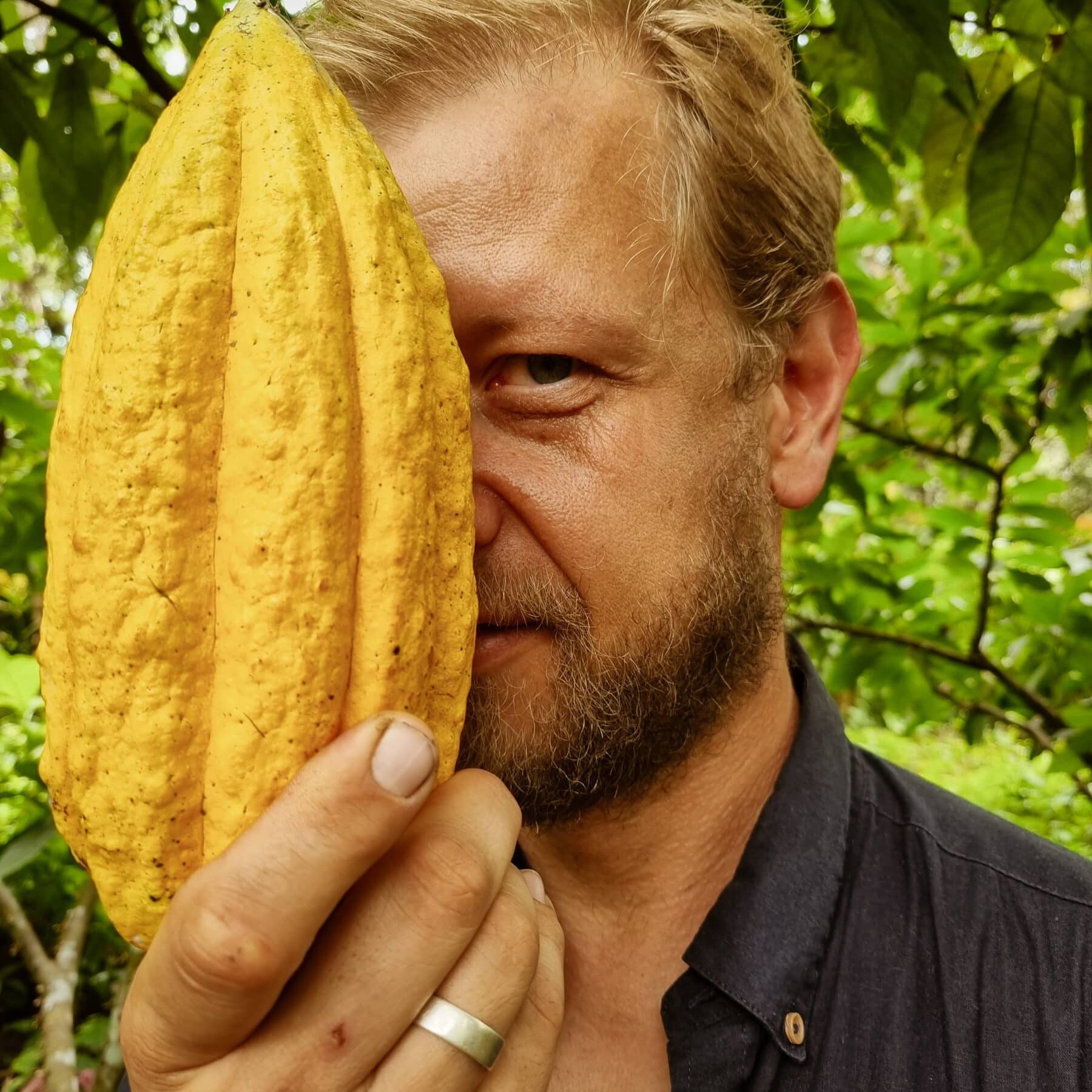
support of the indigenous people
One of the main aims of the project is to help the people of the Zoque and Tzotzil tribes who live in the rainforest area between the provinces of Chiapas and Tabasco. The hard-working cocoa farmers are self-sufficient, ie they grow many other foods in addition to cocoa in order to feed their families. The indigenous families have lived through decades of low cocoa prices and poverty, not least because of the low prices of industrial cocoa cultivation. Today, Hugo and his team train the cocoa farmers on the topics of cocoa cultivation in ecological and sustainable mixed cultivation, which increases the value of the cocoa. In addition, the project supports the farmers in selling their cocoa at fair prices. The farmers are offered better prices for their cocoa and they save themselves work through the direct trade supply chain initiated by the project, which guarantees high and stable cocoa prices for the farmers. In this way, the life of the local population is improved in the long term as cocoa prices rise again. The Zoque and Tzotzil tribes have traditionally cultivated the ancient cocoa varieties for thousands of years, which is a ceremonial cocoa of aromatically unique quality. Three villages are now participating in the sustainable cocoa project Agrofloresta Mesoamericana, The Tabasqueno cocoa of our Mellow Magic Cacao is sourced directly from their farmers.
Get to know the farmers and the people behind our cocoa and click through the slides:
Environmental protection through cocoa cultivation
The project is not just about preserving rare fine flavor cocoa varieties and supporting the small farmers living there, but also about protecting biodiversity in the rain forests. The primeval forests of the Zoque and Tzotzil tribes in the Selva Zoque disappear. Cocoa projects like this raise the local cocoa price and actively convert cleared pastureland back into traditional mixed forests. While zoque and tzotzil farmers can improve their livelihoods by selling cocoa, growing in mixed forests also protects endangered animals such as spider monkeys and jaguars. The cocoa mixed forests serve as buffer zones to the border of the primary rainforest areas. Of the tabasqueno- Cocoa is grown in tree nurseries and then planted out in the various cocoa forests. In 2019 alone, 62 hectares of barren grazing land were planted and converted into species-rich mixed forests with a rich flora and fauna. This work promotes biodiversity, soil health and carbon sequestration.
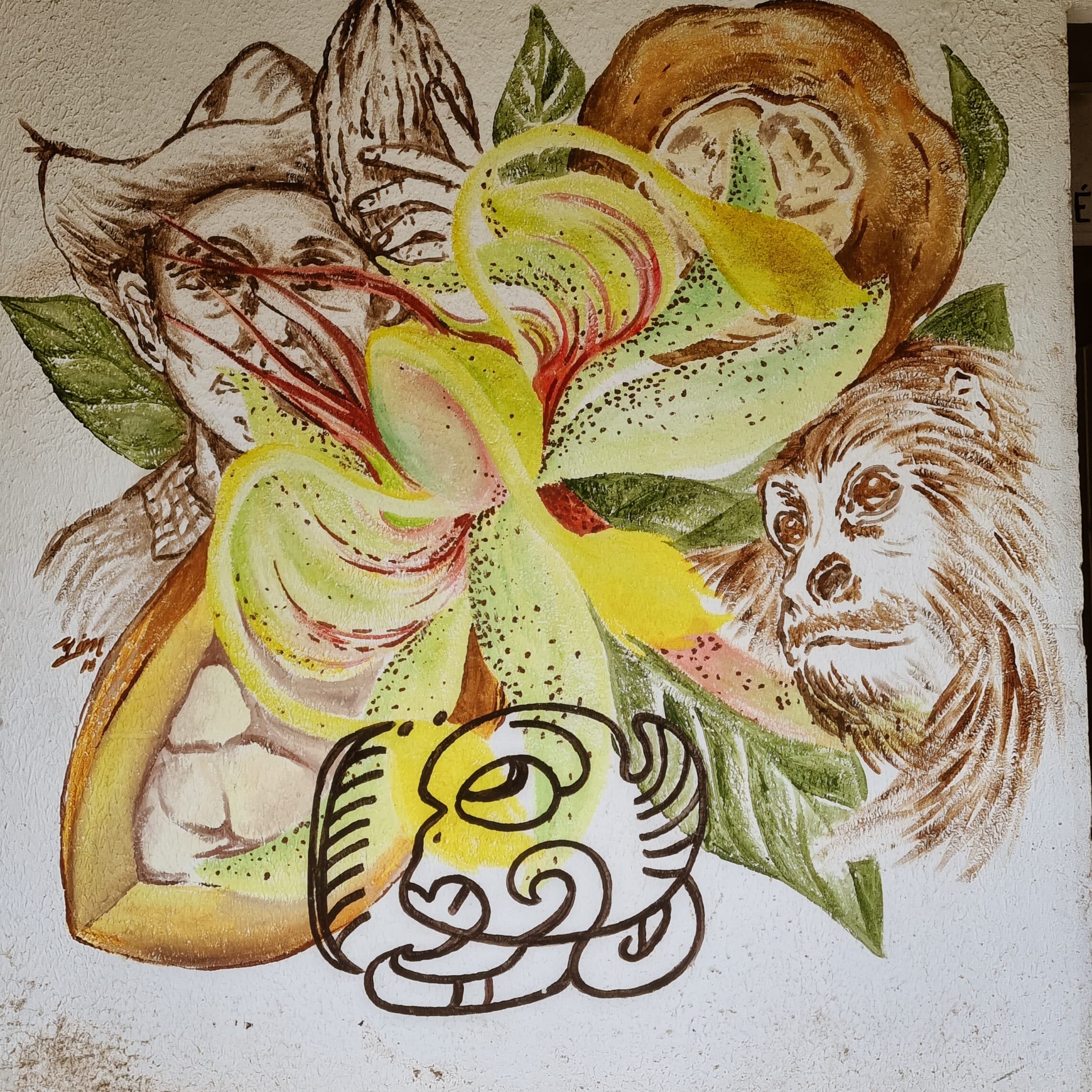
The painting shows the values of the Agrofloresta Mesoamericana project: The Maya sign below stands for the origin, for the old traditions and the preservation of the cultural heritage. The monkey stands for the protection of endangered animal species. The cocoa fruit for the love of the sacred plant and its ecological cultivation. The farmer stands for the local people who want to support the project and the flower stands for the love for nature and for Mother Earth, who nourishes us all.
From harvest to bean - an overview
- Surname: Selva Tabasqueno
- Origin: Sierra Madre de Chiapas, Northern Chiapas and Southern Tabasco Province, Mexico
- Variety: “Tabasqueño” Acriollado landraces. The beans are called tabasqueño.
- Flavor: Mild and harmonious. Notes of spices, cocoa and sweet fruits
- Rarity: Very small harvest quantities & manual work
- Harvest: September-November
- Terrain: Forest-covered mountainsides down to lush plains. Cacao grows in an agroforestry system with a high biodiversity including annato, chilies, breadnut and allspice
fermentation and drying
The wet cocoa beans with their sweet pulp are bought directly from the villages of the indigenous tribes and then taken to the fermentation plant. This is where fermentation, gentle drying, quality control and taste analysis take place. The beans usually ferment in Tabebuia wooden boxes for five to six days. The sugar content is measured upon receipt. The temperature of the beans and the atmospheric conditions are constantly monitored. The beans are dried on elevated trays and slow sun drying takes place in tunnels.
- degree of fermentation: 90 % on average of fermented and semi-fermented beans
- Humidity: 7,5 %
- bean size: 107g / 100 beans
- Certifications: Organic farming & fair trade
Follow the process from harvest to bean yourself and click through the slides:
Thanks to Agrofloresta Mesoamericana
Thank you that the project is changing the world positively bit by bit through its work. Our very special thanks also go to Hugo, who guided us through the production facility and the cocoa farm, sharing his vision and deep thoughts with us, as well as images and basic data.
We hope with the sale of ours Mellow Magic Cocoa to be able to support the project and Hugo's vision by bringing the diverse world of cocoa into your home - so that you will love it as much as we do.
